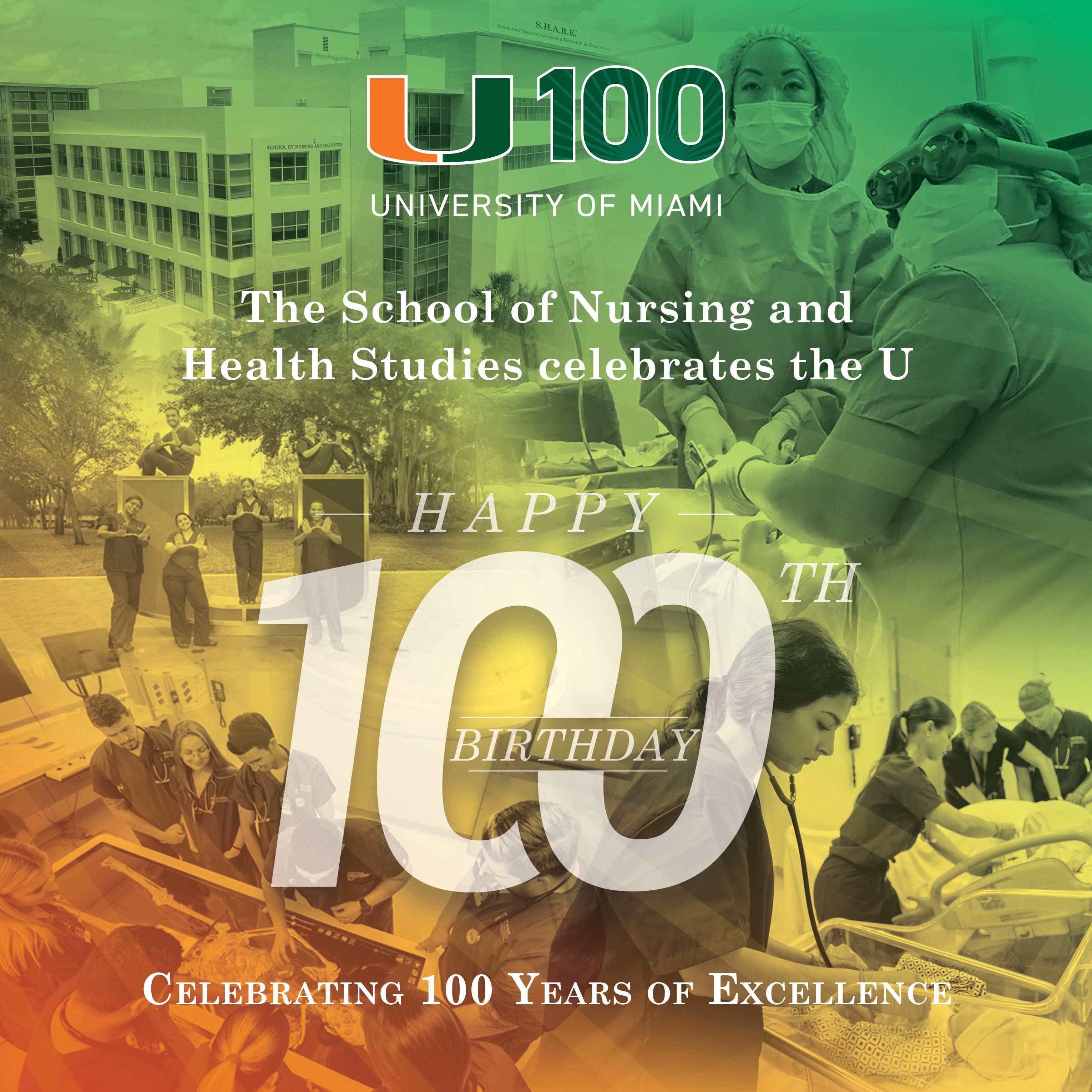The Miami Hurricane





By Jenny Jacoby Editor-in-Chief
It all started with a 160 acre plot of land, a $10 million donation and a dream.
“Miami should and can have a university, and the ideal place for it is at Coral Gables,” George E. Merrick announced in an advertisement on December 18, 1921.
Merrick’s ambitious optimism was generational. He was born to two-college educated parents that took a risk moving to the young City of Miami. When they arrived, his mother, passionate about supporting her children’s education, opened a school on their property and enrolled ten students.
It’s no wonder then that when Merrick set out to establish a city, he wanted a university to define it.
Within three weeks of UM being awarded its
By Lauren Ferrer Managing Editor
By Keira Faddis Staff Writer
charter, the city of Coral Gables was incorporated, setting the stage for the next century of educational pioneers.
At the time Merrick declared his desire for a university, there were only 42,000 residents in all of Dade County, now known as Miami-Dade.
As of fall 2024, 40,500 people call UM home. More than half are faculty, the rest are a mixture of undergraduate and graduate students.
On April 8, 2025 UM celebrates the day its charter was granted. A celebration that against all odds, the University of Miami was able to persevere, climbing so high as to have once been one of the top 40 universities in the country, according to the U.S. News and World Report.
“One thing is clear: From the beginning this institution has attracted the uncommon confidence and support of visionary people,” Edward Foote wrote in his 1987 Annual Report.
For all intents and purposes UM should have
failed before it even began.
Less than a month out from the first day of class and already behind construction schedule, 150 mile per hour winds ripped through Coconut Grove into Coral Gables.
What followed was worse. Florida’s land boom had evaporated and the Great Depression was underway. There could not have been a worse time to get a university on its feet.
Faculty worked without guarantee of a salary and students endured “cardboard” accommodations in incomplete buildings. Had it not been for the innovation of Bowman Foster Ashe, the first president of the university, UM would not have survived its funding deficit.
According to environmentalist Marjory Stoneman Douglas, supporters of Ashe’s vision were so committed that they were “willing to gamble their lives” to help lay the foundation for a school with the potential to become great.
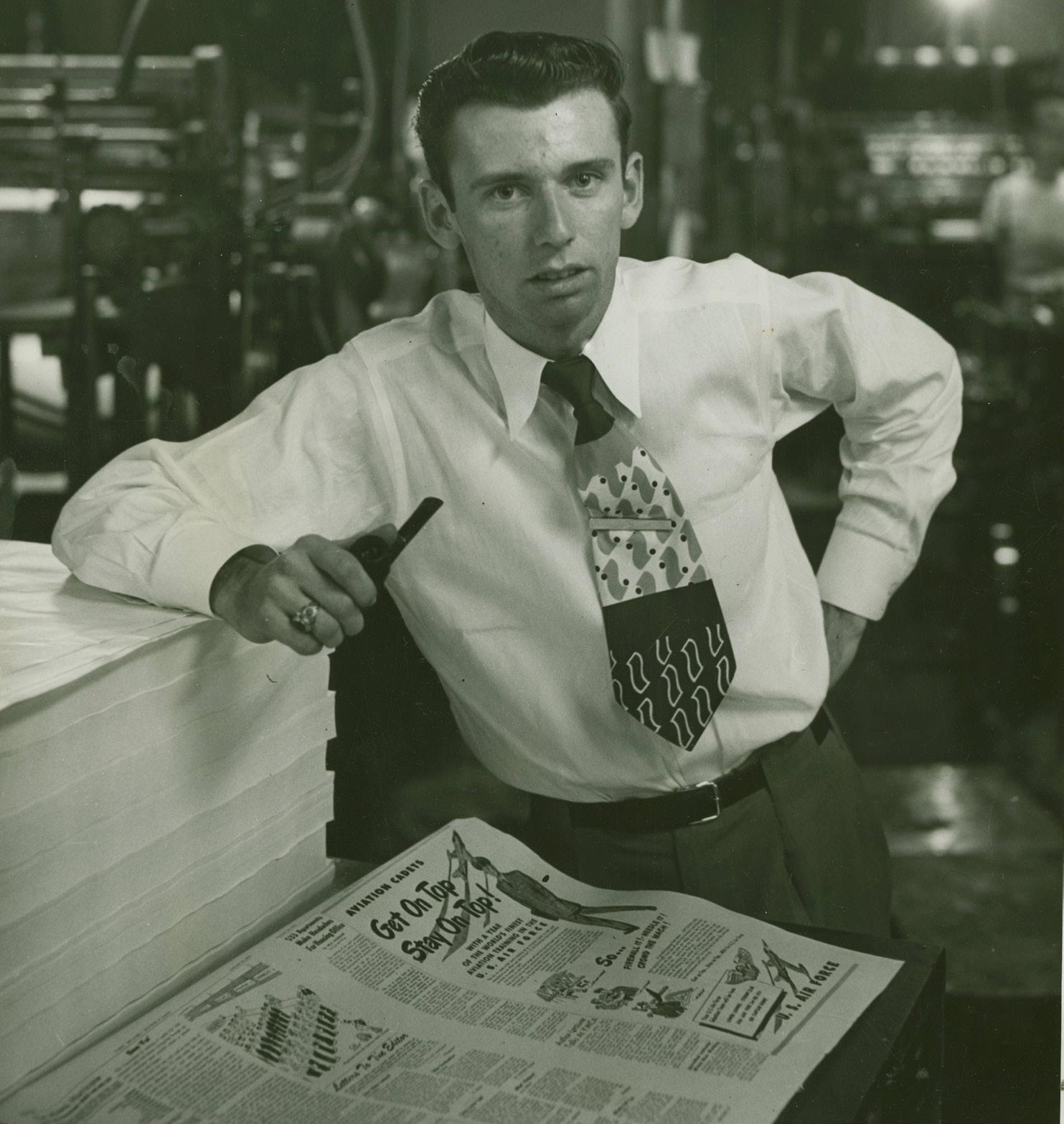
“Proud as I am of what has been accomplished for Miami in Coral Gables, I am prouder of this University beginning than of everything else put together,” Merrick said.
“For years, I have hoped and worked for this day, and even though we are just starting in this work, I am sure it is in the hearts of all Miami that this good start is to have year after year such a bigger and broader culmination as can be limited only by our dreams.”
Under fireworks, on Lake Osceola’s steps overlooking the campus, UM will ring in its 100th birthday, a commemoration of more than 200,000 graduates, some of the best moments in sports history, groundbreaking research and medical innovations and the dedication that has defined what it means to be a ’Cane. Merrick — a legacy of innovation and education — we can confidently say that there has been no limit to your dream.
By Editorial Board
By Sports Staff
Frost School alumni concert, hosted by TV host and alum Jason Kennedy. What Fireworks Show When 8:30 p.m. Where Lake Osceola
By Keira Faddis Staff Writer
For some people, the decision to attend UM is about more than getting a degree. Legacy students get the unique opportunity to learn in the exact spaces their loved ones did decades ago.
When Hannah Kuker, a senior finance, legal studies and studio art major, sat in one of her sophomore year finance classes, her professor, Seth Levine, was hit with a strong case of deja vu. It did not take long for Levine to realize he taught Kuker’s
By Avery Simon Contributing Writer
When students pass by the Frost School of Music, visit the Lowe Art Museum or hear about accolades at the Miller School of Medicine, they’re walking through the legacy of three families whose names have become synonymous with the University of Miami.
Behind these buildings are stories of generosity that have defined the U and shaped its commitment to music, art and medicine.
The music school was one of the two schools that opened with the University of Miami in 1926. However, it was not until 2003 that Phillip and Patricia Frost donated $33 million to the School of Music. This was the largest gift ever given at the time to a university-affiliated music school across the country.
“We have always felt that music is one of the elements in the culture of our society that moves people to do great things, and it’s one of the arts which has always deserved a lot more support than it has received,” Frost said in a statement to the Sun Sentinel in 2021.
The Frost family also established the Abraham Frost Endowment, which funds the commissioning of new works every two years, further strengthening the school’s dedication to the creation, performance and recording of original music.
In 1951, Joe and Emily Lowe underwrote the funding for the creation of the art museum at the University of Miami. Their donation of $100 million led to the official opening of the Lowe Art Gallery on Feb. 4, 1952. The Lowe family also helped acquire collections of non-Western Art, including pieces from Asia, Ancient America and Africa.
The building? site? was renamed the Lowe Art Museum in 1968 and became the first museum in Miami-Dade County to receive professional accreditation from the American Alliance of Museums in 1972. The museum was recognized by the State of Florida as a major cultural institution in 1985 and has continued to expand throughout the years as a beautiful place for the university community to come and visit.
One of the most generous donors to the University of Miami is the Miller family. Over the years, the Miller family has donated over $221 million to the school. As the Miller family’s primary goal was to enrich the medical program, the name is now recognized alongside the accomplishments of the medical school.
The school was renamed to the Miller School of Medicine in recognition of the 100 million dollars that the family of Leonard M. Miller donated to the school in 2004. Miller, former president and CEO of Lennar Corporation, made the donation with the intention of supporting innovative medical research, improving patient care and training future generations of physicians.
“Our family couldn’t be prouder of our commitment to the university,’’ Stuart Miller said in a written statement to the Miami Herald in 2015. This massive donation supported innovative research in fields including cancer, diabetes and neurology. It also allowed for expanded staff and student assistance and overall improvements in the school’s facilities.
The Miller family also supports the medical school with initiatives and scholarships that help the school strengthen its reputation for being one of the top institutions for medicine.
“We felt our gift was a significant way to continue the advancement of the UM Medical School enterprise that is such an important segment of our community and to honor president Shalala’s many contributions to the university and our community,” Miller said.
mother almost 30 years before in a course to help her become a certified public accountant.
“He recognized me before I said anything about it, as he remembered my parents dating,” Kuker said. “He knew them both and put two and two together via my appearance and last name.”
Her parents, Galite Kuker, class of ‘93, and Seth Kuker, class of ‘92, met and started dating while they were at UM pursuing undergraduate degrees.
“Galite was my Spanish tutor,” Seth said. “We were friends first, but I asked her to be my Spanish tutor. That’s how we became better friends.”
When Galite realized Seth was struggling in his class, she knew she could step in to help him.
“I was really good with foreign languages, and Seth was struggling,” Galite said.
Just as Seth and Galite met on campus, Seth’s parents, Howard and Diane, also started dating after meeting in the 1960s while pursuing their undergraduate degrees at UM. Both are double ’Canes who graduated from UM Law School in 1971 and 1975, respectively.
Russ, Seth’s brother, is also a double ’Cane, who received both his undergraduate and medical degrees at UM.
30 years later, Hannah is not the only Kuker currently studying at UM. Her younger brother, Joshua, and her younger sister, Leah, are in their sophomore year.
“We’re very traditional as a family, so it’s not that we expected all three of the kids to end up there for undergraduate, but it actually keeps in line with the tradition in us,” Galite explained.
While the Kuker story is not one you hear every day, it is something that other legacies, like the Karlinsky family, can relate to.
When Neal Karlinsky had to choose a college, picking UM felt like a no-brainer. His father Lee Karlinsky, uncle Fred Karlinsky, and grandfather Richard Furman, all UM alumni, were people he always looked up to.
“Going to UM was a dream because of how much I admire these three men and how UM helped launch their success,” Neal said. “I feel so lucky to be able to pave my own way, while getting to walk in my dad, uncle and grandpa’s footsteps at the U.”
His dad, class of ‘92, and uncle, class of ‘89, were both resident assistants during their time as ’Canes. Fred and Lee also led Alcohol Awareness
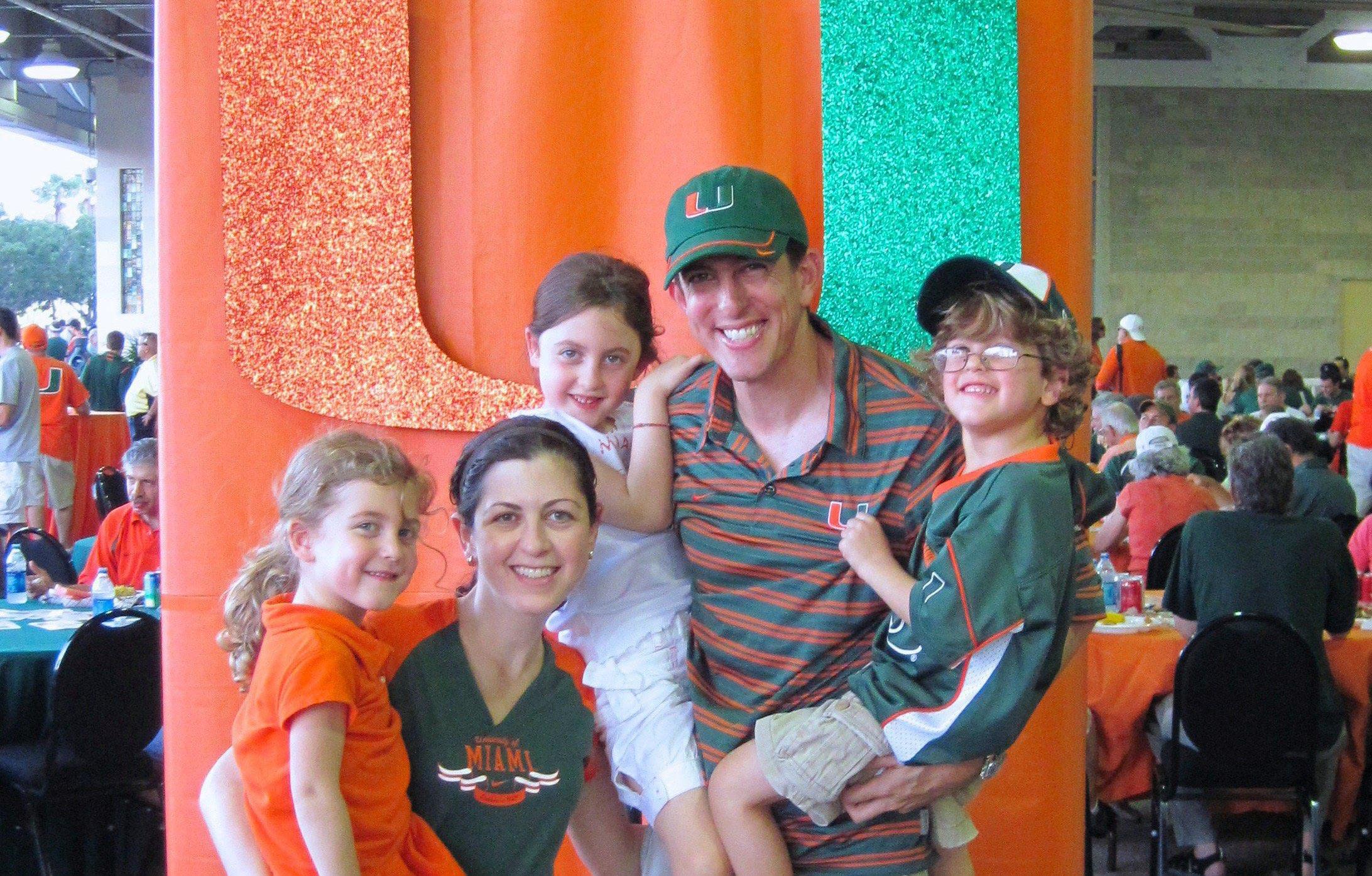
Week as Budweiser “Bud College Beer Reps.”
Neal and his younger brother Liam had been invested in the UM community for as long as they can remember. Growing up, they attended Mini ’Canes Camp, a sports camp the University offers every year.
Liam joined Neal as a ’Cane this spring, with the brothers sharing the UM campus for the first time since they attended camp as kids. Seeing his sons continue in the same path he and his older brother chose has felt special for Lee, the boys’ father.
“Having both my children attend University of Miami has been a gift for our whole family,” Lee said. “My older brother and I attended the University of Miami when we were younger and it was an amazing experience. We were both in the same fraternity, Sigma Phi Epsilon, and now my kids are both in the same fraternity, Alpha Sigma Phi.”
Seth and Galite Kuker also expressed the great warmth and pride they feel when they think about their continuing family legacy. Every time they come to visit their kids, they are filled with memories from the days they walked the same paths together more than three decades ago.
“I’d say [UM is] completely different because it kind of is, but in the same breath, it’s the same, but it’s really incredible to watch it grow.”
“The school has come a long way since my parents went there, even from when my wife and I were there to now,” Seth said. “I’d say it’s completely different because it kind of is, but in the same breath, it’s the same, but it’s really incredible to watch it grow.”
The heart of the U: Dr. Patricia A. Whitely’s 43 years of presence
By Lauren Ferrer Managing Editor
While four presidents have led the University of Miami, one steady presence has remained behind the scenes through every transition: Dr. Patricia A. Whitely.
Since arriving at UM in 1982, Whitely has become one of the University’s longest-serving and most beloved leaders. Now the senior vice president for student affairs and alumni engagement, she is in her 43rd year of service.
“She changed my life,” said Associate Vice President for Student Affairs Richard Soboram, who first met Whitely as a freshman in 1987. “I came here with a thick Jamaican accent and no expectations. She saw something in me. Invested in me. Pushed me. And it changed everything.”
Those who know her will tell you that she built her legacy by showing up.
“She’s present, she’s responsive, she’s everywhere,” Dr. Renee Callan, assistant vice president for student life, said. “You’ll be at an event and suddenly realize, ‘Of course, Dr. Whitely’s here.’ She makes the time.”
In 2017, the Faculty Senate recognized Whitely’s legacy with the James W. McLamore Outstanding Service and Leadership Award, which recogniz
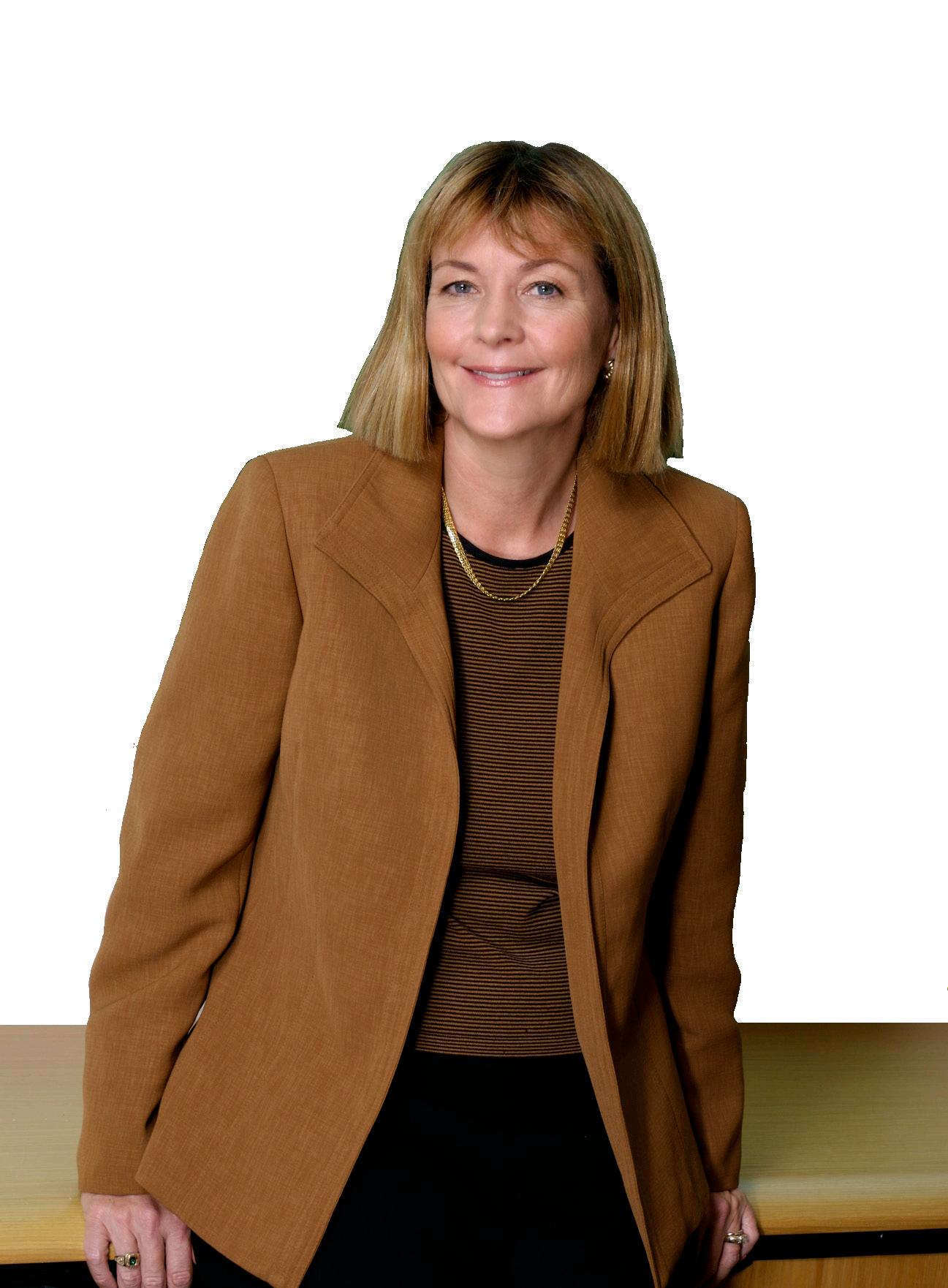
graduate experience at St. John’s University, and someone told me ‘You could do this for a living.’”
In those early years, she helped convert Stanford, Eaton, Mahoney and Pearson into the University’s first residential colleges. By the time she became vice president for student affairs in 1997, she had weathered Hurricane Andrew, served as director of student life and earned her doctorate from UM.
Since then, her influence has been felt in every corner of the University.
“She is the most foundational leader we have,” Callan said. “When I think of the University of Miami, aside from Sebastian, the next face I think of is Dr. Whitely.”
She’s helped shape the most visible and personal spaces on campus, including the Wellness Center, Lakeside Village and Centennial Village. From founding the Student Affairs Crisis Coordinator Program to quietly covering hotel costs for students in crisis, her impact is not just institutional. It’s deeply human.
“She’s not just part of the University. In many ways, she is the University.”
Erin Kobetz
Senior Associate Dean for Health Disparities
“She used to personally go to the hospital every time a student was admitted,” Soboram said. “That was her standard. And if a student didn’t have housing, she’d put them in a hotel — even if it hurt the budget. She once used her own credit card to help a student get home in an emergency. Before there was an emergency fund with her name on it, she was the emergency fund.”
It’s a sentiment echoed again and again by those she’s mentored.
“What you see is what you get,” Soboram said. “There’s no pretense. She genuinely cares. And, she expects us to care, too.”
That expectation has created a ripple effect of student-centered leadership across higher education professionals at UM. Dr. Whitely’s mentees have even gone on to lead student life divisions at universities across the country. Brandon Gross, a former UM Student Government president, now serves as an Assistant Vice President at Wayne State University.
“She changed my life,” Gross said. “I didn’t even know I wanted to work in higher ed. She helped me find that path. She gave me tough advice when I needed it, like when she told me, ‘Sometimes you have to move out to move up.’ I didn’t want to leave UM, but she was right.”
Still, she never sought recognition. For example, the Patricia A. Whitely Emergency Fund and the Unsung Hero Award that both bear her name were never her idea.
“The University community named those,” Gross said. “That speaks volumes.”
According to those she crosses paths with, what Whitely has built with purpose is a culture of presence.
“I hold most of my meetings at Starbucks now,” Whitely said. “During COVID, I realized students felt more comfortable outside my office. So I meet them where they are.”
Part of that experience now includes “Pancakes with Pat,” a tradition Whitely started in 2017. No agenda. No speeches. Just pancakes and presence.
“It’s simple,” she said. “But it matters.” So does senior reflections, the four-week seminar she personally leads each spring for graduating seniors.
“I participated in a capstone course like it when I was an undergrad,” Whitely said. “I never forgot how meaningful that was. I wanted to bring that same experience to our students.”
If the McLamore Award honored her official role, these moments speak to something less visible but just as important: the way she holds this place together.
“She’s not just part of the university,” Kobetz said. “In many ways, she is the university.”
Putting the student experience first Whitely has also been a steady presence through some of UM’s hardest moments. During the COVID-19 pandemic, she co-led the University’s response alongside Kobetz, coordinating with then-President Julio Frenk and UHealth to safely reopen in fall 2020.
“I came back to the office after just two weeks of working from home,” Whitely said. “I sat here, alone, for five months. We had 2,700 students who left belongings behind. We shipped boxes to all 50 states.”
She also oversaw the transformation of parts of Eaton into isolation housing. When students asked for hotel-style amenities, she made runs to Target herself, buying bedding and toiletries.
“Small changes like that mattered,” Whitely said. “It wasn’t just about reopening, it was about reopening well.” That sense of care has defined every chapter of her career. She’s shown it in disaster management during Hurricane Andrew, in overseeing the university’s response to tragedies and in fielding late-night calls from students and parents.
“She informs the president, the provost, the trustees. She delivers the news. She makes the calls. And she shows up,” Callan said. “Not everyone does, but she always does.” Even now, as she helps lead UM’s Centennial celebration, Whitely is thinking about students first.
“We chose alumni to speak at commencement this year,” Whitely said. “Because if you don’t showcase your own, who will?”
In the past 43 years, Whitely has worked under four university presidents—Edward Foote, Donna Shalala, Julio Frenk, and Joe Echevarria—and each one expanded her role. As of 2023, Whitely oversees Alumni Engagement, making her a bridge between generations of ’Canes.
“She remembers everyone,” said Callan. “Names, years, majors. It’s uncanny.”
But ask Whitely what she hopes her legacy will be, and she pauses.
“Student engagement. Student experience. The power of presence,” Whitely said. “These roles are temporary, but I hope that culture of care continues long after I’m gone.”
By Casey Servatius Contributing Writer
Women at the University of Miami have not always been at the forefront of leadership. Their progress is the result of decades of advocacy, dedication and efforts, which has set a foundation for generations of women to come.
UM was founded as a coeducational university in 1925, and 646 men and women made up the first fully registered class. Regardless, it took years for women in faculty to feel recognized at the university.
Dr. June Dreyer, PhD, a professor of political science, began working at UM in 1979.
“I was only the second female full-time professor,” Dreyer said. “The other, named Margaret Mustard, was I believe in the Biology Department and had been at UM since the days of ‘Cardboard College.’”
According to Dreyer, it was difficult for women to be taken seriously in a strong academic environment, despite their impressive backgrounds and accomplishments. Before coming to UM, Dreyer was a Far East specialist for the Library of Congress and an Asia policy advisor to the chief of naval operations.
“I had a difficult time even being addressed as Doctor or Professor Dreyer,” she said. “Since my husband also taught here, I had to remind people that I had a doctorate, too.”
Many aspects of student life, like residential colleges and honor societies, were separated by gender at UM until the 1970s and 1980s. Mahoney Residential College was exclusively for men until it was connected to Pearson Residential College in the early 1970s when the two residence halls transitioned to coed living.
The Iron Arrow Honor Society, the highest honor attained at UM, only admitted men until 1985. Prior to this change, Nu Kappa Tau was the highest honor society for women.
Over the course of the University’s century of history, women have made their presence known in other male-dominated academic and athletic pursuits.
Maria Teresa Giammattei, Margarita C. Giammattei and Sherman Hoffman Kilkelly were the first women to graduate from the College of Engineering only five years after it was established in 1947. Today, the College of Engineering is made up of 37% female students, according to UM News, whereas nationally, only 22% of undergraduate engineering degrees are earned by women.
In 1973, UM became the first major university nationwide to offer athletic scholarships to female athletes.
Golfer Terry Williams received a $2,400 athletic tuition waiver just nine months after former President Nixon signed the Education Amendments Act. This included Title IX, which enforces gender equality in high school and college educational programs, as well as athletics. Before Williams, women only participated in recreational sports.
As of fall 2024, UM has 230 male athletes and 250 female athletes.
“The coaches don’t take any incidents lightly when it comes to sexual assault,” Eloise Stuart, a freshman cross country and track and field athlete, said. “Female athletes here feel really supported if they need to come forward about something.”
Kelsey Greer, a first-year student on the cheer team, conveyed the importance of leaning on her fellow female teammates for support.
“We all cheer each other on,” Greer said. “A win for one of us is a win for all of us.”
In 2020, UM announced a Flagship Initiative for women and gender equity. The project examines the current leadership positions held by women and develops ways for UM to further support female students and faculty.
Shortly after, UM established the Public Voices Fellowship in 2021. This fellowship year allowed 20 women and minority members to focus on conducting research and gaining recognition in their respective fields.
Most recently, the Steven B. Schonfeld Foundation established a scholarship for female students studying STEM at the University of Miami. In 2024, the scholarship was offered to four sophomores, and the foundation will continue to sponsor female computer science students for the next eight years.
Still, instances of inequality have been reported, particularly when it comes to faculty pay. According to the Miami New Times, within the school of medicine’s clinical division, male faculty are being paid 25% more than their female counterparts. Additionally, as stated by Forbes, other cases of gender-based pay discrimination are ongoing at UM, such as female professors making $8,500 less per year than male professors with a lower rank.
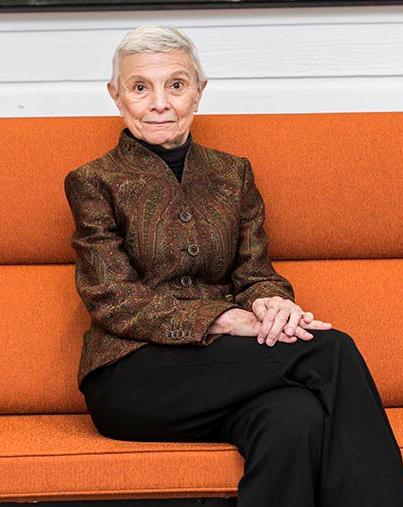
By Emil Salgado Vazquez Staff Writer
At the front of the classroom, Dr. Mitchell Shapiro takes his stand, ready to deliver yet another lecture at the University of Miami Communication School. Today, he may be teaching about the ethics of journalism; tomorrow, it could be a presentation on the history of mass media mixed in with fun facts about The Beatles.
Thousands of students have heard these lessons during Shapiro’s 43-year career at UM. As one of the longest-serving professors at the university, Shapiro has served under four UM presidents and played an instrumental role in establishing the School of Communication and developing it into what it is today.
“The school has grown leaps and bounds,” Shapiro said. “Our programs are recognized by other professors and deans around the country as some of the best, and that really works for the students who come here, which is what it’s about at the end of the day.”
From student to associate dean
Shapiro’s history with UM goes back further than his time as a professor. He was a ’Cane himself, studying at UM over 50 years ago when the communications department was a collection of programs within the College of Arts and Sciences.
He earned a Bachelor of Arts from UM, a Master of Science, and a Ph.D. from Florida State University. Shapiro started teaching at FSU and Illinois State University before returning to the University as a professor in 1982.
“The people running the College of Arts and Sciences brought me back here to run the broadcast and broadcast journalism programs,” Shapiro said. “One of the reasons they brought me back here was they wanted to become a school of communication within the CAS.”
However, the School of Communication would not be housed within CAS for much longer. Under the recommendation of Board of Trustees member
David Kraslow, the SOC became a separate entity.
Shapiro remembers facing opposition from the CAS, who would lose revenue from around 400 Communication majors pursuing degrees at the time.
“The CAS required that all our students had to take a second major in Arts and Sciences,” Shapiro said. “They didn’t really think that what we did was legitimate academics.”
Shapiro quickly became fond of the school’s first dean, Dr. Edward Pfister.
“He was the type of person I would describe as the ideal human to be a dean,” Shapiro said.
They would go on to establish a Doctor of Philosophy in Communication program together.
“When we finally presented it to the Faculty Senate, we were praised for having the best proposal they had ever seen,” Shapiro said. “They had immense faith in us that this would be a top program.”
Pfister’s arrival ushered in the creation of graduate programs, changes to departments and the focus on students getting a liberal arts education.
“All along this time, we were growing,” Shapiro said. “Not just in size, but in reputation. The SoC had gained a lot of respect among the faculty of UM, too.”
Over the course of his career, Shapiro has served many roles. He became the director of graduate studies in 1991, then transitioned to being the SoC’s academic associate dean until 2006 and currently is the director of honors.
don’t have to teach,’” he said. “I would say, ‘That’s what’s keeping me sane.’ When I went into the classroom, all my problems disappeared.”
Shapiro decided to step down as associate dean to focus on teaching full-time.
“Teaching keeps me young and inspired,” he said about teaching. “I was seriously considering retiring two years ago because of the pandemic and online learning. The last two years made it fun for me again.”
The SOC has given Shapiro an environment to educate unlike any other, occupied by exceptional faculty and students.
“It’s allowed me to live out my passion.” He said. “To learn and teach about the media. Just talking with students in my office keeps me young and helps me be a better professor.”
Many of Shapiro’s former students have kept in touch with him over the years, creating a Shapiro-network made up of the students who connect through him, reflecting the impact that Shapiro has had on so many people.
“Dr. Shapiro holds a special place in my heart because he cares about every single one of his students,” Chiara Ambrosini, one of Shapiro’s Honors students, said. “He goes out of his way to ensure our success and is a great professor along the way.”
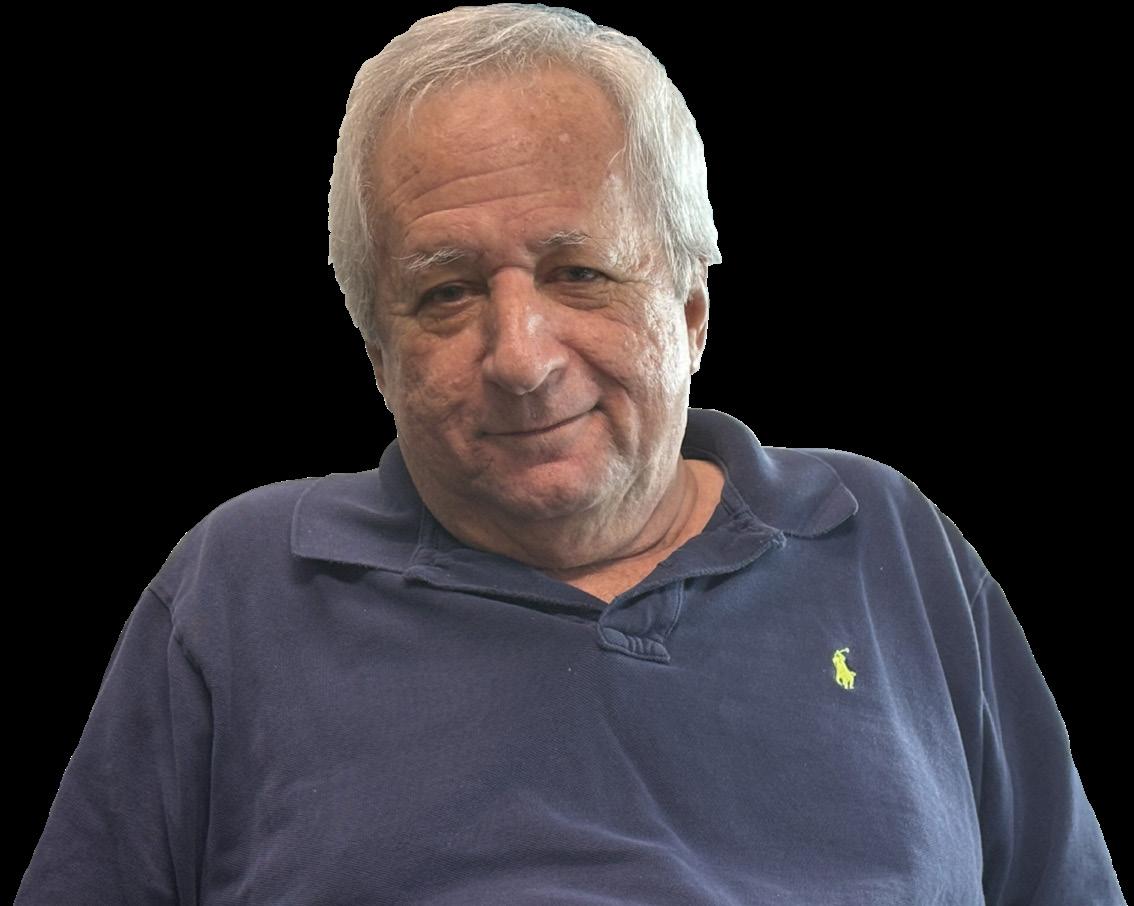
Shapiro has even had the opportunity to teach the children of his former students, making the net-
“My students are like family to me,” Shapiro said. “A student last semester mentioned to me that her mother was also my student. I keep a list of who I’ve taught and try to encourage them all to Those bonds created speak more than just Shapiro’s impact; it reflects his passion for teaching and hopes for the SOC’s future. “I’d love to see the SoC continue to thrive, and to grow in stature,” he said. “I don’t want to see us ever rest on laurels. I like teaching; I don’t look forward to classes ending. The day I stop loving to teach I will probably retire.”
By Jenna Simone Staff Writer
From a small collection of buildings in Coral Gables to a thriving hub of academics, culture and student life, each UM landmark tells a story of progress and tradition.
In total UM is encompassed by 213 buildings and more than 12,600,000 acres of property across its campuses.
These spaces have adjusted over the years to match the needs of the university. For example, Lake Osceola, the heart of today’s University of Miami Coral Gables campus, has not always been part of UM. It was originally a canal that connected terrestrial freshwater systems from the Everglades to Biscayne Bay and was developed into a lake as part of UM’s campus expansion in the late 1940s.
Due to its connection with other natural water bodies, wildlife began to inhabit the lake, including different kinds of fish and even manatees. The lake was named by the Iron Arrow Honor Society, UM’s highest honor society, in recognition of Osceola, a Seminole tribe leader and historical figure in Florida.
Today, students can be found relaxing by the lake eating Starbucks or Corner Deli, working on the nearby steps or even fishing.
“When I’m walking around campus in between my classes, I love seeing the lake and remembering why I chose this beautiful campus,”
Emma Paccione, a freshman studying finance, said. “I really don’t think campus would be as lively, or feel the same without the lake.”
Today’s landmarks
Across from the lake sits the Shalala Student Center, a 10year project that officially opened in fall 2013. Initially called the Student Activities Center, it was later renamed in honor of Donna Shalala, UM’s president from 2001 to 2015.
make way for the new Shalala Center, where the Rat would be relocated. The restaurant temporarily moved to the University Center before opening its current location on Aug. 20, 2013.
“That Rathskellar was not similar at all to the one we have now. It was limited to only students and faculty. There were concerts on weekend evenings,” Mitchell Shapiro, UM alum, professor and director of the School of Communication Honors Program said. “It was two stories. The first floor had a restaurant, and the second was only on the periphery with more seating and a stage where artists would perform.”
Today’s Rathskeller blends modern and rustic design elements to create a relaxed, student-friendly atmosphere. The Rat features indoor-outdoor flow, large glass windows and waterfront seating under umbrellas and palm trees. The interior features decorated walls, wooden furnishings and a pub-like ambiance.
Designed for social interaction, the space includes high-top tables, comfier couch seating and an open bar area, making it a central hub for students.
Notable buildings
Whether it’s due to an iconic architect or distinctive architectural features, several campus buildings have been deemed “notable” by the Department of Facilities Operations and Planning. These include the Oscar E. Dooly Memorial Classrooms, J. Nev-
a high school that bears his name, says sincerely, ‘I owed it to the community. And as long as I live, I am going to contribute to its welfare.’”
Designed by Miami architect Wahl Snyder, the five-story structure features a concrete-block first floor with frosted clerestory windows above. The southeast upper stories are screened by a distinctive metal grille made of diagonally cut cylinders, which covers a wall of fixed metal windows. On the northeast façade, pebbled panels and grouped metal windows define the exterior, while large concrete planters flank the stairs to the southeast entrance. Built in 1967, the James M. Cox Science Building maintains its original appearance and architectural significance. Its design adopts brutalist features, such as exposed concrete, angular geometry and structural transparency. The building also incorporates elements of the Miami Modern (MiMo) style, including mosaic tilework, attention to sun protection and seamless transitions between indoor and outdoor spaces.
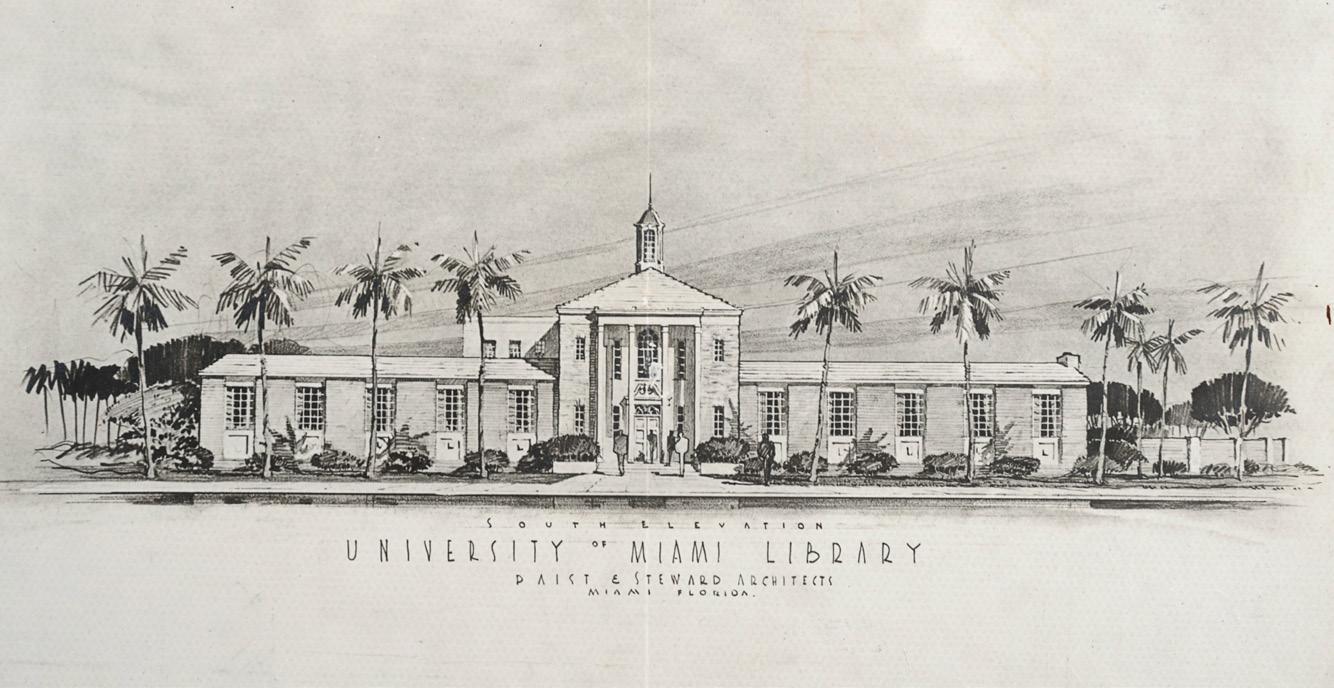
Funded by a $20 million gift from Bruce and Tracey Berkowitz, Shalala offers a 24-hour study space, student organization offices and a 1,000seat ballroom.
With its opening, student organizations also gained a dedicated space to establish private offices, instead of sharing facilities in the much smaller Whitten University Center.
Shalala’s sleek architectural style features clean lines, open spaces and large glass windows that provide natural light and offer scenic views of Lake Osceola. The building’s design encourages movement and interaction, with multiple terraces, meeting rooms and lounges that accommodate both social and academic activities.
The Rathskeller, UM’s on-campus restaurant and bar, opened on Dec. 18, 1972 as a stand-alone building. Originally housed in Gautier Hall, named after Charles Gautier, the late chairman of the Board of Trustees’ Subcommittee on Student Affairs, the Rat became a student-run business under the Dean of Students Office.
“Rathskeller” is a German term meaning “council’s cellar,” historically referring to a tavern or restaurant in the basement of a city hall or university building. The Rat continues that tradition, serving as a community gathering place on campus.
In June 2011, Gautier Hall was demolished to
ille McArthur Engineering Building, James M. Cox Science Building, Ashe Memorial Administration Building and the Otto G. Richter Library.
“I love walking towards Cox and seeing the beautiful double helix staircase designed to represent DNA,” Lucas Velasquez, freshman computer science major said. “It’s thoughtful and cool to see how they mixed science with architectural design.”
Constructed in 1947, the Memorial Classroom Building was the first permanent academic structure opened on the Coral Gables campus after World War II. Designed by Marion I. Manley and Robert Law Weed, the 680-foot-long building originally featured 58 classrooms across a two-story north wing and three-story south wing.
Between the wings stood the Beaumont Lecture Hall, which included a small stage and seating for 290 people. This space was later converted into the Bill Cosford Cinema. The building’s orientation is also a key design feature. Its classrooms face east to avoid direct sunlight after 9 a.m., helping to keep them cool.
Thanks to a $1 million donation from J. Neville McArthur, the engineering building bearing his name was constructed in 1959.
“The distinguished gentleman and civic leader, who gave a million dollars to the University of Miami for a School of Engineering,” the Miami Herald wrote about McArthur in 1961, “And 40 acres for
The Ashe Administration Building, named in honor of UM’s first president, Bowman Foster Ashe, symbolizes the university’s transition from the rapid post-war expansion era to a period of planned growth. Completed in 1954 and designed by Watson and Deutschman, the building includes a seven-story north wing connected to a two-story south wing. The north wing’s exterior features stucco and pebbled panels, with window bays inset among projecting piers and floor slabs, evoking the “egg crate” look of Eaton Hall. Its fenestration includes single-light metal pivot windows with porcelain-enamel and steel panels in the bays below. A wall of Oolitic limestone runs along the base of the first story. The south wing’s second story cantilevers over the first, and its exterior is clad in stucco. A continuous ribbon of fixed metal windows lines the upper floor, completing the building’s streamlined, functional aesthetic.
Historical landmarks
1300 Campo Sano is the only remaining building of “The Shacks,” a group of temporary wooden structures built to accommodate the post-WWII student boom at the University of Miami. Originally constructed in 1947 as one of five semi-permanent buildings made from army surplus materials, it served as the administration building alongside a cafeteria and three science buildings. Its design, influenced by early plans for the Dooly Memorial Building, featured exterior corridors, open porches and staircases that allowed each room to have windows on opposing walls, maximizing airflow in the days before air conditioning. Restored in 2013 to its original 1947 appearance, 1300 Campo Sano has since earned multiple awards for historic preservation. It is now home to the George P. Hanley As the University of Miami celebrates its centennial, today’s campus landscape is a testament to a century of growth, transformation and tradition. From Lake Osceola’s evolution to Centennial Village’s creation, each landmark reflects UM’s commitment to innovation while preserving its rich history. Over the next 100 years, one thing is sure: UM will continue to shine, evolve and inspire future generations.
By Lauren Ferrer Managing Editor
A maze of scaffolding and cranes greeted student media on Tuesday, March 19 as the group was guided through the University of Miami’s largest active construction site, Centennial Village phase two.
Guided by project leaders with Coastal Construction, the group got a close-up look at the three new residence halls going up on the Coral Gables campus expected to open in August 2026. The project marks the second phase of the University’s Centennial Village student housing initiative, which aims to modernize and reimagine the first-year residential experience.
“Everything is at a different stage,” Senior Project Manager Lonny Shnur said. “Some buildings are still getting windows. Others are already working on interior framing.”
The site includes two new buildings, labeled 2A and 2E in internal documentation. Building 2A, which includes two towers connected by a bridge closest to the Frost School of Music, will stand eight and ten stories tall, while 2E, near the Herbert Wellness Center, will have nine floors.
Combined, the three towers will house 1,149 beds across 660 rooms. The design emphasizes shared spaces, with every floor featuring study rooms, lounges and communal bathrooms. Each tower also includes a meditation room, faculty apartments and administrative spaces for Housing and Residential Life staff.
Each building also includes HRL administrative spaces on the ground floor, including offices, conference rooms and student staff areas.
One unique feature of the new phase is a bridge on level seven that will connect two of the towers, an architectural element that distinguishes this project from phase one which focused on the new dining hall.
“Each project has its own challenges,” Assistant Superintendent Michael Perez said. “For phase two, the chill beam units keep getting delayed by manu facturers. That’s held us up on finish ing interiors.”
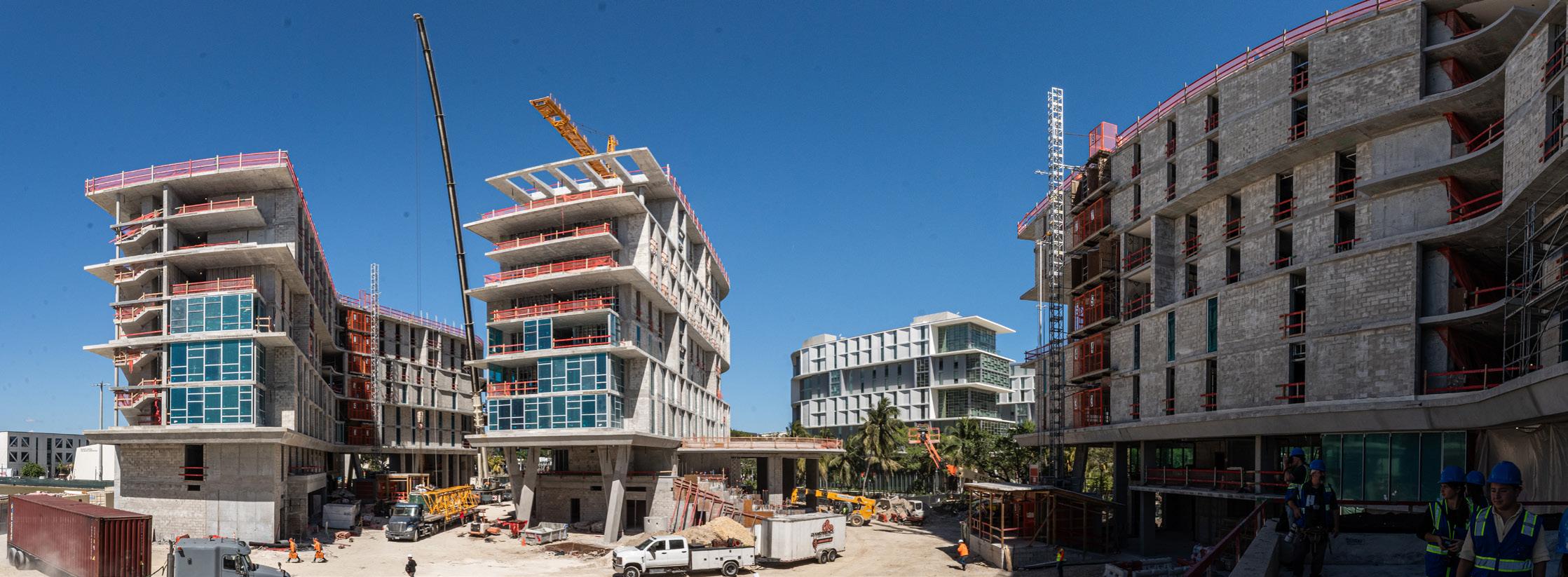
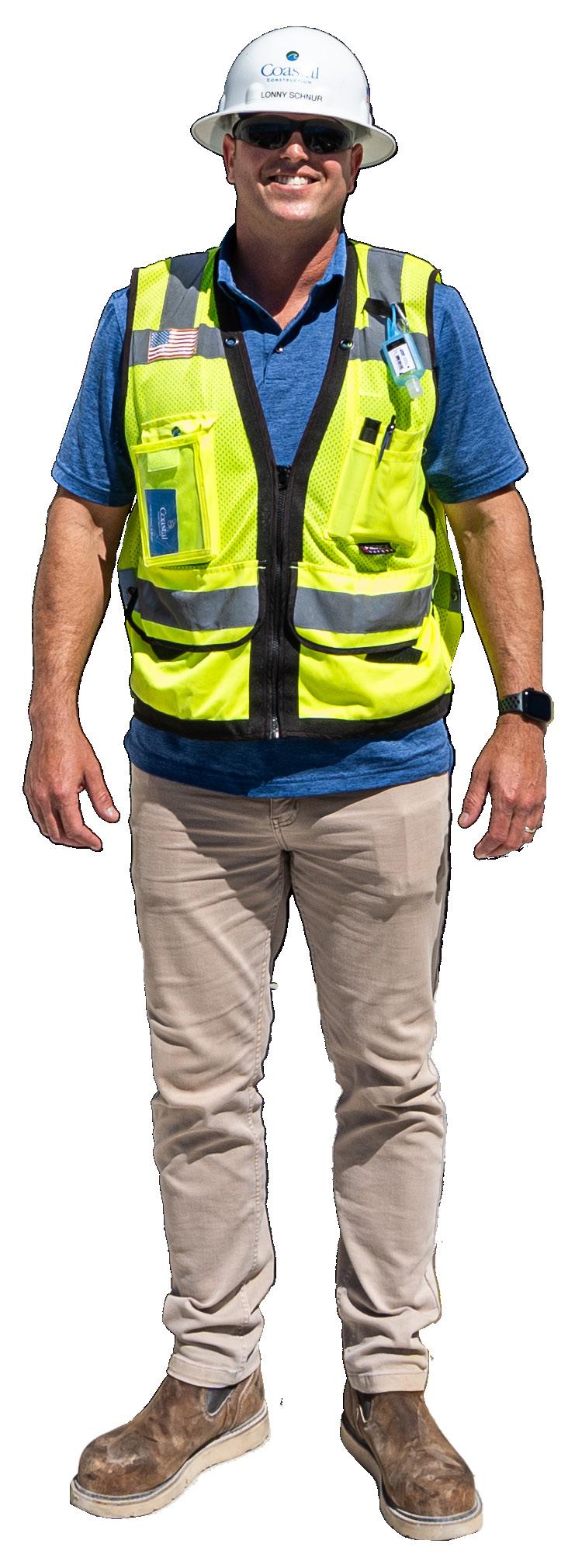
To compensate for delays, the crews have been working long hours, often from 5 a.m. to 7 p.m., building morale through weekly team barbecues
Everything is at a different stage. Some buildings are still getting windows.
Others are already working on interior framing.”
Lonny Shnur Senior Project Manager
and impromptu cookouts on Fridays.
“It’s brought us closer together,” Perez said.
“We’re all here to get it done.”
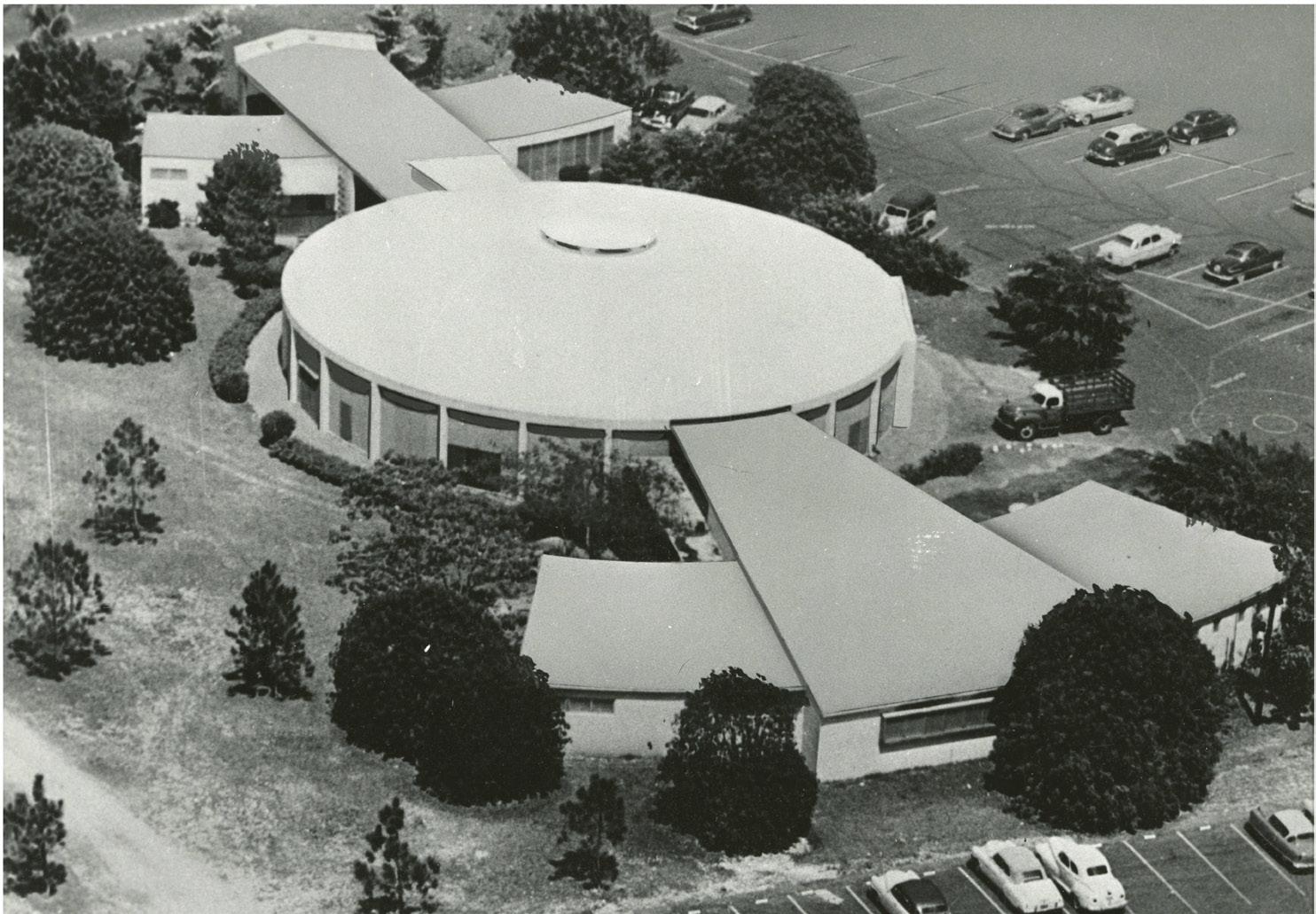
By Tracy Ramos Contributing Writer
When the Jerry Herman Theatre opened in 1951, heads turned, but not from the audience. It made national headlines for its circular design, which allowed spectators to sit in a ring around the stage.
Originally named the Ring Theatre, its design was inspired by the configuration of the rotunda in the Anastasia building. The building was a hotel that UM purchased to serve as its temporary home until the Merrick building’s construction was completed. Theater students performed in the Anastasia building after it was used to train WWII air navigators.
Even during the war, theater thrived on campus. In 1942, the Miami Herald covered a student production of the Mexican comedy, “Sunday Costs
Five Pesos,” at the then called University of Miami Theater. The play tells the story of a small northern Mexican town, Four Cornstalks, where women who fight on Sundays have to pay a five-peso fine.
Theater professor Frederick Koch Jr. spoke to the Herald, emphasizing the “need for arts in a war world.”
Performances moved to a circus tent until construction for the current facility finished in 1950.
After renovations in the 1990s, the theater had a 306-person seating capacity and was renamed after UM alumnus Jerry Herman. A Tony-award-winning Broadway composer and lyricist, Herman was known for “Milk and Honey,” “Hello, Dolly!,” “Mame” and “Dear World.”
In 2009, the theater department staged a production of “Hello, Dolly!” and received a heartfelt letter from Herman ahead of the opening night.
“I’d like everyone connected with Dolly to know that my heart is with you,” he wrote. “And what a special thrill it is to have it playing in my namesake theater. If you hear a strange voice singing along with the curtain calls – it’s me from Los Angeles.”
Joy Missey, a senior musical theater major, said
performing in shows with the arena seating configuration has enriched her education.
“Performing in the theater, which is one of the only theaters in the U.S. where audiences can sit around the stage, has taught me how to perform to people all around me,” Missey said. “It’s prepared me for performing in different settings after graduation.”
Graduating seniors have participated in the tradition of signing their names on the theater’s signature wall since the 1960s. E.V. Cummins, a senior musical theater major, is excited to add her name to the list.
“I’m really looking forward to leaving my mark on a space I’ve performed in so many times,” Cummins said. “I’m honored to have my name among so many notable alumni on the wall.”
Broadway actor Joshua Henry, known for starring as Billy Bigelow in the third Broadway revival of “Carousel,” and actress Dawnn Lewis, known for her role as Jaleesa Vinson–Taylor on the NBC television show “A Different World,” are among the names of alumni on the wall.
Ramanjaneyulu Doosari, assistant professor of theatre arts, said the theater is critical to the department and University’s futures.
“Without it, how can we teach students where we started as a program and where the University was decades ago?” Doosari said. “It’s important to remember our roots so we can see how far we’ve come.” Doosari also recognized the theater’s importance in the South Florida community.
“People going to live performances and not just watching entertainment on TV is important because of the human connection,” Doosari said. “For centuries, people have enjoyed the human connection in theater and that desire will never go away.”
The Jerry Herman Theatre’s not done making history yet. Check out its upcoming production of “Seussical: The Musical” from April 22-26, which draws from the worlds in Dr. Seuss’ books, “The Cat in the Hat,” “Horton Hears a Who!” and more. To purchase tickets, visit the Jerry Herman Theatre website.

By Martina Pentaleon Staff Writer
What started with just eight student leaders has grown into a powerful presence on campus. From the parking prices, to the cost of tuition and dining hall food quality, SG’s has played a role in shaping the student experience for a century.
This year, the student body elected Ivana Liberatore to continue this work as SG president, alongside her Brand New U administration, extending its legacy of advocacy.
For decades, SG presidents have left their mark. In 1967, Dennis Richard became the first independent candidate elected president and developed the proposal to establish SAFAC. Three years later, Ray Bellamy became the first Black student and student-athlete elected to the role. After a career-ending injury caused him to lose his athletic scholarship, he successfully advocated to the administration for the creation of student government chief executive officer scholarships.
“If through my work as president, I can extend the welcoming and accepting environment I experienced at UM to every student, it would be the greatest privilege of my undergraduate career,” sixty-sixth SG president Roy Carrillo Zamora said to the Hurricane when he got elected in 2024.
The organization Established in 1927 as the Student Association, SG was composed of an Honor Court, a Senate and eight executive board members: the president, vice president, secretary-treasurer and the secretaries of athletics, foreign affairs, publication, state, traditions and social affairs.
“I do solemnly swear that I will to the best of my ability, preserve, protect, defend, and enforce the provisions of the Constitution and Laws of the Senate and the Decrees of the Honor Court of the Student Association of the University of Miami,” a portion of the 1929 oath of office stated.
The Senate, representing the original 646 students in 1927, had three senators for the School of Liberal Arts, the School of Music, the School of Art and the School of Law.
With the expansion of student organizations, the number of chairs grew to represent all students on campus. By 1995, 31 student groups were represented with 38 senators. Two committees were added in 1981, and the Honor Court evolved into the Supreme Court.
The University Affairs Committee connected students with “dorm government”, similar to what the Campus Liaison Council and Senate Committee of University Affairs do today. The cabinet position for Organizational and Ethnic Relations interacted with other student organizations, combining the tasks that are now overseen by the councils.
Agencies
Starting in 2000, SG began adoption agencies to further enrich the student experience. Category 5 was established under SG president Shane Weaver to provide funding for student pep rallies. Today Cat5 is the award-winning student section, promoting school spirit at all athletic events.
ECO Agency was founded in 2012 to promote sustainable living on campus. However, sustainability proposals like the ad hoc committee for university recycling, created in 1995, have had a place at the University for decades.
During her tenure as UM president, Donna Shalala was known for bringing influential speakers like Justice Sotomayor and Dalai Lama. To continue the culture of bringing speakers to campus, SG president Evan De Joya established What Matters to U in 2018. Since then, influential leaders and celebrities including Josh Peck, Pitbull and Tabitha Brown have come to campus to speak to students.
Elections
The elections process has always been a part of SG, but was formalized in the ’30s to ensure fair and equitable elections. Students have always voted on the executive branch and senators, but the cabinet,
though, was appointed by the president.
Initially, members of the Elections Commission would hand count all of the ballots. Tensions began in 1981, when election results were put on hold because both tickets were almost disqualified. It happened again in 1986 due to complaints against candidates. By 1994, students claimed that some candidates were erased from the ballot.
The election processes were reformed in February 2000 due to allegations of fraud. Instead of voting throughout campus, students could only vote in the Breezeway.
“Elections should be fair.” said Chris Roby, the director of student activities and leadership programs in 2000. “The last thing we would want to do is declare elections invalid because it would be a waste of everyone’s time and effort.”
Advocacy
To make sure students were heard, SG used to hold weekly meetings where they would distribute a
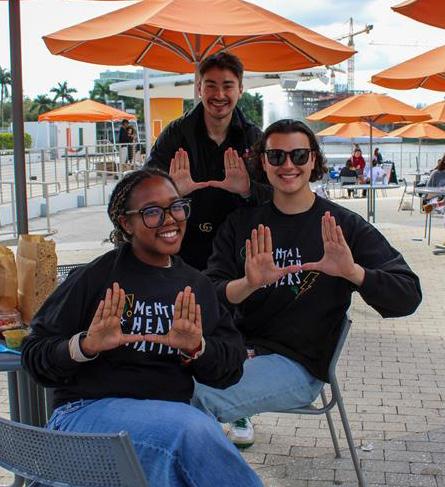
“Gripe Card” where students could give suggestions for improvements. Now, the “Gripe Card” has become “Share an Idea,” a survey available on the SG website.
Tuition has been a point of contention for students for years. SG’s efforts to stop a $500 increase in tuition resulted in a campus-wide protest in 1980, organized by SG.
During the fall of 2024, SG advocated for the expansion of Freebee, UM’s late-night transportation service. But before there were cars, there were Nightwatch Escorts. In 1981, SG sponsored the Nightwatch Escort Program, a service provided by the Student Security Patrol Office, which provided an escort from sunset to 1 a.m.
Following the death of a student who was hit by a car while crossing a U.S. 1 intersection in 2005, the Senate sponsored the bill to construct an overpass across U.S. 1. An overpass across U.S. 1 was created, improving student security.
The bill, which passed unanimously, was named the Ashley Kelly Resolution, “in memoriam of the death of Ashley Kelly in hopes that a tragedy such as hers should not be repeated for lack of action on the part of the University, its students and the greater community of Coral Gables.”
The University of Miami welcomed its first female president in 1933 when Aileen Booth, elected as vice president originally, took over when Stanford Kimbrough dropped out.
Decades later, in 2015, Brianna Hathaway made history as the first Black woman elected SG president. Most recently, in 2023, Roy Carrillo Zamora became the first international student to hold the position.
“Student Government should strive to help create a campus that its students, alumni,
and community can be proud of,” Hathaway said. “It was an honor and a privilege to be
and
By Jenny Jacoby Editor-in-Chief
Thirty feet underwater, a group of ’Canes race to preserve coral species as one of the most severe heat waves threatens coral reefs into extinction. Far away from the reefs, in medical labs, scientists are working at the microscopic scale to restore mobility to paralyzed patients. Others are reversing blindness.
The University of Miami operates on a research budget of $492 million, putting it in the top 70 university research budgets in the country. Research projects encompass a myriad of fields, but three in particular have emerged as some of UM’s most distinguished and crucial contributions to research and scientific advancements.
The best in the eye game
Bascom Palmer Eye Institute has been ranked the best in the country for 21 years in a row, and 23 throughout its history. It’s a reputation of excellence that did not come easily.
The institute dates back to the 1920s when Bascom Headen Palmer, M.D., opened one of Miami’s first ophthalmology practices. Edward W.D. Norton later founded the institute in 1962 in Palmer’s name, a decade after the School of Medicine was ordained.
Bascom Palmer has since become, “one of the world’s foremost academic centers for scientific discovery and clinical innovation,” according to Executive Director of Business Operations Marla Bercuson.
Bascom Palmer’s reputation for being the best eye institute comes from several breakthroughs that changed the field of ophthalmology. In 1993, the institute completed the first posterior lamellar endothelial transplantation, a surgery that only removed the diseased inner part of a cornea, instead of the cornea in its entirety. Later, in 2006, Bascom Palmer had another massive breakthrough when it discovered treatments to age-related macular degeneration, which can cause blindness.
Now, the team is working on the project of all projects: a total eye replacement.
“Undoubtedly, our most ambitious research initiative is finding a way to transplant an eye and restore vision through the optic nerve” Bercuson said. “This is our “moon-shot” project, which would lead to new therapies for potentially blinding diseases like glaucoma and diabetic retinopathy.”
The hope is to replace a failing eye with a bionic one, likely in the form of a biological eye altered to include a chip, or other technology, to restore the ability to see.
Bascom Palmer is currently led by Dr. Eduardo Alfonso, who oversees more than 30 labs and spaces dedicated to improving eye care, in whatever way that takes shape.
“I am the most proud of the TEAM that we have assembled at Bascom Palmer. To me, TEAM is not just an acronym. ‘Together, everyone achieves more’ represents a place where everyone works together to solve problems, create solutions, and generate innovation and success that would not be possible by oneself,” Alfonso said.
The statement echoes those frequently made by his predecessor, Norton. Norton always credited the institution’s success to its faculty. His philosophy has been coined into the Norton Principles, 15 guiding beliefs that have kept Bascom Palmer in line
with its goals.
Outside the labs, Bacom Palmer has an arguably even bigger impact, supporting and bringing eye to the communities in the most need.
Bascom Palmer has led several boots on the ground campaigns around the world, often operating out of its Vision Van, a medical vehicle specially equipped for mobile eye care. The van has traversed several cities post-natural disaster, from New Orleans after 2005 Hurricane Katrina to Japan in 2011 after the Tohoku-Pacific Ocean earthquake and tsunami.
Following Hurricane Maria’s devastation in 2017, Alfonso himself flew to San Juan, Puerto Rico with a team just a week after the storm hit, helping to distribute medication for patients with glaucoma and identify high risk patients that needed immediate care to avoid blindness.
Locally, Bascom Palmer runs the 33136 Initiative, to improve the health of low-income neighborhoods in the area surrounding the University of Miami’s Miller School of Medicine campus and Jackson Memorial Hospital.
“Children and adults are given free eyeglasses, sunglasses, or goggles, and if needed, people with serious vision problems are seen free of charge at Bascom Palmer for further treatment or surgery,”
Bercuson said.
Warding off a climate catastrophe
Running along Florida’s coasts is a 350 mile linear track of coral reefs, the third largest in the world and the only reefs found in the continental U.S.
Since the 1970s, 90% of the reef’s healthy coral cover has been lost, the National Oceanographic and Atmospheric Administration (NOAA) estimates.
The Rosenstiel School of Marine, Atmospheric and Earth Science’s top scientists are racing against the clock to save this last 10%.
Dr. Diego Lirman is one of the leading researchers working to save coral. His lab oversees three underwater nurseries that house 10,000s of corals from about a dozen species. The corals are spawned in labs, then hung on tree-like structures in nurseries off Miami’s shore before being planted on an actual reef.
These young corals are essential to maintaining the health and diversity of the reef track, the lab explained. Many of the coral in the nursery were originally spawned from fragments of coral collected from reefs across Florida. Some of these parent colonies are no longer alive.
“With coral populations declining, genotypic diversity is also being lost, so it’s essential that we are able to preserve as much genetic material as possible,” Martine D’Alessandro, a senior research associate in Lirman’s lab, said.
The mass coral bleaching in 2023 nearly destroyed the Elkhorn coral, a branching coral important to reef structure, population in South Florida. Lirman’s team’s collected fragments have been able to survive, offering a glimmer of hope that they may one day be able to see numbers restored throughout the state.
But with coral dying at such a fast rate, the traditional outplanting process of attaching coral with nails and cable ties was not able to meet the reef’s demands. Corals were planted too slow and the effort was costing too much money.
That’s when graduate student Joe Unsworth made a huge breakthrough, a cement and micro silica “glue” combination that allows teams to plant more than 100 coral per dive. Previously, that num-
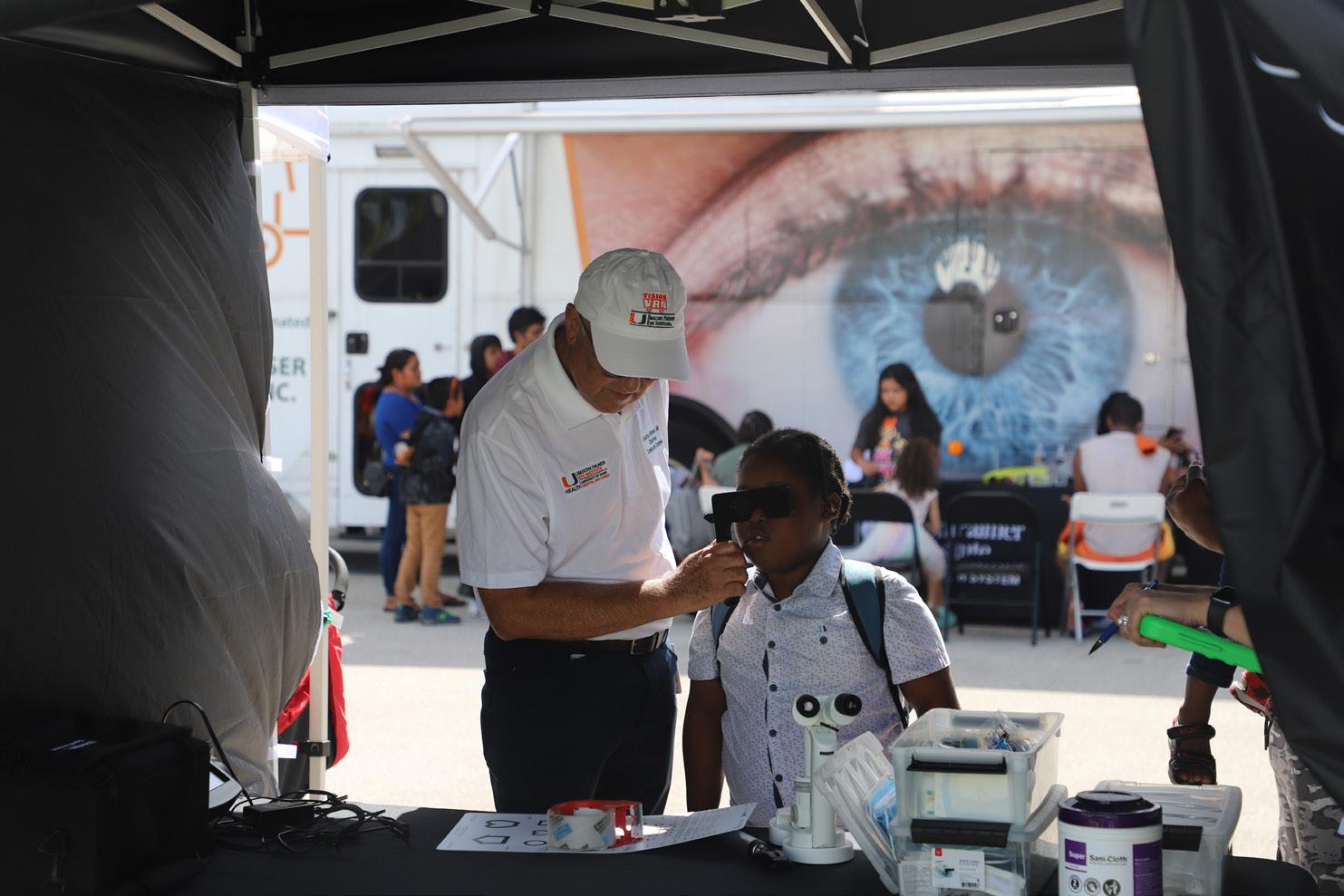
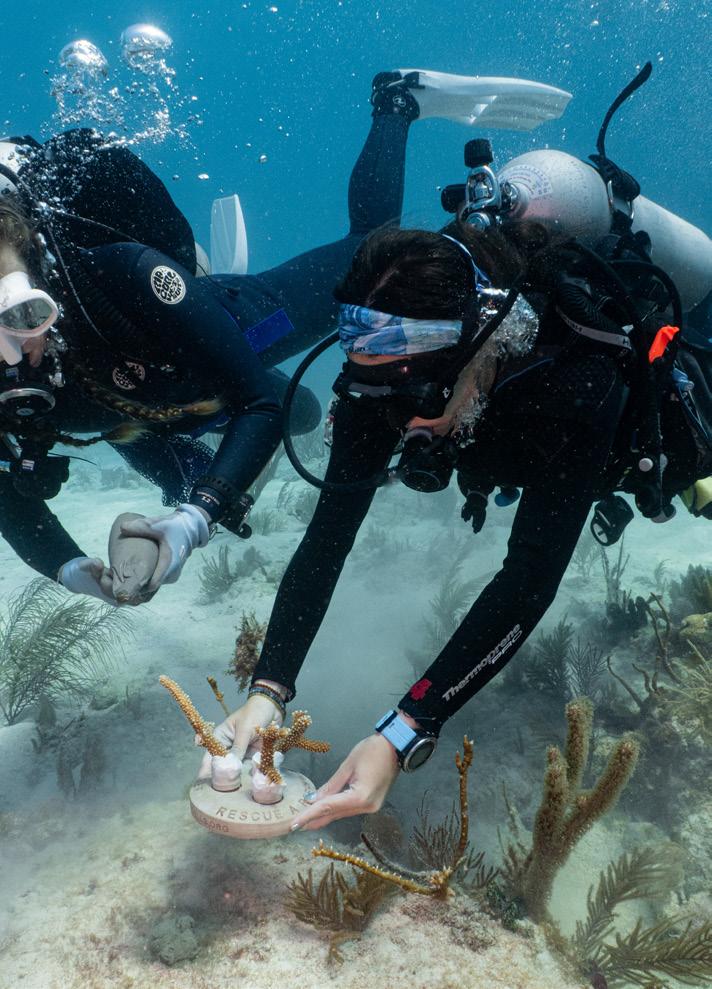
ber hovered around 30.
But, having to continuously collect, spawn and outplant corals is not a sustainable solution. A more permanent effort is underway to selectively breed the most tolerant coral types, essentially in a controlled survival of the fittest model.
“Some early observations have suggested that sexual recruits are more thermally tolerant compared to parent colonies, which suggests that corals are adapting to warming environments, but our concern is that they may not be able to adapt quickly enough to keep up with the rate of global climate change,” D’Alessandro said.
In 2024, Rosenstiel and partner universities were awarded a four-year, $16 million grant from the National Oceanic and Atmospheric Administration (NOAA) Fisheries Habitat Conservation Program Office to continue to fund the development of resilient corals.
None of this matter though, scientists explain, if the ocean continues to warm to unprecedented temperatures. Quelling the rise in temperatures is a significantly more challenging feat that requires the cooperation of billions of people.
That’s where Rescue a Reef comes in.
“We don’t have the capacity to out plant enough corals onto the reef to combat the mortality that we’re seeing as a result of climate change,” Devon Ledbetter, the engagement program manager of Rescue a Reef, said.
Lirman established the non-profit as an offshoot of his lab meant to engage the public in an interactive discourse on corals and climate.
“Rescue a Reef’s primary mission is not necessarily to outplant as many corals as we can. Our mission is to use coral restoration as a bridge to close the gap between science and society and give the public the opportunity to create a personal connection and a personal investment in coral reef ecosystem health,” Ledbetter said.
The program has been able to reach more than 42,000 individuals and included 1,500 citizen scientists on their coral outplanting expeditions.
“We wanted to give people an opportunity to come out with us on the boat and experience coral restoration. Because hands-on learning has been demonstrated to be one of the most impactful and long lasting kinds of learning that we can offer,” she said.
Curing paralysis on patients’ terms
On October 26, 1985, Marc Buoniconti made a play that would change his life. In a football game against East Tennessee State University, Buoniconti sustained a spinal cord injury (SCI) that left him unable to move any muscles below his neck.
That same year, Buoniconti and his family founded The Miami Project to Cure Paralysis, a medical institution committed to improving the life of patients with SCI and researching to find solutions.
It has become a world leader in the effort to cure paralysis.
“We can confidently say we are the most comprehensive Spinal Cord Injury Research Center in the world,” Dr. David W. McMillan, the director of education and outreach, said.
A good way of understanding how The Miami Project operates is to look at its logo. It’s a pretty straightforward depiction of a sequence of stick-fig-
ure drawings that go from a seated position in a wheelchair to standing upright.
“It implies that the cure for paralysis is going to be when someone can stand up again, right? We even have a logo, a motto, ‘Stand up for those who can’t’,” McMillan said.
The next step is to forget about the logo, because for most patients, leg function is at the bottom of their priority list, he explained.
When Dr. Kim Anderson-Erisman asked people with spinal cord injuries what their main hope was, they said to regain control of their hands. This was followed by control over the bowel, bladder and sexual function, three functions essential to daily life.
The Miami Project is accomplishing this, operating across several disciplines to find the best ways to better the patient experience through as many avenues as possible.
UM participated in Project Uplift, a study that looked at stimulating the spinal cord, with several other universities. At its conclusion, the FDA licensed, for the first time ever, a medical device to restore movement in the hands of people after chronic tetraplegia.
“We’re seeing that [results] in people that have had injuries for like 30 years,” McMillan said.
On the front of fertility, UM’s research teams have also been instrumental.
“35 years ago, if you were a man living with a spinal cord injury, it would be very, very difficult for you to have a baby,” he said. “Now we are very confident we can help you to have a baby. You can become a father, and it’s due to some pretty simple but nuanced medical interventions here at the Mi-
“We’re seeing [results] in people that have had injuries for like 30 years.”
Dr. David W. McMillan SCI Director of Education & Outreach
ami Project.”
Of course, total restoration of function is the leading goal at The Miami Project. Scientists have reported that most vertebrates are able to regrow cut nerves outside of the brain and spinal cord, but not inside.
Researchers haven’t been able to discover why, but Dr. Mary Bartlett Bunge thinks it may have something to do with Schwann cells, the insulating cells that help protect a human’s network of nerves. These cells are found throughout the body, but not in the brain and spinal cord.
“She was like, well, if we take them out and we put them back in, in a way, then maybe they’ll be therapeutic,” McMillan said.
The hope is that the Schwann cells help regrow axons, a part of a nerve, through the spinal injury. This would essentially, in theory, restore function. The studies to determine if this is effective are currently underway. Medical research is a slow moving process however, so there’s no definitive timeline of when scientists will know if this works.
In the meantime, McMillan is motivated by how far The Miami Project and paralysis restoration has come. To him, the simple fact of someone with SCI being able to enjoy their life is monumental.
“Marc Buoniconti is celebrating the 40th year of his injury this year, not the 40th year of his life,” McMillan said. The fact that he can make it this long, thriving, leading a 200 person right center of excellence with his tetraplegia is a modern medical phenomenon that was not possible multiple years ago. It’s an important perspective.”
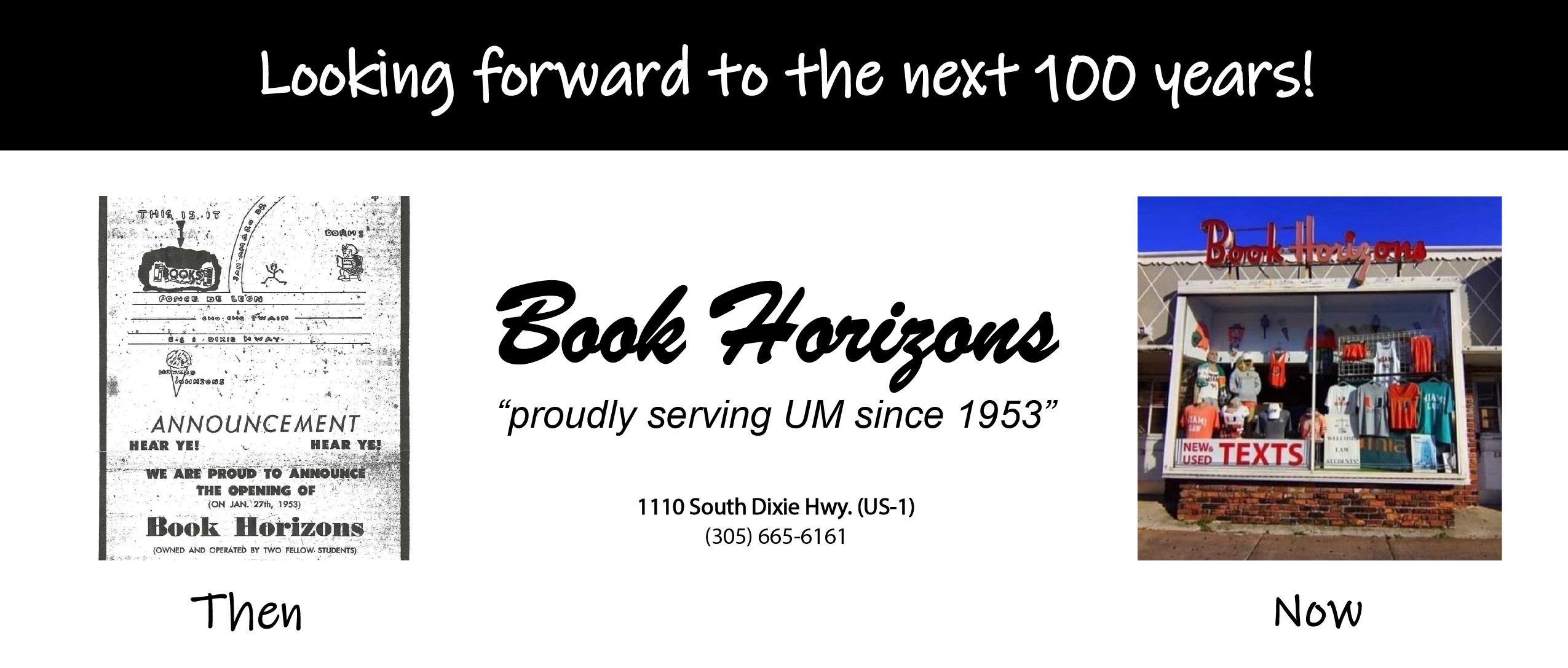
By Editorial Board
Continued from Page 1
The Hurricane must exist. It’s woven into the structure of UM and serves as a necessary bridge between student life, administration, faculty and alumni. To lose the newspaper would be to lose the voice of students altogether.
The Hurricane’s vital role
On a random weekday in 2024, students received letters alerting them that their fnancial aid was going to be adjusted as a part of a Financial Aid Course Audit. The email said their classes were not a part of their course of study and would cease to be covered by fnancial aid.
No one knew what that meant and no one at the University would comment. This out-of-theblue email had threatened to push students to take out tens of thousands in loans or graduate semesters earlier than planned.
Frustrated students began to privately message members of The Hurricane at all hours asking if we could help them understand the policy. Some students tried to solve the issue independently. Some told their parents. Some complained to faculty members. But the University failed to clarify its policy for weeks.
“When there’s an information void, there’s rumors, there’s panic, and there’s no spotlight on what the government is doing,” Sallie Hughes, department chair of journalism and media management at the School of Communication, said.
“So student newspapers have a huge role to play.”
When students felt abandoned by the university they paid for, The Hurricane was there.
We played a crucial role in capturing the widespread anxiety of students and parents. To write our articles, we sent the University non stop requests for comment, conducted student interviews and researched the policy. We were then able to publish an explanation of the policy, cover student’s discontent with the University and even author an editorial imploring the University to be more transparent.
Following our coverage, the University explained exactly how the policy worked, allowing students and parents to plan their academic paths. When student voices are united and have a newspaper to amplify those voices, the University is more compelled to address them.
“They report on not just policy changes, but when things happen in the school,” said sophomore architectural engineering major Bahar Arian. “Like when the president steps down, obviously we hear about that, but when they change their policies or when academic structures change … you couldn’t fnd that information elsewhere. I’m not going on UM’s website to see if they talk about that, if they even disclose it.”
Steven Priepke, deputy dean of students and fnancial manager for student media, said that student media on campuses is “everything.”
“I think it’s so important not to be afraid to say what is on students’ minds, and to explore that and talk about that is at the very heart of what education and journalism is supposed to be,” said Priepke.
What happens then if student media is not
opinions of the study body.
We need to change, but so do you
By Editorial Board
The Miami Hurricane has survived at UM for almost 100 years, but with print media dying, the traditional newspaper is struggling.
In 2022, only 8% of college students nationwide read the print edition of their campus newspaper, and 18% read the online edition. And why should they, if their own college newspaper isn’t even engaging with them?
As much as we expect you to meet us in the middle by reading and sharing our stories, the responsibility to be informed does not rest totally on your shoulders.
TMH works each year to reevaluate what types of stories draw the most interest from students and where they prefer to interact with that information. In the past few years, TMH has added a podcast, redesigned its social media posts and made its website more accessible.
We have focused on developing our breaking news reporting to get information out faster and conducted several investigations.
“I think that there’s no problem with TMH continuing to exist well into the future,” Priepke said. “They will always have to continue to adopt and adapt to whatever the electronic way is to reach the generation of the day.”
We hope that with UM’s help and by continuing to modernize, TMH will live to see another century, but we need engaged readers. Because, after all, what good is a newspaper without our readers?
Online sites have proven that students are open to reading about campus news. What makes platforms such as RedCup so popular among UM students? The gossip? The humor? Maybe a little of both, but the key to their popularity is the opportunity for student interaction.
TMH plans to continue fnding ways to connect directly with the student body. Our staff is exploring the ideas of dedicated student sections in the print edition, news-tip focused tabling and engaging social media prompts to garner quick
there? Will the university have to rely on the unmonitored posts of anonymous instagram accounts or will they turn to News@theU, the university’s sanctioned news and communication platform?
While a genuine source for information that shared the many accomplishments of the school, News@theU is ultimately a part of the university’s public relations vision. They are unlikely to publish the unsavory and hard-to-discuss events of the day. Unlike TMH, News@theU was not rushing to cover the collapse of Mahoney-Pearson roof on March 30, 2025.
TMH’s coverage is the frst draft of the history of the university.
Sometimes this history isn’t pretty. TMH covered every step of desegregation on UM’s campus, interviewing black student leaders when many others refused to give them a voice.
These archives are now essential to constructing UM’s history, refecting on the university’s journey to racial equality and appreciating the trailblazing commitments of civil rights leaders on campus. It’s a history UM is now proud to tell.
Our irreplaceable effort
When students bought parking passes for the Red Lot in 2023, they did not realize that the spots would be impossibly narrow. Most cars covered multiple spots, forcing students to miss classes as they searched for available spots. Parked cars were commonly scuffed and crashes happened daily.
RedCup Miami, another form of student media, publicized the issue with videos of crashes, dents and hit-and-runs. The posts helped to capture the mayhem that Red Lot parkers experienced. This awareness is important and the Hurricane values the work that RedCup does to represent its students. With that, the Hurricane and RedCup serve different roles, each essential in their own way.
The exhaustive work that goes into a Hurricane article is what differentiates it from social media platforms. When we added to the RedCup coverage with our own piece, we solicited responses from the University about the issue, consolidated student opinions from a range of sources and provided important context for those outside of the UM community.
Our article will live on as part of the historical record of the University of Miami. In 100 years, readers will be able to look back and see the story about the Red Lot in its entirety via our article.
The Hurricane is the most comprehensive, neutral and accurate source for this information.
Unlike new, alternative forms of media, our reporters follow ethical principles and are committed to reporting the truth. Most social media accounts do not professionally fact check their stories, nor do they carry out interviews to achieve a well-rounded presentation of information.
Big headline stories like these don’t get written overnight. They require intense commitment and skill.
“When the student newspaper prints an article that people really want to read, sometimes it’s so popular that the site is busy,” Priepke continued. “Those are exciting times. I think that’s always possible. As long as that’s possible, you’ll have a
student newspaper.” When affrmative action was overturned in June 2023, our editorial team immediately took note of how it could impact the university. We stuck with the story for months. When UM hesitated to share enrollment demographics in the fall, we pushed back.
For weeks, our reporters had heard whispers from student leaders that freshman membership in Black student organizations was noticeably low. After several conversations, UM entrusted us to receive that data before anyone else. In the end more than 100,000 people viewed the story. That story, seemingly simple, was a culmination of months of work. If readers only care to support us in those top headline moments, who will be there in the in between moments?
Money still matters
We’re 1,300 words into this article and have yet to even talk about funding.
Journalism revenue has cratered over the past few decades. Digital journalism has wholly replaced print journalism at some university and local papers, eliminating print advertising revenue which was once their largest source of funding. A Pew Research Center study found that between 2008 and 2018, newspaper advertising revenue fell from $37.8 billion to $14.3 billion, a 62% decline. The result is that many newsrooms can’t afford to pay many of their employees.
The challenge in securing funding extends to college newspapers. Our paper relies on fnancial support from the University, which gets supplemented by advertising revenue. While most of the University funding goes to the paper’s overhead, the advertising revenue goes directly to compensating our writers, editors, and printing. If advertising dollars dry up, then we would be forced to reduce compensation.
How is that relevant to our readers? Advertisers care when students are engaged with the paper. The more readers, the more ads and more revenue. What can you do to help?
Most people, unfortunately, fnd it easy to ignore newspapers. They complain that news can be negative, even depressing. It can require thought and refection to understand a story. And it takes time to read what TMH publishes every week. But as a paying student of this University you should want to stay informed. It’s crucial to stay aware of what the university is doing and if that is in line with your values and expectations for your college experience.
Your support and engagement matter beyond improving our readership numbers. As much as you count on us to let you know when something important is happening, we have to trust that you’ll have our backs if our place on campus is threatened.
TMH is dedicated to continuing serving students — covering important issues, empowering student voices, holding individuals accountable and adapting to the times.
Even though this staff won’t be around for the next centennial, our fondest wish is that those who are will come to celebrate UM’s 200 years and fnd The Miami Hurricane’s nameplate still splashed on every corner of our campus.
Changes are happening in the School of Communication as well. Sallie Hughes, department chair of journalism and media management at the School of Communication, is working on a new program that would expand the Community Wire, an independent community news outlet in the School of Communication staffed primarily by graduate students, taking it to “the next level.”
The University is looking to hire a new faculty member in digital journalism and local news collaborations to lead an initiative that will leverage the combined strength of UM’s student media platforms, upper-level undergraduate classes and graduate student work through local and statewide partnerships.
“We are looking for ways to help the Hurricane have an even broader reach…to use their talents to produce journalism about communities in South-Dade county and in Miami that aren’t being covered, “ said Hughes. “From a social impact standpoint, the students get to see how jour-
nalism can make a difference in the community. From a professional development standpoint, they see their good work reaching more people, having a bigger impact…I think it’s a win-win.”
But for our efforts to work, we need you to participate.
If our community immediately clams up when they hear the words “Do you consent to being recorded for this interview,” how are we supposed to do our jobs as reporters?
We already have Instagram posts asking people to submit tips and a button on our website where you can submit an anonymous form with information. These forms are rarely used.
And it’s not just students. In the past, TMH has had diffculty connecting with higher-ups for interviews and information about campus events.
So, while we work on modernizing and catering to your needs, you should think about what matters to you. Help us, help you, and in 100 years we’re confdent that TMH will continue to deliver the news to UM.
“I think it’s so important not to be afraid to say what is on students’ minds, and to explore that and talk about that is at the very heart of what education and journalism is supposed to be .”
Steven Priepke Deputy Dean of Students & Financial Manager for Student Media

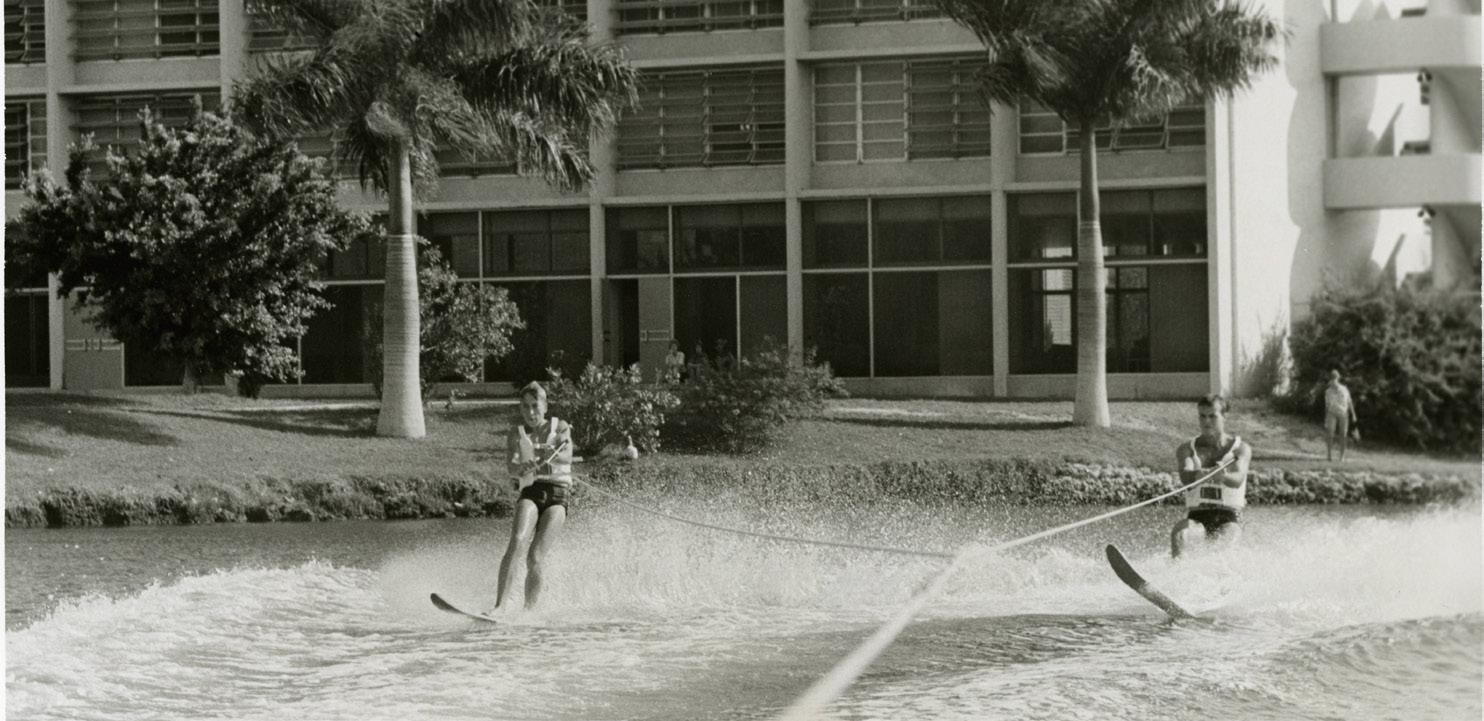
By Michelle Mchado Contributing Writer
The University of Miami was once known for its nearby beaches, nightlife, and carefree social scene. In the 1980s, it frequently topped rankings as one of the nation’s biggest party schools, earning the nickname “Suntan U”.
However, over the past few decades, UM has undergone a remarkable transformation, shedding its “party school” image and reinventing itself as a world-class research institution. This shift was not accidental but the result of strategic efforts that changed the trajectory of the university.
UM has worked tirelessly to rebuild its reputation, focusing on academic excellence, research advancements, and attracting top-tier faculty and students. This transformation began under President Edward T. Foote II (1981–2001), who recognized the need to move beyond the “Suntan U” image. Foote raised admission standards, recruited distinguished faculty, and strengthened the university’s research focus. His successor, Donna E. Shalala (2001–2015), expanded on these efforts, securing major research funding, investing in state-of-the-art facilities, and forming strategic partnerships. To-
gether, their leadership laid the foundation for UM’s rise as a top-tier research institution.
One of the most signifcant milestones in this transformation was the university’s induction into the prestigious Association of American Universities (AAU) in 2023. AAU membership is reserved for only the top research institutions in North America, so this recognition marked a major turning point in UM’s evolution. As an AAU member,
UM now has access to increased federal funding, valuable research collaborations and a global academic network, which provide students and faculty with unparalleled opportunities. Being part of this elite group of institutions places UM alongside Ivy League schools and other top universities, enhancing its ability to compete on the world stage.
Alongside this achievement, UM invested heavily in enhancing its research capabilities. One of the most notable areas of growth has been in the Rosenstiel School of Marine, Atmospheric and Earth Science, which has become a leading research hub. The school’s innovative work in marine biology, climate science and atmospheric research has elevated UM’s global standing and contributed signifcantly to its newfound reputation as a research powerhouse. For example, RSMAS has played a critical role in climate change research and the preservation
of marine ecosystems, with groundbreaking studies that have garnered international attention. Since 2022, its researchers have led a $7.5 million DARPA-funded project to develop hybrid biological and engineered reef structures aimed at protecting vulnerable coastal regions in Florida and the Caribbean.
UM has also expanded research opportunities across other disciplines, investing in state-of-the-art facilities, distinguished faculty, and global research partnerships. For instance, its Rosenstiel School of Marine and Atmospheric Science has become a hub for marine biology and climate change research, while the Miller School of Medicine leads groundbreaking work in biomedical innovation. These efforts have strengthened UM’s academic standing and provided students with cutting-edge advancements in science and technology. UM has emerged as a leader in felds such as marine science, biomedical research, engineering and environmental studies with key programs focusing on coral reef studies, biomedical innovation, and sustainability challenges.
Moreover, UM’s commitment to academic excellence has extended to its student body. Over the years, admissions have become more selective, with higher GPA and test score requirements that attract stronger and more competitive students. The university’s soaring application rate, coupled with a plunging acceptance rate, refects this shift toward attracting academically talented individuals. This trend has contributed to UM’s changing reputation and steadily improved its rankings in national and global surveys over the years. For instance, UM jumped from #67 in the U.S. News & World Report in 2000 to #49 in 2021.
UM’s transformation has also strengthened job placement and recognition from graduate schools and employers. As noted in UM Magazine, 2023, the university’s prestigious AAU membership enhances faculty recruitment, student opportunities, and global collaborations, giving students a competitive edge. Its expanding alumni network and corporate partnerships further enrich students’ experiences, offering mentorship and networking opportunities.
The university has established new partnerships with top-tier institutions and corporations in industries like healthcare, technology and environmental
sustainability. These collaborations provide students with internships, research opportunities and direct pathways to employment at leading companies. UM’s enhanced reputation has resulted in more fnancial support from donors, enabling the university to increase scholarships and fnancial aid. As UM continues to attract high-achieving students, it gains access to expanded career counseling, study-abroad programs, and cutting-edge academic resources. Today, the University of Miami stands as a testament to the power of reinvention. Its journey from “Suntan U” to a respected research powerhouse demonstrates that with the right focus and investment, even the most ingrained reputations can be rebuilt.
While UM’s transformation into a top-tier research institution has brought numerous benefts, students still enjoy the vibrant lifestyle that Miami offers. The balance between academic rigor and a thriving social scene now defnes UM’s “work hard, play hard” culture, offering the best of both worlds to those who choose to study there. Students can still take advantage of Miami’s beautiful weather and bustling nightlife while benefting from an academically rigorous environment that pushes them to excel in their felds.


By Katie Karlson Opinion Editor
Human-induced climate change is here, and it’s here to stay. Rising temperatures and sea levels coupled with ozone degradation form our reality. While all of us play a role, larger corporations and entities have the capacity to truly make a difference in saving our environment.
Over the last century, the University of Miami has made signifcant progress toward achieving its environmental goals and mitigating its carbon footprint, and these changes have laid the foundation for UM to continue improving for the next 100 years.
UM is currently tackling its “Sustainable Operations Plan 2035” to achieve net zero emissions over the next decade. The plan has fve main focus areas to achieve its objectives: carbon neutrality, energy effciency, green buildings, alternative mobility and waste diversion.
While net zero emissions may seem to be an unattainable goal, the U’s years of hard work and commitment to keeping our campus green have brought it within reach.
Green U, an initiative to integrate environmental consciousness throughout the university, was launched in 2000. Initiatives focus on nature, green buildings, water, and food and well-being. The webpage also outlines specifc programs UM has put in place and ways for students to get involved.
In fact, many students are already actively working towards environmental improvements without knowing it. Anyone living in Lakeside Village does so under green roofs and rain gardens.
“Since 2007, the University embraced a LEED (Leadership in Energy and Environmental Design) initiative for its building and construction projects,” said UM Sustainability Director Teddy Lhoutellier, in a statement to TMH.
“Today, 22 buildings have been certifed, most notably the LEED Gold certifcation of the Lakeside Village Housing units, featuring the frst green roofs on residential student housing in our region, rain gardens to manage stormwater, HVAC heat recovery systems and stilt structures to address climate resilience.”
Additionally, UM partnered with Adidas and Parley for the Oceans in 2018 and the ’Canes became the frst college football team to wear jerseys made from recycled ocean materials. So, all of our football players are automatically contributing to eco-friendly initiatives.
In addition to those improvements, the University became an active member of The American College and University Presidents Climate Commitment in 2007 and subsequently designed a climate action plan in 2009.
Per this plan, UM also abides by an energy-effcient appliance policy and only purchases ENERGY STAR-certifed appliances. These appliances, found primarily in Lakeside and University Village, have to adhere to energy effciency standards established by the U.S. Environmental Protection Agency, making this policy yet another way that on-campus residents are unknowingly contributing to climate-friendly goals. Even the auto-shut-off lights prevent energy from being wasted and reduce our campus’s environmental footprint and the cost of utilities.
While these minor adjustments may not seem like they make that much of a difference, when they are multiplied across the 1,115 students living in Lakeside and everyone in University Village, the impact is huge.
For example, ENERGY STAR refrigerators are about 15% more energy effcient than the federal standard. Dishwashers are 10% more energy effcient and 20% more water effcient; laundry machines save users about half on energy bills and one-third on water bills. Each individual’s environmental savings makes a huge difference, and this positive change is even greater when applied across all of the people living in the two villages.
UM reached another important milestone in 2017 when it began following the Sustainability, Tracking, Assessment, and Rating System (STARS). STARS is a self-reported system that colleges and
By Keira Faddis Sta Writer
Only 560 students were enrolled when UM frst opened its doors in 1925. With such a small student body and even smaller graduating class, there was essentially no alumni community. Connections between students and graduates were limited for years following the university’s inception.
As the university grew, so did the alumni association. Today, there are over 210,000 living UM alumni and 36 regional alumni clubs representing all 50 states and 174 countries, according to UM’s associate vice president of engagement, Erica Arroyo, and the 2024-2025 fact fnder.
The University of Miami Alumni Association has expanded and improved greatly over the past century, making it yet another reason why students choose UM. Through networking opportunities and career development, the association provides support to both current students and graduates.
“As a medical student, being in an area with a lot of hospitals is very important,” said Addie Murphy, a sophomore majoring in health science. “Not only do we have UM, but we have Baptist Health,
Jackson and so many others. Many of the doctors working at these institutions are UM alumni. They come to speak at UM and are very willing to share their knowledge and provide us current UM students with opportunities.”
The university offers a medical alumni association that maintains close relationships with current students looking to pursue a career in medicine . Murphy’s experience highlights the importance of the connections that UM fosters. This vast network provides students with mentorship opportunities and a lifelong connection to their Alma Mater.
On UM’s alumni website, graduates can browse through the ’Cane Biz tab to support alumni-owned businesses. This not only helps alumni-owned businesses grow but strengthens the “’Canes care for ’Canes” attitude that has been instilled in students for years.
Alumni can also connect to niche groups including the Band of the Hour Association, Black Alumni Society, Golden Ibis Society, LGBTQ ’Canes, Public Health Sciences, Veteran ’Canes, Women of the U and the Young Alumni Leaders Council. By joining these groups, every alum can have a place of belonging where they can stay engaged with current students.
Another way the university helps foster alumni engagement is by offering different events for graduates on campus throughout the year. These gatherings help alumni maintain their bond with the school, reconnect with old friends and mentor current students.
“The University of Miami has a great sense of network, and we’re known for having that ‘swagger,’ but I like to see it as tenacity,” said Arroyo. “We are a young institution, so our alumni are refective of that vibrant diversity. We are across all different industries and we have a nice, rich fabric of people, and that network is different from any other institution.”
If you’ve ever been stuck in Miami’s rush hour traffc, chances are you’ve seen a UM alumni license plate. These plates are just one of the many different ways alumni show their Hurricane pride. Many alumni also continue to support UM athletics long after graduation by attending football games at Hard Rock Stadium and showing up for the annual homecoming festivities. This attitude is a true testament to the ’Canes for life mentality that the Alumni Association encourages.
“Being a ’Cane for life means that you are connected for life. At the Alumni Association, we try to provide something for everyone no matter what
universities use to measure sustainability progress by creating a baseline for progress. Since then, UM has reduced its Scope 1 and 2 emissions by 89% and Scope 3 emissions by 43%. These emissions are all greenhouse gases that come from any part of an organization. Scope 1 emissions come directly from that organization. Scope 2 emissions come from the energy it purchases, and Scope 3 covers any emissions not otherwise accounted for.
More recently in 2021, UM joined the Florida Power and Light Solar Together program, allowing the university to get 100% of its 2020 electricity consumption through off-site solar energy. This program also plays a crucial role in helping UM achieve its goal of carbon neutrality.
By publicly sharing these benchmarks and taking the time to perform carbon accounting, UM earned the honor of a STARS Gold Rating in 2022. This rating is just one of many that UM has the honor of holding.
“In 2023, the University ranked No. 8 on the U.S. Environmental Protection Agency’s Top 30 list of higher education green power users,” Lhoutellier added. “The EPA selected the University of Miami as a member of its ‘Green Power Partnership’ in recognition of the University’s continued commitment to utilizing clean energy.”
“In addition, in January 2025, the University’s ranking in the Princeton Review Top 50 Green Colleges went up from No. 26 to No. 13. And in 2024, the Coral Gables Campus was awarded the Tree Campus USA recognition for the tenth consecutive time since 2014 by the Arbor Day Foundation.”
Although UM is still a few years away from achieving its primary goal of net zero emissions, the university has undoubtedly made a huge impact in improving the environment. They have taken necessary steps in raising awareness about how each individual can make a positive impact on the world around us.
UM sets a high standard for other universities and is a role model for sustainability. Nature is an integral part of our campus and UM has done a great job preserving and valuing our environment. It is the thriving environment that makes our campus special. So, with the improvements UM continues to make, this beauty will remain for years to come.
stage they are in life,” Arroyo said. “If you’re a young alum, we might provide job opportunities, and if you’re a little bit older and you’re working professionally, we might provide some more industry expert sessions.” Alumni can use their alumni ’Cane card to beneft from many of the same amenities they enjoyed during their time as students. For a fee, alumni can get things like a wellness center membership, use of the Richter Library and use of the pool. Many alumni choose to give back to the UM community through donations. These donations can go to things like funding scholarships and improving specifc departments including athletics, theater and band. For example, Alix Earle, a graduate of the class of 2023, established a scholarship fund to help support students in the Miami Herbert Business School. This scholarship aims to help juniors and seniors who demonstrate fnancial need and has so far been awarded to two students. Both students were featured on Earle’s podcast to share their experiences with winning the scholarship.
Alumni play a crucial role in shaping UM’s reputation, whether it be through donations or mentorship. No matter how they contribute to the UM community post graduation, they serve as a testament to current students, showcasing the opportunities a UM degree can unlock in the future.
By Mel Tenkoff Assistant News Editor
The decade began with a dream: to establish a university that would enrich South Florida’s burgeoning community. The University of Miami’s founding was a testament to South Florida’s ambition and the vision of individuals like real estate developer and founder, George Merrick.
In December 1921, Merrick announced that Coral Gables would become “Miami’s University Suburb.” Despite his many projects, the dream of UM was at the center of his plans.
On April 8, 1925, the University of Miami was granted its charter, but the roaring twenties had their fair share of challenges. The collapse of the land boom in 1926 left the University cashless and unable to materialize Merrick’s many plans for it at the time.
“[The
University of Miami] having passed through such [circumstances] as no other University in the nation has passed through, has still come to great stature in community, state and nation
.”
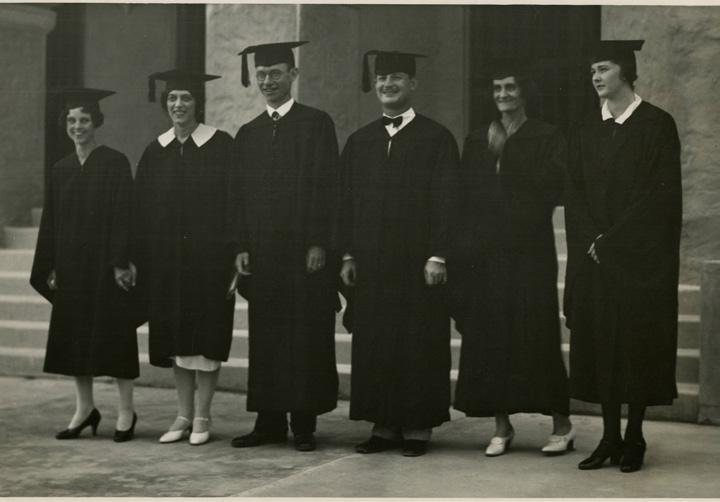
When the fall 1946 term opened, more than 5,000 students showed up to register at the new campus. By 1949, 7,000 students were enrolled.
New buildings, such as the Memorial Classroom Building and apartments for veterans who got married, were completed, marking an architectural shift from the campus of the past. The new Merrick Building became the heart of the school.
“In a few years, the Main Campus will be one of which you can be truly proud,” 1946 Student Body President Charlie Franklin said to The Hurricane. “For the present however, a bit of patience and fortitude. The noise of construction work may be distracting, but it means the dream campus is fast becoming reality.”
ricane. “I have no reason to expect a single incident from our student body.”
Pearson’s retirement in 1962 marked the end of an era. His successor, Dr. Henry King Stanford, became the first president who was not part of the University’s founding. Stanford, a scholar and administrator from Birmingham-Southern College, took the presidency during a time of national optimism and increasing social unrest. The country was in a struggle for civil rights, which led to widespread protests and activism. On campus, students began questioning everything from dress codes to class requirements. The Women’s Movement and African American students pushed for representation in faculty, administration and on the Board of Trustees.
On Sept. 17 and 18, 1926, a devastating hurricane known as the “Killer” and “The Great Miami Hurricane” struck South Florida. No other rivaled its consequences until Hurricane Andrew in 1992.
Merrick later wrote a memoir of the aftermath, detailing the state of Miami after the “Killer” and the determination UM’s founders had in the creation of this institution.
“A group of Miami citizens sat in an unroofed building and decided upon the opening of the University of Miami,” he said. “The history of the University of Miami since that day, having passed through such [circumstances] as no other University in the nation has passed through, and still has come to great stature in community, state and nation.”
On Oct. 15, 1926, the University of Miami welcomed 646 students under President Bowman F. Ashe. However, it did not resemble the ambitious higher education institution that its founders spoke of just months earlier.
The campus was centered in the Anastasia Hotel in Coral Gables, whose first and second floors were the only completed ones. Besides classrooms and laboratories, the space also included administrative offices, a library, a student lounge, a large auditorium and a gymnasium with locker rooms.
Students paid $225 a year to attend the new university. Half was due at registration, the rest at the start of the second semester.
Girls could live in the rented third floor of the San Sebastian Hotel a block away, but the boys had to fend for themselves until they finished building the men’s dormitory, “La Posada del Estudiante,” (now the University Health Center), on the main campus.
The College of the Liberal Arts, which included music, art and drama, and the law school hardly resembled the many offerings proposed just a year earlier. To accumulate more revenue for the University, faculty and staff came up with solutions, including aviation classes through Curtiss Flying Service and one of the nation’s first undergraduate marine zoology programs led by future UM President Jay F.W. Pearson.
In 1926, President Ashe suggested that UM launch an honor society for men, and in 1926, the Iron Arrow Honor Society, the highest honor given at UM, was established. Iron Arrow had nine founding members: Leonard Tunk, Gavin Miller, Clarke Wilson, Francis Houghtaling, Dale Clark, Harry Gray, Norman Kennedy and Bob Fink.
In the 1930s, the University of Miami faced a period of challenges, but also experienced remarkable moments of growth and resilience. The decade began with financial struggles. A drastic 60% reduction in faculty salaries prompted seven faculty members to file a complaint.
In response to the escalating crisis, UM filed a voluntary petition for bankruptcy. In an effort to save the institution, Ashe, along with a group of University supporters, purchased the University’s assets for $15,758.
The students of the University were also deeply invested in the success of their school and rallied together to help. They went door-to-door to raise funds and organized a campaign urging recipients of a Florida Supreme Court-mandated refund from Florida Power and Light to donate their refund to the university.
“When you went to Yale or Harvard or Florida, you knew you were just a student like thousands of others before you and after you,” one alumnus recalled in a 1949 Miami News article. “But at Miami you felt like one of the pillars under the building. If you pulled out the whole thing might collapse.”
Perhaps the most iconic display of students banding together occurred in 1936. The university was struggling with its aging Anastasia Building, and the students decided to take matters into their own hands.
They raised $1,000, equivalent to over $19,000 today, to purchase paint for the building, and spent their own time painting it. Newsreel photographers captured this event, and it was broadcast to theaters across the country. Under the headline “For the First Time in History,” the editors of the 1936 Ibis Yearbook summed up the experience.
“When the painting was completed, the University of Miami took on new importance.” the Ibis said. “Not only did the exterior appear bright and shiny, but also the very spirit within was strengthened and brightened.”
By the end of the decade, the University had made significant strides. Enrollment was increasing, and finances were improving.
The University purchased several key properties in the area, including the San Sebastian Hotel, surrounding apartment buildings and the former Granada Shops furniture factory.
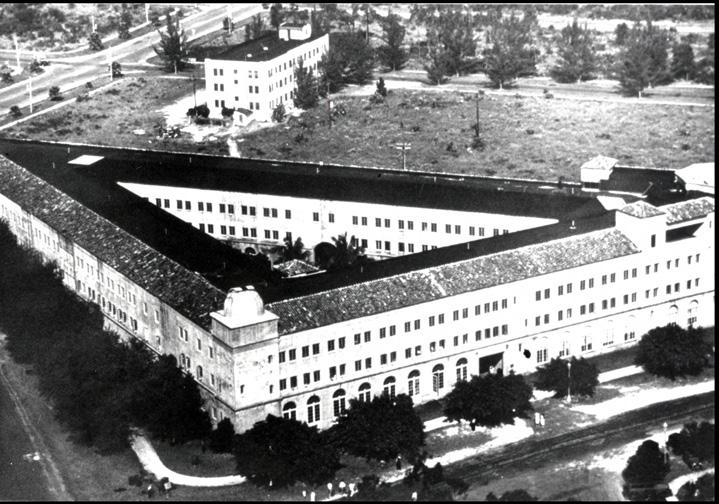
Courtesy of University of Miami Archives An aerial view of the Anastasia
The early 1940s were a time of monumental change for the University of Miami, sparked by the attack on Pearl Harbor, the opening of the Graduate School in 1941 and the establishment of the Marine Laboratory, now the Rosenstiel School for Marine, Atmospheric and Earth Science, in 1942.
In the spring of 1942, Miami Beach turned into a military training ground, and over 50 U.S. Army and British Air Force cadets arrived on campus. They enrolled in regular college courses and participated in all facets of campus life, from fraternities to politics and even some joined the football team.
By 1944, a record number of 2,400 students had enrolled. By this time, the university’s demographic was largely white, with a growing Hispanic population.
With the increase in funding from military programs and revenue, the University Board of Trustees purchased the original 245-acre campus that Merrick had envisioned as the foundation for the university 20 years earlier.
On Sept. 16, 1946, the University held its first classes at the new main campus, which was still under construction.
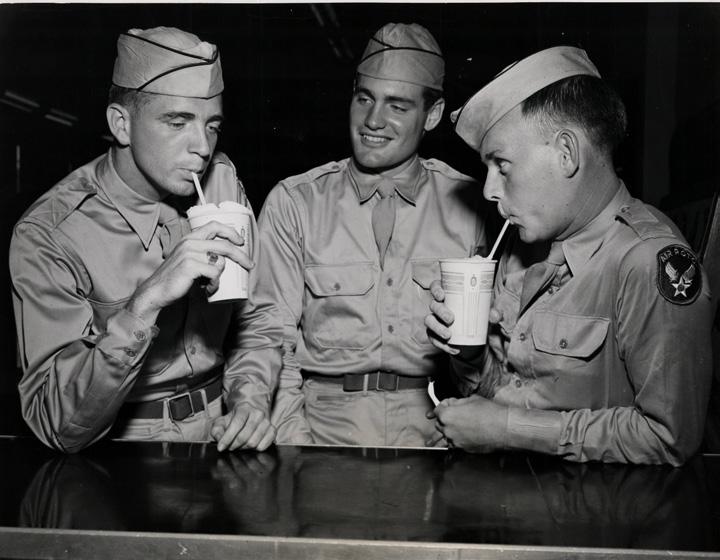
The campus now featured modern apartment and classroom buildings, along with the Lowe Art Museum and Ring Theatre.
Academic programs flourished with the growth of enrollment. The long-awaited College of Engineering was established in the Anastasia Building in 1947, and the Marine Institute received further expansion, with the University securing a property on Virginia Key in 1948. UM’s Medical School was established in 1952 from a research unit at the Veterans’ Hospital and became Florida’s first school of medicine.
In December 1952, the University experienced a profound loss when Ashe, the “heart and soul of the University,” passed away unexpectedly.
At a memorial in 1953, Ibis Yearbook reflected on his immense contribution,“his indomitable courage spurred it over several seemingly insurmountable hurdles.”
Jay W. Pearson, a member of the original faculty and Vice President at the time, was named president on February 6, 1953.
“We were small at the start, yet both were sturdy and stood the periodic lashing of the wind and cold,” Pearson said in his inaugural address in May 1953, likening the University’s growth to a young tree, “suddenly, both began to shoot up, at last to burst through the surrounding foliage.”
Enrollment surged, and the University’s building program expanded dramatically. Pearson introduced new graduate programs, oversaw the dedication of the Antonio Ferre Graduate School Building and secured a multi-million dollar gift from Otto G. Richter for the building of the Otto G. Richter Library in 1962. He also initiated the first Honors Program and oversaw the newly accredited School of Medicine’s move to Jackson Memorial Hospital.
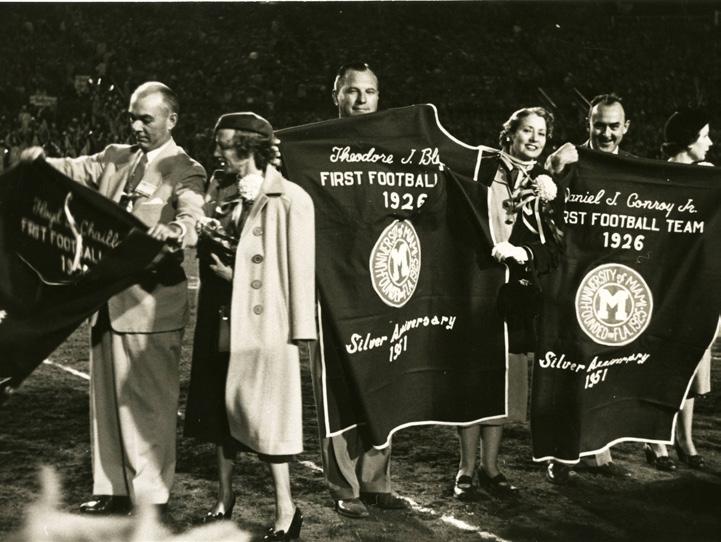
United Black Students was founded in 1967 by Harold Long to push for equal rights on campus with a series of demands. On May 17, 1968 the organization led a sit-in at Stanford’s office, peacefully sitting to call for action on their demands.
“There comes a time to stand up for what you believe in,” Long said. “If I don’t do it now, when would I? What type of man would I be?”
Stanford, believing in open communication and the right to dissent, held extensive meetings with students, faculty and minority leaders. He introduced new courses and hired new staff to address the issues.
Martin Luther King Jr. visited the University of Miami in May 1966 and was met by a standing ovation by the 1,200 students and faculty in attendance. When the mayor of Miami requested that Stanford cancel King’s speech, Stanford refused.
“Civil rights is a moral issue – it is not just a matter of economics and politics,” King said. “It is a torturous logic, to use the tragic results of segregation as an argument for the continuation of it.”
In the late 60s, social revolution and activism flooded college campuses. Students were active in anti-war and civil rights activities, especially once the U.S. military began drafting for the Vietnam War in December 1969. Students protested in spaces across the Coral Gables campus, holding signs. One read, “warning: the draft may be hazardous to your health.”
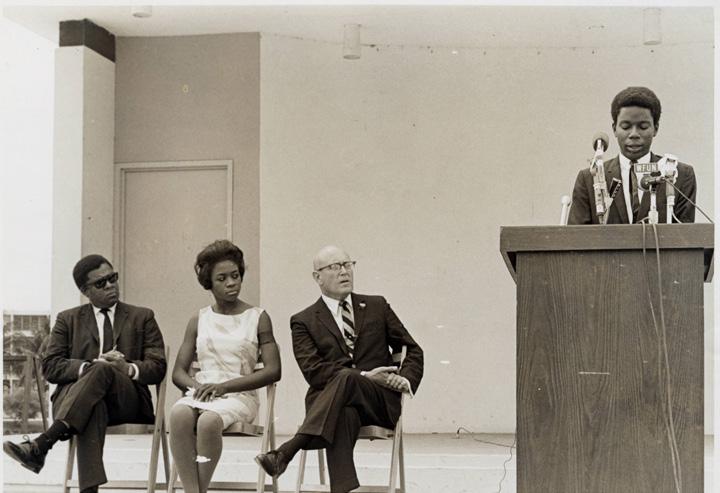
“There comes a time to stand up for what you believe in . If I don’t do it now, when would I? What type of man would I be?”
By the mid-1970s, the University faced mounting financial challenges due to inflation and a national recession. To address this, Stanford and the Board of Trustees launched The Mid-Century
In January of 1961, seven years after Brown vs. The
dation in 1968, the largest gift in UM history at the time. The STEM schools also saw major contributions from the Rosenstiels and other donors, resulting in a new campus at Jackson Memorial Hospital, and the James M. Cox Science and J.N. McArthur Engineering Buildings on the Main Campus.
A major milestone during Stanford’s presidency was the University’s inclusion in the 1973 Carnegie Commission’s list of America’s 52 leading research universities. This recognition, based on research funding and the number of Ph.D. degrees granted, elevated the University to new levels of prestige.
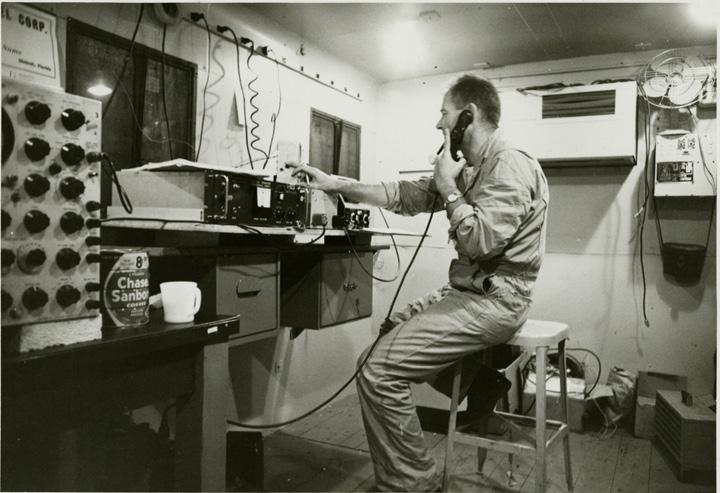
Edward T. Foote became the University’s fourth President in 1981. Following years of consultation with faculty, administrators, alumni, trustees and community leaders, Foote introduced the “Strategy for Excellence” in 1984.
The overarching goal of his plan was to elevate UM into the ranks of other national private research institutions.
The first goal was to raise the quality of students admitted to the university. Foote introduced a bold approach: UM would need to become smaller and more selective. Through the decade, the average SAT scores of incoming freshmen increased by nearly 100 points.
Another major goal was the $400 million Capital Campaign, which aimed to transform UM’s landscaping, facilities and scholarships. At the time, it was the second-largest campaign in higher education history and surpassed expectations with a total of $517.5 million.
The Schools of Architecture and International Studies opened in 1983 and the School of Communication opened in 1985.
In the 80s, UM made history in athletics. The Hurricanes football team went on to win nine national championships after 1984, and later set the record for the longest home winning streak in NCAA history. UM went on to capture additional titles in baseball, women’s golf and men’s crew.
Meanwhile, Iron Arrow faced legal challenges in 1976 when it was sued for violating Title IX by prohibiting the admission of women.
In response, the Iron Arrow Honor Society filed a countersuit to maintain its male-only status. Foote ultimately intervened, stating that the society would not be allowed on campus if it continued to exclude women. The first female members were tapped in 1985.
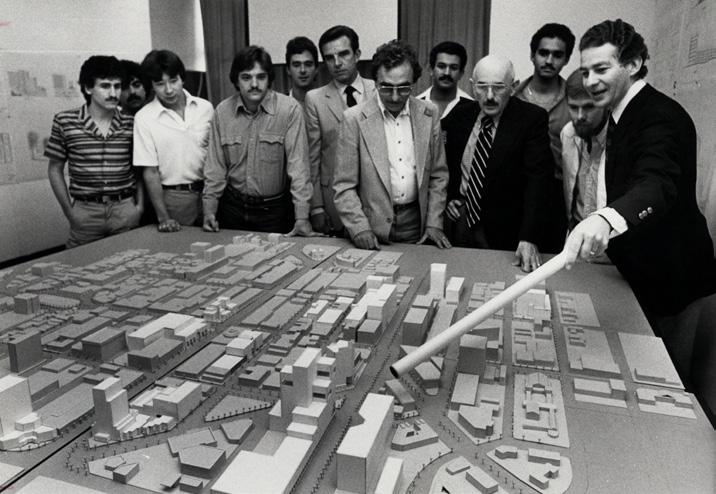
During the first night of new student orientation in 1992, Hurricane Andrew hit. The storm stranded 5,000 students and their families on campus. Four hundred and twelve homes of students, faculty, staff and administrators were heavily damaged, in addition to the campus destruction.
“Working sometimes 48 or more hours straight in conditions of great deprivation without electricity, water, air conditioning or telephones,” Foote said in a note thanking his front-line colleagues. “They cared for those students and friends and remained calm and admirably professional as they helped our University family together.”
Foote, aware of the lessons from the 1926 hurricane that nearly destroyed the University’s founders’ dreams, used this crisis as an opportunity to rebuild and improve. He used insurance and Federal Emergency Management Administration funds to reimagine the campus, ultimately surpassing its pre-Andrew condition. While many highlight the transformation
of the physical buildings during Foote’s presidency, his legacy extends far beyond the buildings themselves. His wife Roberta “Bosey” Foote recognized that the University lacked visual cohesion, so the couple set out to beautify the campus.
Bosey was instrumental in the establishment of the Jane Gifford Arboretum and worked closely with landscapers and the architecture school to add more interesting design elements and greenery to campus. Bosey also planted several palmetums throughout the school.
Initially, some critics viewed this as a superficial concern, but the campus’s lush new look quickly became one of its defining features.
In 1992, the Sylvester Comprehensive Cancer Center was dedicated at the School of Medicine and in 1994 the George A. Smathers Student Wellness Center opened.
Later on, the U.S. News & World Report ranked the University as one of the top 10 universities for diversity.
“[Faculty, staff and administrators] cared for those students and friends and remained calm and admirably professional as they helped our University family together.”
Edward
T. Foote 4th UM President
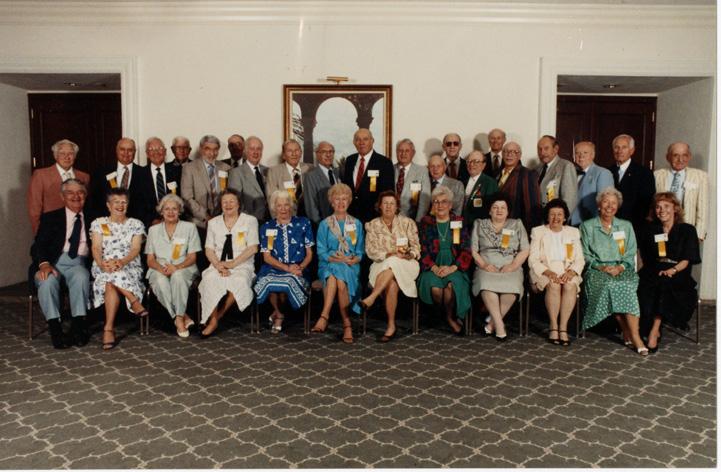
said in a statement to The Hurricane. “But we have to do our share [to help].”
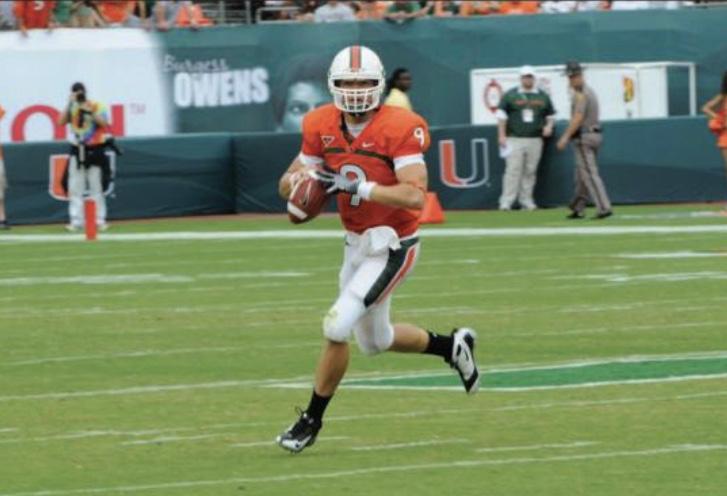
In the early 2000s, UM was ranked No. 67 in the U.S. News & World Report’s annual Best Colleges rankings. By 2014, the University had broken into the top 50 and remained there for the next six years.
Under Shalala’s guidance, the University experienced significant growth and solidified its standing as a key institution in the south and in the nation.
In 2015, President Junio Frenk was inaugurated as the sixth president of the University. As former dean of the Harvard T.H. Chan School of Public Health and a leader in global public health, Frenk brought a fresh perspective to the era of innovation, academic distinction and global recognition.
During his tenure, applications to UM soared by 16%, reaching nearly 40,000. The percentage of admitted students who chose to enroll also increased by 31%, showing the growing appeal and selectivity of the institution.
The decade also saw a revitalization of the University’s infrastructure and medical enterprises. Frenk oversaw the expansion of UHealth, which experienced its best financial performance in history, positioning itself as South Florida’s premier academic health system.
UM’s Bascom Palmer Eye Institute remained at No. 1 in the nation for the 16th time in 2018 and has kept its ranking since. The Ear, Nose and Throat program ranked No. 9 in the nation. In 2019, Sylvester became one of 71 U.S. institutions – and the only institution in South Florida – to become a National Cancer Institute-designated cancer center. This designation drastically increased local funding, from $9.9 million in 2014 to $30 million in 2019.
New healthcare facilities, like the Lennar Center, and record-breaking funding of nearly $322 million in the year of 2019, solidified the University’s standing as a leader in both education and healthcare.
Established in the spring of 2017, the Frost Institute for Chemistry, Molecular Science and Data Science was made possible through the $100 million gift by Dr. Phillip and Patricia Frost that was announced during Frenk’s inauguration.
The Ever Brighter fundraising campaign, which launched quietly in 2015, raised more
A significant test for UM came with the onset of the COVID-19 pandemic, Frenk’s fourth pandemic experience as a public health leader. As the world grappled with the unprecedented health crisis in 2020, the University of Miami adapted to the rapidly changing circumstances.
Classes were suspended on March 17, 2020, and continued remotely until the end of the spring semester. By the fall of 2020, the University was one of only 30% of higher education institutions offering a hybrid model of both in-person and remote instruction. In-person classes resumed in the spring of 2022, and the University welcomed students back with resilient ’Canes spirit.
In 2023, UM was invited to join the prestigious Association of American Universities, an invitation-only membership reserved for the nation’s leading research universities. The University’s place in the AAU was a symbol of its rise to national prominence, with only 3%of the nation’s four-year institutions being granted membership.
Building on this momentum, the University also began investing in its infrastructure to support the next generation of ’Canes. With the Centennial Village to be fully built by the fall of 2026, this multi-step plan is currently two-thirds complete. The next step is the potential replacement or reconstruction of Mahoney-Pearson and Eaton Residential Colleges.
Currently, 1,115 students live in Lakeside Village, 875 students are in Centennial Village Phase One and 1,150 students will live in Centennial Village Phase Two.
On Oct. 18, 2024, Joe Echevarria, former Herbert Business School alumnus and CEO of UHealth, was named the seventh president of the University of Miami.
“Excellence, continuous improvement, and impact are more than shorthand for rising to our immense potential,” Echevarria said. “Those words, which have likely by now become familiar to you, remind us that unless we are giving our very best – in academics, in research, in patient care, in athletics – we are not worthy of the U.”
As the University celebrates its centennial, it has become an even more selective school, with a 19% acceptance rate. Today it is home to 19,852 undergraduate and graduate students spanning 12 colleges and more than 180 majors. The student body is 21% Hispanic students, 15% international students and 10% African American students. On the field, the Hurricanes Athletics have won 21 National Collegiate Athletic Association championships and 85 individual national titles.
“The U means something,” Echevarria said. “Here in our community and in cities around the world, it symbolizes the grit that achieves greatness, and the swagger that follows it. For nearly 100 years, we and our community have been at our best when we achieve greatness together.”
The 2000s marked a transformative decade for UM, driven by the leadership of Donna E. Shalala, former U.S. Secretary of Health and Human Services, who became the university’s fifth president in 2001.
Shalala led the University to new heights in academics, research funding and student success, leading to an extraordinary rise in national prominence.
In 2004, the University found itself in the national spotlight when it hosted the first presidential debate between President George W. Bush and Senator John Kerry at the University of Miami’s BankUnited Center.
Just a year earlier, UM launched “Momentum: The Campaign for the University of Miami”, a fundraising initiative that raised $1.4 billion. This success made UM the first university in Florida to mount a billion-dollar campaign. These funds not only boosted academic programs and research but also supported significant campus developments, such as the creation of University Village.
Originally proposed in 1992, the University Village faced multiple delays, including the devastation of Hurricane Andrew. But by the mid-2000s, UV began to take shape, offering new housing for 800 upperclassmen, graduate, law and medical students, as well as amenities like parking, shuttle services and faculty townhomes.
However, the unexpected impact of Hurricane Katrina in 2005 caused further setbacks to the construction and completion of UV, pushing the opening date back to fall of 2006.
As a result of Katrina, UM opened its doors to offer temporary housing and education opportunities to thousands of students displaced from universities along the Gulf Coast, including Tulane and Loyola New Orleans.
“We’re not stealing them from their home campuses. We don’t have any room,” Shalala
“The U means something. Here in our community and in cities around the world, it symbolizes the grit that achieves greatness.”
Joe Echevarria University of Miami President & CEO of UHealth
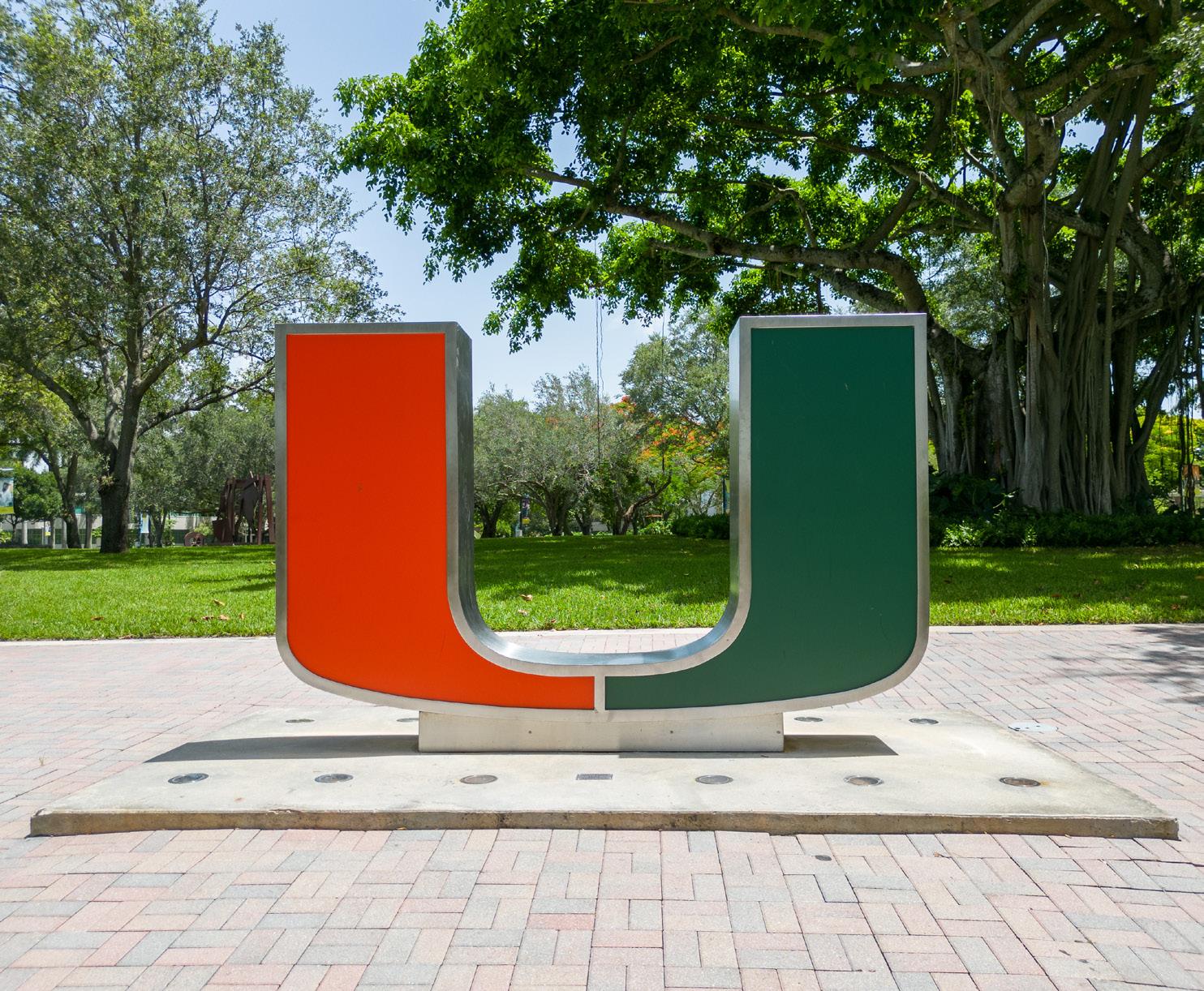
By Keira Faddis Sta Writer
There’s no “U” without The Miami Hurricane. Since 1929, the student newspaper has brought award-winning coverage of national and local events to students.
Ninety-six years later, the paper has evolved from a weekly four-page broadsheet in the traditional newspaper style to a 16-page biweekly tabloid-style paper. Along the way, TMH picked up its raunchy sex and gossip column, V’s Take, an Instagram account and hundreds of awards.
In 1929, when UM reestablished a ten-member board of regents chaired by the University’s frst president, Bowman Foster Ashe, The Miami Hurricane was founded.
“Incredible relationships were forged in that newsroom, and there are so many people who will recall their time working with The Hurricane with such fondness,” said Megan Ondrizek, University strategic communications assistant vice president and 2007 TMH assistant news editor.
Most editions in the early 40s were four to eight pages long with fve to seven news columns. It cost students
$1.25 for an annual subscription. Editorial positions during this time included the editor in chief, business manager, managing editor, associate editors, news editors, copy editors and sports editors.
Columns of the 40s frequently spoke of the war, including the “delivery of Adolf Hitler, ‘alive, unwounded, and unhurt’” for a $1,000,000 prize offered by the Samuel Harden Church. In the October 10, 1940 issue, a notice was printed urging all men aged 21-35 to register for the selective service. In 1942, the US Army, Navy and Marines came to campus to speak to men in a mandatory rally.
Tuberculosis was another issue of the 40s, with the April 24, 1941 issue advertising TB testing to all students and faculty. Athletic rivalries were among other big topics covered in the paper, including the rivalry between UM and the University of Florida. By 1948, the paper was, on average, 16 pages long and featured many more photos than ever before. Front pages of these papers were reserved for photos, a table of contents and major headlines, with the actual news beginning on page two.
The aesthetic of the late 40s stayed until 1958. The frst issue of 1950 covered the 1950 Iron Arrow tapping and a controversial ruling on a discrimination-based bill from the UM senate. There was a notice put in the paper for “ex-prisoners of war” in “German prison camps” to give their names to a professor if they wished to get together.
Tuberculosis screenings happened on campus in April of 1951 and 3,000 students were scanned for TB on campus by getting their chests x-rayed. The nameplate was changed in June of 1951 when The Hurricane was again shortened to 4 pages.
The Korean War was the topic of a 1951 poll on campus, with results revealing students were in favor of a truce.
By the 60s, the average issue of
TMH was eight to ten pages long. It featured news and sports sections, with editorials in amusements, music, radio-tv, theater, artist and intramural sections. According to TMH reporting, the University of Miami welcomed around 30 black students for the frst time ever in the summer before the 1961 school year. This news made the front page of the June 23 edition. Time Magazine praised the university for “the frst lowering of the color bar at the largest independent school in the Southeast,” according to a news brief published by TMH the following week.
Dr. Lucille B. Strain was the frst black educator with “full faculty status,” which was reported in the August 4, 1967 edition of TMH.

request for
“Incredible relationships were forged in that newsroom, and there are so many people who will recall their time working with The Hurricane with such fondness.”
Megan Ondrizek // Strategic Communications Assistant VP & 2007 TMH Assistant News Editor
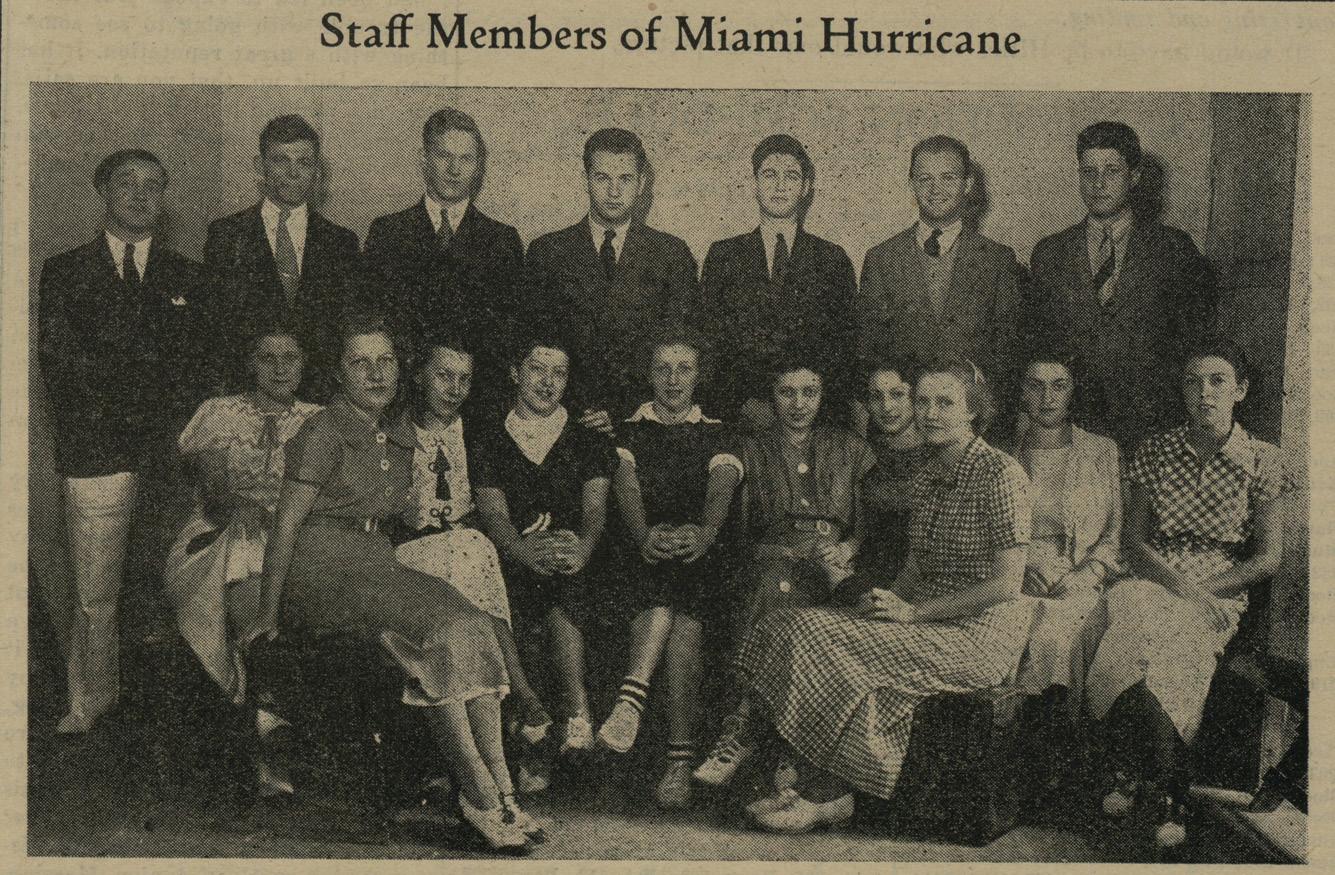
A story that broke in 1976 dealt with Iron Arrow Honor Society and the enforcing of Title IX of the Civil Rights Act. Title IX states, “No person in the United States shall, on the basis of sex, be excluded from the participation in, be denied the benefts of, or be subjected to discrimination under any education program.”
Iron Arrow is the highest honor one can achieve at UM, and from its inception in 1926 until 1985, it only allowed men to be tapped in. Because of this, the society was forced to move its ceremonies off campus while fghting its removal in the Supreme Court.
In 1983, TMH covered when the Supreme Court upheld the decision, requiring Iron Arrow to allow women to join or terminate the society. It was not until February 28, 1985, that Iron Arrow came back to campus, this time allowing women to be tapped, which made the front page of TMH on March 1 of that year. Also in 1985, Bruce Garrison became senior advisor for TMH. As advisor, he helped lead his staff to publish two print editions per week, on Tuesdays and Fridays.
“I tried to be an advocate for the staff to fnd resources for our work. It was also my duty to make sure we had section editors and senior editors in line for the next year,” Garrison, who now serves as a professor in journalism and media management, said. “I was very fortunate to have well-prepared and hard-working editors each of the years I advised the newspaper.”
For its print editions, papers were produced at The Miami Herald offces in Biscayne Bay. Students would go to the Herald’s production department and assemble each issue, and when it was ready, it was printed and brought to UM’s campus.
Beginning in the 1980s, TMH began publishing larger editions of the newspaper over summer break, known as First Impressions.
The frst ever website for The Hurricane was created in 1994 under Garrison. He was the advisor for 10 years until 1995, when major stylistic changes were made.
“We had a staff of about seven or eight editors, a handful of reporters and a couple of photographers. I completely redesigned the newspaper after I became editor,” said Bill Wachsberger, editor of The Hurricane in the fall of 1995, who is now the design director of the Baltimore Sun. “I think the biggest story we wrote was about how the law school newspaper had an editor get his hands on private papers from the law school trying to expose something wrong he did.”
By Bri Pearson Assistant A&E Editor
From Hollywood actors and musicians to icons and entrepreneurs, UM’s alumni network is flled with notable names who have left a lasting impact in the world.
As UM celebrates its layered history, here’s a look at some of the distinguished graduates and attendees who have left their mark on our beautiful campus.
One of the earliest notable attendees of UM is Grace Slick, the iconic painter and musician of the music groups “The Great Society,” “Jefferson Airplane” and “Jefferson Starship.” She attended UM from 1958 to 1959 and studied art.
Continuing the trend of making an impact in entertainment, Bob Clark, the director behind the iconic flm “A Christmas Story,” studied at UM before making his mark in Hollywood. He later graduated with a degree in theater from UM in 1966.
The legacy of UM in Hollywood continued with world-famous actor Ray Liotta, who earned a Bachelor of Fine Arts degree in 1978. The acclaimed actor, best known for his role in “Goodfellas,” honed his craft at UM before rising to fame in Hollywood.
Another notable UM attendee in the acting world is Steven Bauer, a Golden Globe-nominated actor known for his role as Manny Ribera in “Scarface.” He attended UM before dropping out to pursue his acting career. Interestingly, Ray Liotta and Steven Bauer met while both were students at UM in 1975. The two performed together in a production of “West Side Story”
and later became friends, even performing together again in “Of Mice and Men”.
Shifting from acting to music, Gloria Estefan graduated with a degree in psychology and a minor in French a year later in 1979. The legendary singer-songwriter, who is regarded as one of the most successful Latin artists of all time, once worked as a translator at Miami International Airport and was even approached by the CIA for her language skills.
The 1980s saw a rise in UM alumni making waves in the entertainment industry. Comedian and actor Jeff Garlin, who would later become famous for “Curb Your Enthusiasm,” studied flm at the UM, where he frst tried stand-up comedy. He has since fourished in the feld, starring in three critically acclaimed solo shows.
In addition to its infuence in comedy, UM has also played a role in shaping the music industry. Lyor Cohen, who went on to become the CEO of the U.S. Recorded Music Divisions at Warner Music Group, graduated UM in 1981, further cementing the school’s impact on the business side of entertainment. Cohen earned his Bachelor of Business Administration in global marketing and fnance.
In the 1990s, the University continued producing high-profle alumni. Dwayne “The Rock” Johnson, now a global superstar in entertainment and wrestling, graduated in 1995 with a Bachelor of General Studies degree, majoring in criminology and physiology.
In more recent pop culture, actress Maria Canals-Barrera, best known for her work in “Wizards of Waverly Place” as Teresa Russo — an iconic Disney mom — won a theatrical scholarship to UM and grad-
uated with a Bachelor of Fine Arts degree.
The University also attracted major names in the 2000s. Although “Rocky” and “Rambo” star Sylvester Stallone never graduated, he studied drama at UM in 1998 before pursuing his Hollywood dreams. Now his youngest daughter, Scarlet Stallone, currently attends UM.
More recently, the university has made a mark in the digital age. Social media infuencer and entrepreneur Alix Earle graduated in 2023 with a degree in marketing. Her rapid rise to fame has positioned her as a major fgure in digital marketing and a brand online. Her success was recognized by UM, and it led to the creation of the Alix Ear le Scholarship at the Miami Herbert Business School, which supports students pursuing careers in business. Her journey shows how UM continues to nurture talent that thrives in the evolving media and business worlds.
From flm and television to music, business and social media, the University of Miami has been home to some of the most accomplished individutheir respective felds. institution continues future generations, its producing exceptionremains strong.
During the globalization of the World Wide Web, The Hurricane transitioned from broadsheet style editions to tabloid style, similar to the current look of TMH.
“Digital news was really in its infancy I think, especially on college campuses, and it was just a lot of fun,” Ondrizek, who acted as assistant news editor in 2007, said.
Ondrizek had been on the staff for two years as a news writer and also as a writer for “Edge,” a section that is now the Arts and Entertainment section, before her promotion. At the time, she was also a print journalism major. She says that her position on the paper helped her make connections for the job she currently has as assistant vice president of strategic communications for UM. As a reporter for TMH she covered in her fnal years was about the demolition of the Orange Bowl and the football team’s new home at Hard Rock Stadium in 2007.
In the 2010s, UM Libraries began digitizing TMH archives. Today, students can reference every edition of the newspaper from 1927-2015 on the UM Libraries website, and every story written since 2015 on themiamihurricane. com. Typical editions in the 2010s were 12 pages long, featuring news, opinion, edge and sports sections. A big story of 2012 was a student government trial for violation of campaign rules. In that same week, TMH covered both presidents Bill Clinton and Barack Obama visiting campus.
“We had to fgure out what was protected as public speech versus what we couldn’t share,” said Matthew Bunch ‘09, a former TMH editor in chief. This decade also saw a shift in readership from primarily print-based to primarily online. The daily “grind” of covering Student Government, administrative decisions and campus happenings had to evolve to become more instantaneous, Bunch said.
In 2020, the COVID-19 pandemic brought a unique set of challenges to the paper.
“We did stories from all over the country,” Tsitsi Wakhisi, associate professor at the School of Communication and then-faculty advisor, said. “[We] spread our journalistic wings in terms of fguring out how we can still get these stories done, despite the adversities that were out there. Wakhisi also noted that her writers “courageously” covered Greek Life COVID policy infractions, the controversy of the day, with a “truth-seeking spirit.”
In honoring the legacy of the countless editors and writers who came before us, The Miami Hurricane’s 2025 staff remains committed to chronicling the University of Miami.
“The fact that The Hurricane has endured, for so long now, in changing technological environments, is a testament to its resilience and echoes the resilience of the University as a whole,” Bunch said.
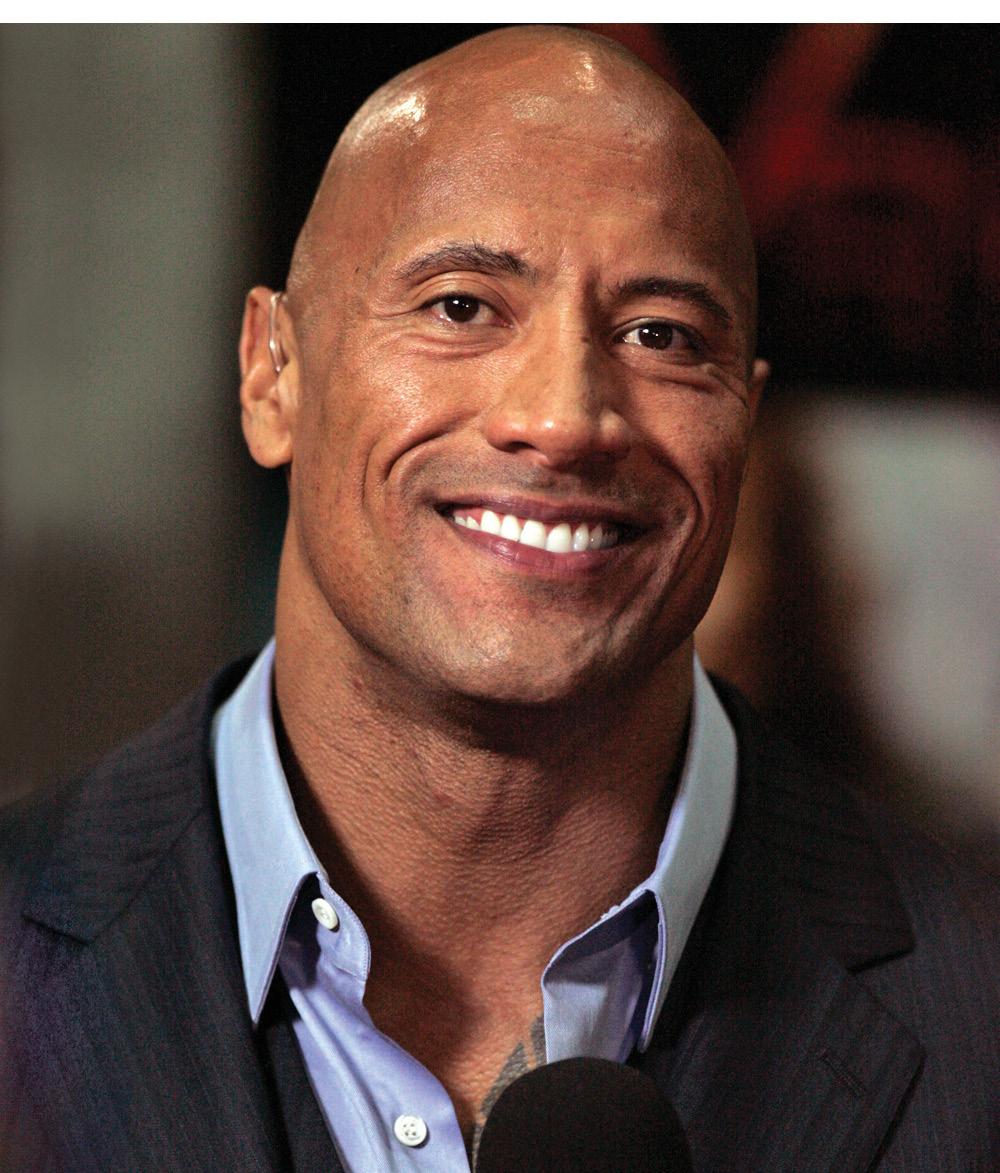
Eva Rinaldi via Wikimedia Commons
Dwayne Johnson poses for a picture at a movie premier at Event Cinemas in Sydney, Australia on March 14, 2013.
By Kiera Faddis Sta Writer
According to local Everglades folklore, the ibis is the last animal to leave to shelter before a hurricane and the first to return after the storm passes. They are known as birds of resilience, which led the Hurricanes to adopt the ibis as their mascot.
Sebastian the Ibis is a well-known symbol of the University of Miami, but UM was not always graced by the energetic bird ’Canes fans know and love.
UM’s first on-field mascot was not an ibis but a white boxer dog named Hurricane I, who made his debut in 1949 at the homecoming football game. Seven years later, Norman A. Whitten, the director of the student union, created the first ibis costume for a homecoming competition entry.
In 1958, a resident of what was then the San Sebastian Hall began performing at games in a new hand sewn and glued ibis costume inspired the homecoming entry. This ibis was nicknamed “Icky” by students.
“In his earliest years, being Sebastian was like being part of any on-campus club. There were no requirements, and anybody was able to join and be part of it,” Daniel Toll, assistant director of athletics marketing and production services, said. “The suit was also very different. It was more stiff, made out of paper mache and not looking anywhere near as athletic as the mascot looks today.”
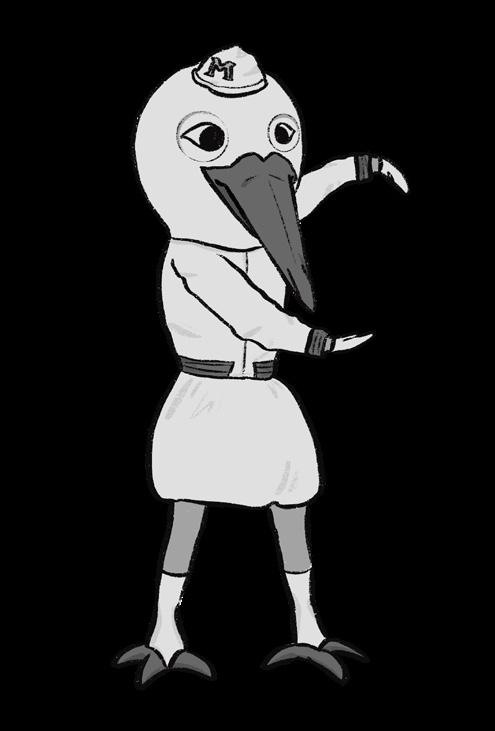
The name “Sebastian” was eventually chosen for
John Stormont, the San Sebastian Hall student under the original ibis costume.
Over the years, the ibis costume evolved, with new details appearing in the 1980s. In 1983, John Routh was hired by Miami Athletics to serve as the Miami Maniac at ’Canes baseball games, then as Sebastian at other sports games and events.
“Routh revolutionized Sebastian’s character to embody the toughness and swagger of the Miami Hurricanes Football team in the 1980s, and that also led to a dramatic wardrobe change,” Toll said.
Routh was scouted by Ron Fraser, the coach of the University of Miami baseball team to perform as the Miami Maniac. When he was scouted, Routh was performing at the College World Series as a professional mascot following his graduation from the University of South Carolina where he also played Cocky the Gamecock.
The iconic ’Canes spell-out, still performed with every football score, was Routh’s creation. It started with the Maniac at baseball games and soon took hold of the football crowds. He describes the moment he remembers feeling like he really changed Sebastian in the 1989 game against Notre Dame, who was ranked number one in the country.
“The crowd was excited, and Sebastian did the spellout during half time, and I just remembered feeling like we had something that would become a tradition,” said Routh.
He is now the executive director of the University of
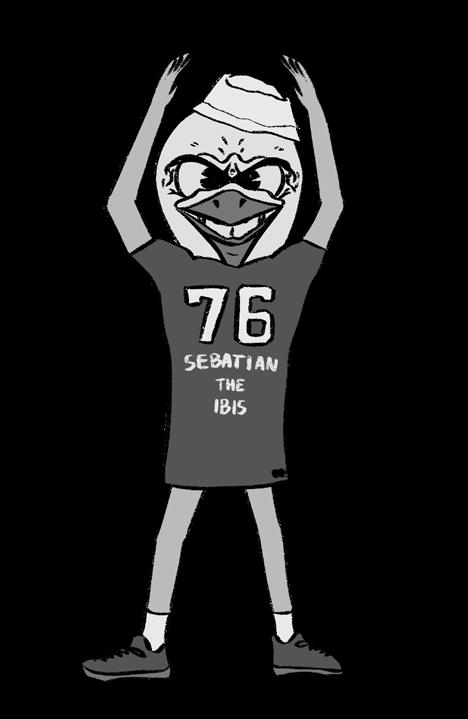
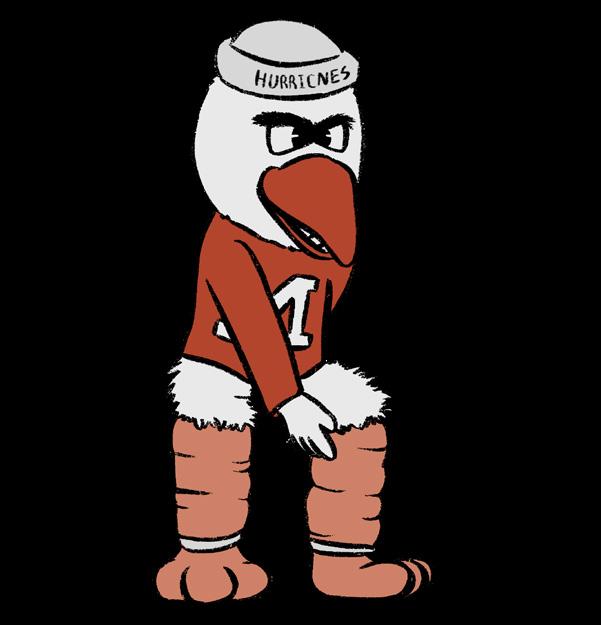
Miami Sports Hall of Fame and Museum.
“It was an honor to portray Sebastian,” Routh said. “I still get a little bit of goosebumps every time Sebastian does the spell-out. I’m proud that it will be done by Sebastian for many, many years after I’m gone.”
Now, tryouts are done to select the perfect students to play Sebastian. The identity of the students are kept a secret during the school year. Their identities are only revealed on graduation day when they walk across the stage wearing Sebastian’s feet.
The University has also expanded its mascot tradition by rebranding another familiar face, Gertrude the Ibis, casually known as Gigi.
“Gertrude is Sebastian’s longtime girlfriend spanning several decades,” Toll said. “In fall 2024, we reinvented Gertrude into Gigi with a brand new suit with the intention of making her character much more integrated and involved in the University of Miami community.”
The reintroduction of Gigi came just a few days after a Sebastian mascot was called out on X for flirting with a Syracuse reporter on the sidelines of a
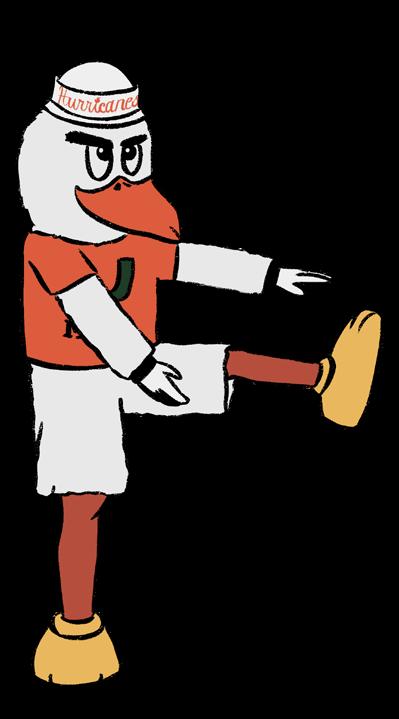
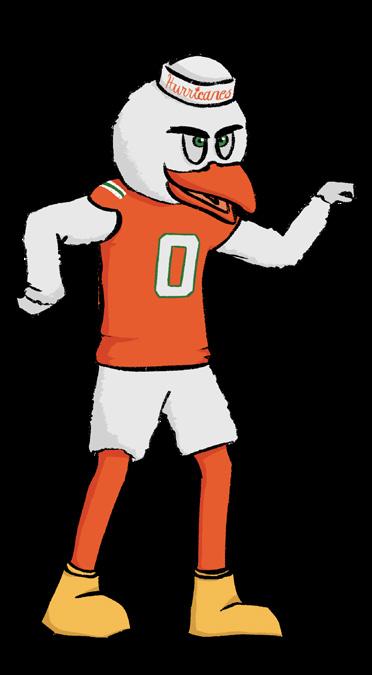
By Jaslyn Troung Assistant News Editor
Homecoming at the University of Miami is the biggest celebration of school spirit. It’s a time-honored tradition that blends history, pride and student energy into one unforgettable experience for the entire university community. Every year, the Homecoming Executive Committee (HEC) has the privilege and responsibility of organizing the entire Homecoming week on campus. Even when the university held its frst Homecoming in 1931, this committee was in charge of organizing Homecoming social functions. Since then, Homecoming has evolved to include new events that unite past and present ’Canes.
There used to be a massive parade that would take place on Stanford Drive. Football players would lead cars in a motorcade, and participation heavily relied on Greek Life, as prizes were given to the fraternity or sorority having the most cars and for best decorated car. It wasn’t until 2004 where Homecoming would begin to shift away its focus on events centered around Greek Life competition. Before the parade, a massive block party known as the Hurricane Howl would be held.
The Hurricane Howl is still celebrated today with food trucks and events on Lakeside Patio.
A notable tradition is the Spirit Tree Ceremony, in which student organizations design their own orna-
ments to decorate the tree. The Spirit Tree was chosen to hold this ceremony because it’s the only orange tree on campus. When the University frst chose its colors, they were inspired by the Florida orange tree - green from the leaves, white from the blossoms and orange from the fruit. After students realized there was no orange tree on campus, the Spirit Tree was then planted and now stands as a signifcant campus landmark.
The gathering of the Iron Arrow Society is also another event that celebrates one of the university’s most sacred traditions. The Iron Arrow Society is the greatest honor at the U, and was founded by President Bowman Foster and former UM student Francis Spencer Houghtailing in 1926. Its members are awarded colorful jackets handcrafted by Micosukee artisans.
Perhaps the most notable tradition during Homecoming is the infamous boat-burning ceremony on Lake Osceola. The boat burning ceremony was originally an effort to promote Theta Chi, the new fraternity, to campus in 1956.
Legend has it that if the mast on the boat falls before the boat sinks, then Miami will win their Homecoming football game. This infamous legend has been passed from Cane to Cane for many decades.
In 1931, Homecoming began announcing themes for each celebration. Past themes include “Are U Game” in 2010, “Make Your Move” in 2016 and “Bring The Beat Back” in 2021. Other new events include the Homecoming concert organized and held
By Nicole Franco Contributing Writer
A century of traditions, trends and styles have taken center stage across decades of UM Homecoming celebrations. For example, tiaras and crowns sit upon the heads of ’Canes who have left their legacy behind, but over the years, the fashion scene has evolved.
Here are some ways ’Canes fashion went from vintage to modern in the past 100 years.
Homecoming Royal Pageant and Parade
The Royalty Pageant has become a cherished and classic tradition that has honored four talented ’Canes with the title of Homecoming Royalty. Over the years, candidates showcased their style through flowy maxi dresses, ball gowns and bodices. In the 1950s, female guests were adorned in polka dot patterns, delicate petals or monochrome satin fabrics. Beaded necklaces and satin gloves were also a common accessory.
Today, the royalty court has expanded to include three more titles and even more flashes of color and pattern into the stoplight. Over time, the dresses have transformed into more modern, sleek, tight-fitted designs, all while staying true to the classic maxi style.
’Canes at Homecoming Pep Rally
In 1963, football cheerleaders brought their unique flair to the game, dressing in bold white, long-sleeved collared shirts with a large, eye-catching “M” in the center and matching midi, pleated skirts and saddle shoes.
It’s entirely different from the sneakers dominating the sidelines now. With fiery passion and unshakable pride, the spirit squads currently wear a sleeveless orange ensemble each adorned with the iconic orange and green “U” at the center.
Today, the co-ed team has made its mark with a dynamic mix of green pleated skirts or pants with orange and white stripes bordering the edges. The look is complete with the name “Miami” embroidered across the shirts and a flash of white boots bring school pride to life.
Dance Team The 1960s dance teams had a Dallas Cowboy Cheerleaders-like style with dancers wearing white, longsleeved collared shirts and shorts. Each ensemble is
adorned with cowboy hats, flashy, white boots and a sparkling belt. Today, the Hurricanettes continue to shine in the sparkling orange and green sleeveless tops paired with athletic skirts adding a burst of color and energy to every performance.
Meanwhile, the Sunsations embrace stylish white apparel with a stitching of a bold “U” at the center, complemented by the traditional white boots or occasionally, sneakers.
With each passing year, Homecoming continues to serve as a canvas for evolving styles and traditions that bring ’Canes together in celebration. Where timeless style meets modern flair, the ’Canes fashion scene is anything but static. Homecoming is a living tapestry that embraces change while honoring its roots.
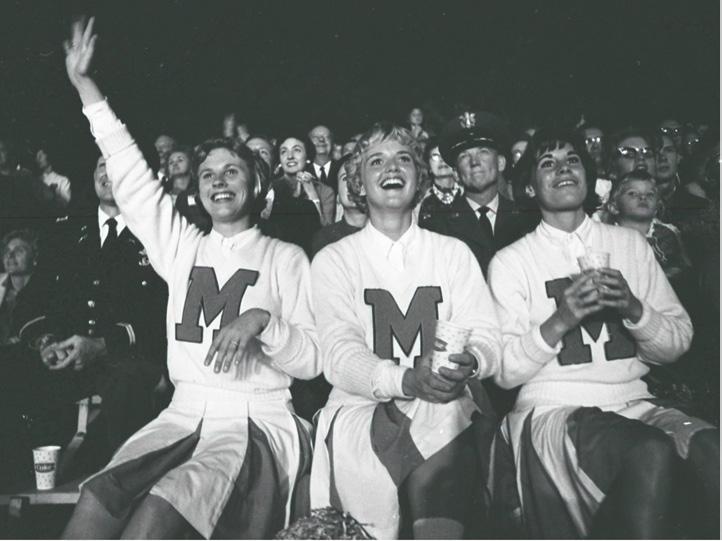
by Hurricane Productions, with notable artists such as Marshmello in 2019 and 21 Savage in 2021.
“Dare to Dream” was the Homecoming theme for this past school year.
“I pitched this theme earlier this year, and my inspiration was the endless possibilities I’ve encountered as a student,” Hurricane Howl subcommittee member Hanna Ebrahimi said in an interview with News@ TheU. “Throughout my journey at UM, I’ve grown into a more confdent, resilient, and ambitious version of myself. For this reason, I don’t think ‘Dare to Dream’ is just a theme; it’s a call to action for all of us. It encourages us to look beyond our current realities and envision a future flled with possibilities.”
For many students, being involved in planning the Homecoming celebration is also a way for them to celebrate their journeys as students here at the U. “UM Homecoming means a celebration of my entire college journey. Every Homecoming, I have had the opportunity to refect on all of the experiences at the U, as well as the amazing community of people I share these experiences with,” senior Katie Schumann said in an interview with News@TheU, another member of the Hurricane Howl subcommittee.
As the University of Miami celebrates its 100-year anniversary, Homecoming traditions remain stronger than ever and continue to ignite the spirit that makes this university truly special.
Read more online at themiamihurricane.com.
“ UM Homecoming means a celebration of my entire college journey . Every Homecoming, I have had the opportunity to reflect on all of the experiences at the U, as well as the amazing community of people I share these experiences with.”
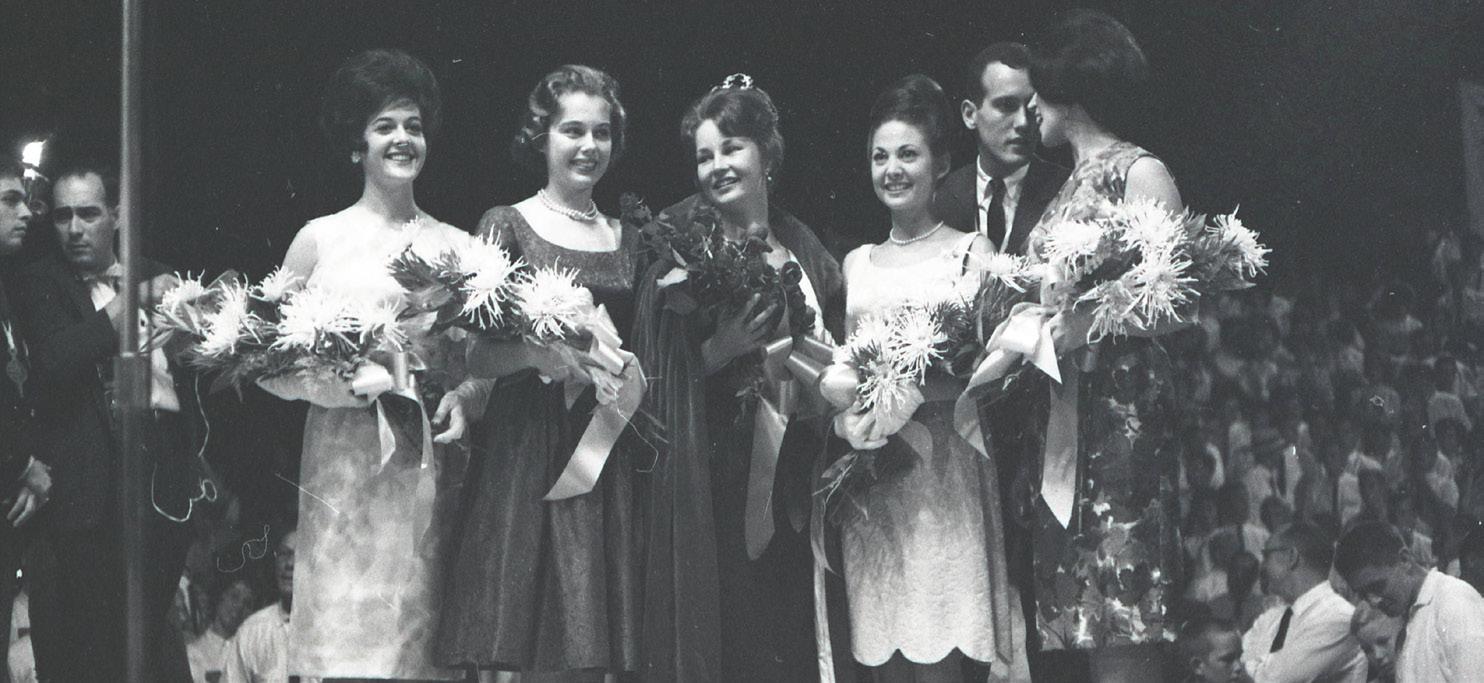
By Patrick McCaslin Staff Writer
One month after the University of Miami opened in 1926, on a November afternoon, Dr. Bowman Foster Ashe approached UM’s first enrolled student, Francis Houghtaling, with his fledgling concept for an honor’s society. Houghtaling had recently proposed a fraternity with “an Indian ritual” to Ashe – the University’s first president –who had told Houghtaling to save the idea for a better purpose.
Now, Ashe had that better purpose. He excitedly delivered his vision for the Iron Arrow honors society in the middle of Houghtaling’s physics lab, standing atop a lab stool. It would be a society for the school’s top scholars. Ashe asked Houghtaling to select the initial group of what would be a tapping society – where members are selected without applications – that would employ the traditions of Florida’s indigenous people.
manders, and removing racist depictions of Native Americans in pop culture.
As Krystle Young Bowers, a member of the Seminole Tribe of Florida and a University of Miami alum, sees it, “Indigenous peoples both on campus and throughout Florida are deeply wounded, alienated, offended and angered by the practices of the Iron Arrow Society. The presence and actions of Iron Arrow affect not only life on campus but extend throughout Florida in everything the society does.”
That language comes directly from a petition Bowers circulated in 2022, which obtained over 1,000 signatures from students and members of the Miccosukee. The petition concludes, “If Iron Arrow exists to be a vessel for cultural exchange as it claims, it has failed at its purpose and should be dissolved. The society does not understand nor observe the Seminole-Miccosukee culture, sovereignty or religion as shown through their wildly inaccurate rituals.”
“He recognized the nobility of the native people So, his idea was [to] pattern the organization after the native people, which, down here, are the Everglades Seminole. It would be a testimony to [them].”
Johann Ali // Unofficial Iron Arrow Historian
Flash forward to 2022, when the Student Government Senate voted overwhelmingly (28-5 with seven abstentions) on a resolution asking the University to disaffiliate itself from Iron Arrow, the honor society that Ashe created.
In UM’s own words, Iron Arrow is “the highest honor attained” at the University, an organization comprising “those who excel in scholarship and leadership.” Its history is intertwined with the school’s, having been founded in the same disastrous year that UM endured the Great Miami Hurricane, later surviving several major campus evolutions and all-the-while acting as an integral part of the University’s culture.
Today, Iron Arrow can count the international pop icon Gloria Estefan, current UM president Joe Echevarria, former Dolphin’s punt returner Braxton Berrios, and Dean of the Miller School of Medicine Henri Ford as its members. Every semester, it welcomes over a dozen more high achieving students, faculty and alumni to its prestigious ranks.
What motivated the SG Senate to call for its dissolution?
At issue is Iron Arrow’s complex relationship with the Native American Miccosukee tribe, formerly of the Seminole tribe before their split in 1959. The honor society’s members wear handmade Miccosukee jackets, bang drums and perform a wordless tapping ceremony where inductees are grabbed and led to “the rock” at the center of campus, later to be initiated in an Everglades tradition shrouded in secrecy. All of this is done with the blessing of current and past leaders of the Miccosukee.
As described by Iron Arrow, the leaders of the Miccosukee Tribe and the University of Miami, Iron Arrow “acknowledges, praises and practices the traditions and culture of the Miccosukee.” That line comes from a memorandum of understanding issued by the three parties in 2018 to reaffirm Iron Arrow’s relationship with the tribe. Over the last decade, however, there has been a growing movement to end stereotypical characterizations of Native Americans, leading to such things as changing the name of the NFL team The Washington Redskins to the Washington Com-
The petition calls on UM to issue a public apology, sever its ties with Iron Arrow, and rectify the damage done by Iron Arrow.
Can these views be reconciled?
Iron Arrow leaders see the society as a symbol of utmost respect for the Miccosukee and tribe leaders have repeatedly affirmed their relationship with Iron Arrow. However, critics see Iron Arrow as another example of culturally insensitive misappropriation and patronizing.
“It makes you a caricature,” Bowers said in an interview with Coral Gables Magazine. “Outsiders really don’t even care to know our history or know us, but they’ll protect these mascots.”
To fully understand the controversy requires a lesson in history.
1926: Iron Arrow is born alongside an infant university and city
In the fall of 1926, Ashe opened the University of Miami as a labor of love. When the cataclysmic Great Miami Hurricane hit that September, delaying the university’s opening, Ashe relocated to an unfinished hotel, later the Biltmore, using cardboard walls to partition the rooms. He lived full-time on campus with his wife, sleeping in the dorms and eating with the students in the dining hall. When the University’s already immense debts worsened during the Great Depression, Ashe even borrowed upon his personal insurance policy to pay professors.
Embedded in Ashe’s passion for the University of Miami was his parallel desire to create an honors society like the elite institutions in the northeast, a tradition that UM could, too, wear like a crown.
So, shortly after UM opened in that fateful year of 1926, when George Merrick’s dream of Coral Gables foundered on the Hurricane-induced collapse of the Florida housing market, he pushed forward to create Iron Arrow, using all the trappings of Florida’s Native Americans – their clothing, their musical instruments, their rituals and their deep relationship with the Everglades.
“He recognized the nobility of the native people,” says Johann Ali, unofficial Iron Arrow historian. “So, his idea was [to] pattern the organization after the

native people, which, down here, are the Everglades Seminole. It would be a testimony to [them].”
Florida’s indigenous people settled the southern half of the state 8,000 years ago, living atop mounds of earth heaped above Florida’s waterline. They slowly split into distinct cultures that were collectively labeled centuries later by the colonizer’s name, “cimarrones” which was anglicized to “Seminole.”
The indigenous people used the colonial Seminole name grudgingly in their dealings with Americans, but later adopted it at the onset of the Seminole Wars in the early 1800s as a symbol of common resistance against the hostile U.S. colonists. Through the Seminole Wars and the Indian Removal Act, which included the infamous Trail of Tears, the Americans tried to uproot all Seminole people from their land, but several bands refused to surrender and remained in the Florida Everglades.
Ashe turned to these people, the Florida Seminoles, to finish envisioning Iron Arrow. Tony Tommie, an English-speaking Seminole, rose to the task. Tommie had completed two years of public school in Fort Lauderdale and attended boarding school for another four years, contributing to his fluency in English and his comfort in engaging with the white American.
While in Fort Lauderdale, Tommie became the spokesperson for the Fort Lauderdale Seminoles. The press misunderstood his role and labeled him “Chief” of the tribe.
Ashe, Houghtaling and the other founding members of Iron Arrow collaborated with Tommie in creating the society’s traditions, under the impression that Tommie was a bona fide leader of the Seminole Tribe. With Tommie, they created an initiation tradition for new members of Iron Arrow that endures to this day, albeit somewhat modified.
During the tapping ceremony, inductees are grabbed by the arms and silently taken to “The Rock” at the center of campus. For much of Iron Arrow’s history, that process was accompanied by the continuous beating of a drum which reached a crescendo at the point of the inductee’s “presentation” to the Iron Arrow Chair. The ceremony is patterned after a Miccosukee rite of passage, which was “gifted” by Tommie at the society’s inception. It later concludes deep in the Everglades with a secretive initiation ceremony that, according to Ali, “is a time for very deep reflection and listening.”
Other traditions Tommie initiated have since been altered through a continuous process of feedback and guidance from Miccosukee leadership. Shortly after granting these “gifts” to Iron Arrow, Tommie became a pariah of the Florida Seminoles. The Seminole Tribune writes that Tommie swore Seminole allegiance to the United States without consulting with the tribe and participated in an event with Miamians where he symbolically gave Seminole land away to his “white brothers.” The issue became so pressing that the tribe’s Medicine Man wrote a letter angrily denouncing Tommie as “a fakir and traitor to his tribesmen,” accusing him of seeking only publicity and financial gain for himself.
Even as Tommie’s actions during the founding of Iron Arrow remain questionable, multiple Miccosukee leaders following Tommie have affirmed their relationship with Iron Arrow. “We asked them, ‘How do we go about this to make sure that we’re keeping with the things that we’ve committed to and promised to do?’” Ali says. “If the Miccosukee leadership came to us tomorrow and said, ‘No more,’ we’d be like, ‘Okay, no more.”
1943-1985: Tough times and a temporary divorce Around the onset of World War II, Iron Arrow began to falter. The depression and draft had hit the University hard, and administration even called into question whether UM would reopen in the fall of 1943. Yet, the society persisted, spurred on by a 1944 editorial from The Miami Hurricane, UM’s student newspaper, titled, “We Need Iron Arrow” and a resurgence in alumni support. In 1950, shortly before Ashe’s death, the University of Miami granted a charter to Iron Arrow, confirming it as the “highest honor attained” at UM. Iron Arrow thrived from that point forward, steadily overcoming financial obstacles and embedding itself as an ongoing UM tradition.
In May of 1973, however, criticisms of Iron Arrow reached the federal government in the form of a complaint that Iron Arrow discriminated against “Indians” and “females.” The first issue was resolved five months later.
“We do not find evidence to support a claim that the Society’s use of Indian ritual and appurtenances is, per se, demeaning of either Seminole or Mikasuki [sp] Indians or Indians in general,” read a letter summarizing the investigation to Dr. Henry Stanford, then president of UM. “Our investigating has included an analysis of the society’s constitution and ritual, as well as contacts with Indian persons knowledgeable about Seminole and Mikasuki tribal customs and Iron Arrow itself.”
Iron Arrow’s steadfast refusal to admit women to its society was another matter. Iron Arrow was in violation of the 1972 Title IX civil rights law which prohibited sex-based discrimination. The federal government forced the University of Miami to disassociate from Iron Arrow in 1976 until the society allowed women to join. Iron Arrow sued the federal government, but President Foote, inaugurated in 1981, refused to reallow Iron Arrow unless they permitted women to join, regardless of the outcome of the lawsuit.
After six previous attempts, Iron Arrow finally voted to allow women in 1985 at a special meeting. Ali explains that the group in charge of Iron Arrow at the time was defiant due to their close relationship with the Miccosukee.
“They pride themselves on their sovereignty, and that nobody will ever tell them what they should and shouldn’t be doing,” Ali says.
The old guard of Iron Arrow refused to allow women to enter, but the new guard insisted on allowing women to enter, finally winning the vote.
The Controversy Anew Krystle Young Bowers first became aware of Iron Arrow during her freshman year, in 2009. As a member of the Seminole Tribe of Florida, she had never heard of the society and was initially confused by the sound of drums and people wearing tribal jackets.
“I didn’t really expect it to be something the school was supporting and putting on with non-tribal members,” Young Bowers says. “Then I got closer and saw it clearly wasn’t people from my tribe.” She learned later that part of the society’s requirements, at the time, included continuous banging on a hand drum. “That’s a weird cultural appropriation thing that I guess they think we do,” Young Bowers said.
Several years later, Young Bowers returned to UM as a master’s student, coinciding with a time of increased scrutiny of Iron Arrow and its practices. In 2018, Iron Arrow hosted a community-wide discussion forum with members of the Miccosukee tribe.
“What came out of that conversation were some of the things that we ended up changing. We went into a period of very deep reflection and revision,” Ali said. “Wherever we could not identify positively where something came from, if it did not stem from the Miccosukee, we either eliminated it or figured out how to modify it.”
For example, the practice of using face paint as a way of indicating new members was discontinued.
“We couldn’t positively identify where it came from, and so we eliminated it,” Ali said.
Also, in that time, Iron Arrow made a shift from providing charity to the Miccosukee to focusing on other resources. “They don’t need the money. What they need is knowledge and they need resources to help them accomplish their goals,” Ali says.
What that looks like in practice is a partnership with the Miccosukee Indian School to host tours on UM’s campus and to hold roundtable discussions with representatives from the Miccosukee Indian School, the campus health center, and some of the people that work in the environmental resilience space. Later in 2018, the tribal liaison, UM President Julio Frenk, and Iron Arrow faculty advisor Adrian Nuñez signed the memorandum of understanding that enshrined the Miccosukee’s endorsement of Iron Arrow.
It concludes, “This joint declaration shall remain valid, in perpetuity, until otherwise decided by the Miccosukee Tribe of Indians of Florida or the Iron Arrow Honor Society, severally.”
Despite the MOU, Young and other members of the Miccosukee and Seminole tribes believed further change was necessary.
“After seeing the ‘tapping ceremony,’ I thought to myself, if this is what we signed off on – to have a relationship with UM – can we renegotiate?” asks Amarys Huggins, a Miccosukee member of the Bird Clan. “I am a lifelong University of Miami fan, so it is a bit upsetting to see what used to be my dream school allow a group to mock Indigenous people.”
In 2020, Iron Arrow announced that it would no longer use the leadership titles of chief, son of chief and medicine man, discontinue the folding of arms, and limit the drumming to a few beats instead of the entire ceremony. However, due to the COVID-19 pandemic, Iron Arrow didn’t vote on the matter until 2022 – by which time opposition against Iron Arrow’s practices had swelled.
“I didn’t really expect it to be something the school was supporting and putting on with nontribal members. Then I got closer and saw it clearly wasn’t people from my tribe .”
Krystle Young Bowers
A Member of the Seminole Tribe of Florida and a University of Miami Alum
That was the year Young Bowers created her petition, accruing over 1,000 signatures. An Instagram post from an indigenous student denouncing Iron Arrow for harming indigenous students circulated campus, receiving over 2,500 likes. Protesters at Iron Arrow’s 2022 tapping ceremony held up signs saying, “Big nope to racial trope” and “We are NOT your tradition.”
The Miccosukee tribe’s official position has been to not intervene with anything on campus. That position is set by the General Council, a group of elected officials in the Miccosukee tribe. Nonetheless, members of the Miccosukee Tribe, the Seminole Tribe of Florida, and other UM students have repeatedly expressed their rejection of Iron Arrow.
“Although the general council is made up of tribal members, not all views and beliefs are reflected in decisions made by GC. IA will always be mockery and not appreciation as long as they keep playing dress up. As long as they keep acting like they’re one of us,” Huggins says. “None of them have faced the hardships we have faced as Miccosukee people.”

By Max
By Zach Cohen
Cam Ward Cam Ward brought the Hurricanes back to national relevance during his all-time great season in 2024, leading the Hurricanes to their frst 10-win season since 2017. In his one season as a Hurricane, Ward threw for 4,313 passing yards, becoming the program’s single-season passing yards leader. In addition Ward broke the single season passing touchdown record with 39. His 155 career touchdown passes tie the Division I record held by former Houston quarterback Case Keenum. Some of his most memorable moments in orange and green include his game-winning touchdown pass against Virginia Tech and the orchestration of the Hurricanes’ comeback against California. Not only this, but Ward put some incredible hardware in his trophy case. He won the Davey O’Brien Award in 2024, which is given to the nation’s top quarterback. He was also named the ACC Player of the Year and the ACC Offensive Player of the Year. To cap off his historic season, he was named a Heisman Trophy fnalist. Ward went from a zero-star recruit to a Heisman fnalist – a story ’Canes fans will always remember.
Ken Dorsey
One of the all-time best quarterbacks Ken Dorsey led Miami to the 2001 onship. In his title-winning season, he threw for 2652 yards with 23 downs. In the championship game, he set a career high for passing with 362 as Miami soundly defeated Nebraska 37-14. Dorsey led the ricanes to back-to-back national championship appearances in 2002, where they would fall to the Ohio State Buckeyes. By the end of Dorsey’s career in a Miami uniform, he led in almost every passing category, including passing yards (9,565) and passing touchdowns (86). He also was the only Hurri cane to throw for 20 or more touchdowns in three consecutive seasons. Some of Dorsey’s most iconic moments were against rival Florida State. As a starter, he had a perfect 3-0 record against the Seminoles, most notably a comeback victory in 2002. Dorsey was inducted into the UM Sports Hall of Fame in 2013 and now serves as a passing game specialist for the Dallas Cowboys.

By Wrigley Kordt
The University of Miami’s football program has been home to some outstanding running backs, but Edgerrin James’ rare blend of speed, power and consistency sets him apart from the pack. His 2,960 rushing yards rank third in program history, and he’s the only Hurricane to put together back-to-back thousand-yard rushing seasons. In 1997, his frst season as a full-time player, James ran for 1,098 yards and 13 touchdowns on just 184 carries. That included a 271-yard performance against Boston College, which set a program record for single-game rushing yards. But that record didn’t last for long. The very next year, he put up 299 yards in an upset win against UCLA to cap off the regular season. James fnished that season with 1,416 yards and a conference-leading 17 touchdowns, earning him First-Team All-Big East honors.
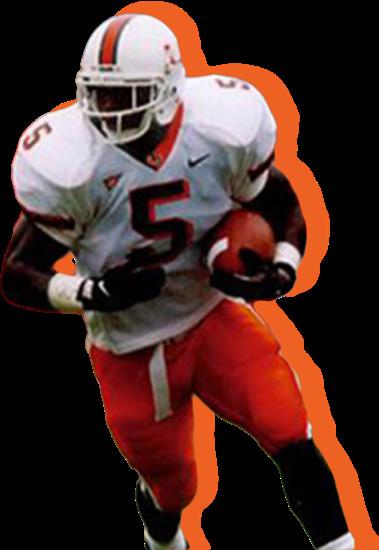
There’s a whole host of players who could have taken this second spot: Ottis Anderson, Clinton Portis, James Jackson — the list goes on. But none achieved the single-year success of Willis McGahee, whose 2002 season shattered Miami’s record books. After rushing for only 314 yards in 2001, the Miami Cen tral High School product broke out with a 204-yard game in a week two road game against Florida. From there, McGahee torched opposing defenses, putting together 10 100-plus yard performances. His best showing came in the regular season fnale against Virginia Tech, when he rushed for 205 yards and a program-record six touchdowns en route to a 56-45 victory that secured Miami’s spot in a second consecutive national championship game. Altogether, McGahee racked up a program-record 1,753 yards and 28 touchdowns while averaging over six yards per carry. His 28 touchdowns are the third most in NCAA single-season history. He was named a consensus All-American, First Team All-Big East and Big East Co-Offensive Player of the Year (he shared the award with Dorsey). McGahee fnished fourth in Heisman voting and was a frst-round pick by the Buffalo Bills.
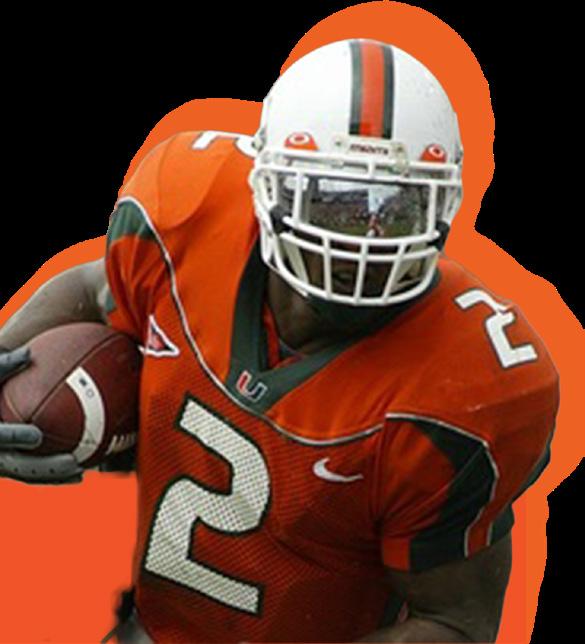
By Ali Campbell
A four-year starter for the Hurricanes, Reggie Wayne was one of the most consistent and reliable receivers to ever grace a UM uniform. He suited up in Coral Gables from 1997–2000 and made an immediate impact on Miami’s offense, displaying his talent that would eventually land him in the college record books. As a freshman in 1997, Wayne was named the Big East Rookie of the Year to go along with Second Team All-Big East honors for his dominant performance throughout the season. He posted 48 catches for 640 yards, leading the team and breaking Michael Irvin’s freshman record of 46 receptions. The following season, Wayne again led the ’Canes with 42 receptions and was second in receiving yards with 629, even while enduring a torn ACL during the season. Wayne’s best season came during his senior year, when he once again led the team in receptions and receiving yards, with 755 and 43, respectively, all while scoring 10 touchdowns on the season. This marked second all-time behind Irvin’s 11 receiving touchdowns in 1986. Wayne also holds the record for receptions in Miami history with 173. He’s second only to Irvin in receiving yards and is tied for third all-time in receiving touchdowns with 20. He holds the record for most consecutive games with a reception with 36. Wayne was drafted in the frst round of the 2001 NFL draft by the Indianapolis Colts, where he teamed up with Hall of Famers Marvin Harrison Sr., Peyton Man ning and fellow Hurricane Edgerrin James. Wayne was an essential piece in the Colts’ offense for years and helped lead them to victory in Super Bowl XLI in 2007 over the Chicago Bears.
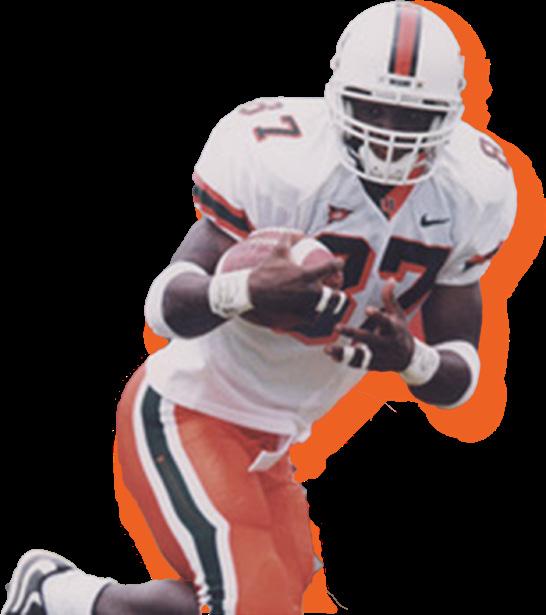
Michael Irvin is considered one of the most legendary receivers in Miami’s history and is among the most prolifc players the university has ever had. He became a starter during his redshirt freshman campaign in 1985 and earned Freshman All-American honors from Football News that same year. In 1986, he received UPI All-American honors, and as a junior in 1987, he was recognized as an honorable mention All-American by both Football News and the Associated Press. During the 1987 season, Irvin played a crucial role in helping the Hurricanes achieve an undefeated season and secure the national champi onship. One of the most memorable moments in the school’s history came that year, when he caught a 73-yard touchdown pass from quarterback Steve Walsh in the fourth quarter. This play was pivotal, as it ultimately determined the outcome of Miami’s game against archrival Florida State. His rare combination of route-running, speed and height made him a go-to target in the Hurricanes’ high-powered offense. By the time he left for the NFL, he had set school records for receiving yards (2,423) and touchdown receptions (26) that stood for years. Irvin’s success as a Hurricane would lead him to get drafted 11th overall by the Dallas Cowboys in the 1988 NFL Draft, where he’d emerge as one of the NFL’s best wide receivers of all time, putting up career numbers of over 11,000 receiving yards and 65 touchdowns. Teaming up with quarterback Troy Aikman and running back Emmitt Smith, Irvin helped lead the Cowboys to three Super Bowl titles in the 1990s. Though his NFL career was legendary, it was at Miami where he frst became a star, helping craft the Hurricanes into a dynasty and leave a mark on college football history.
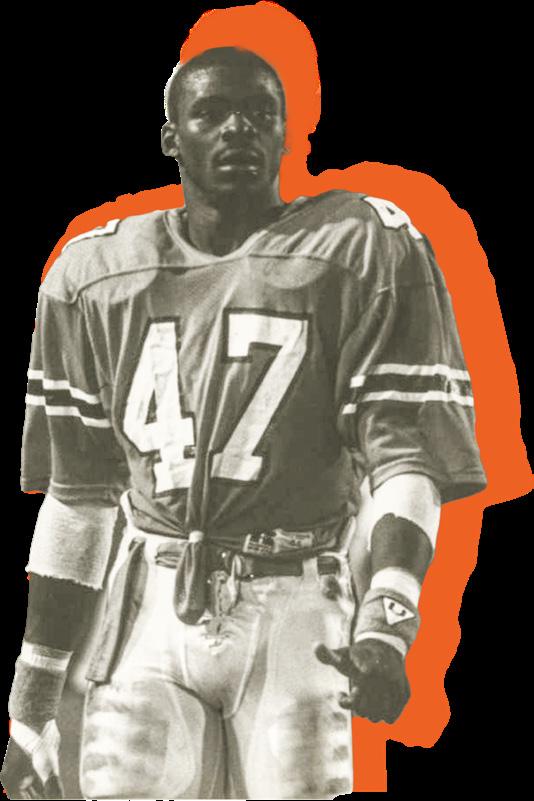
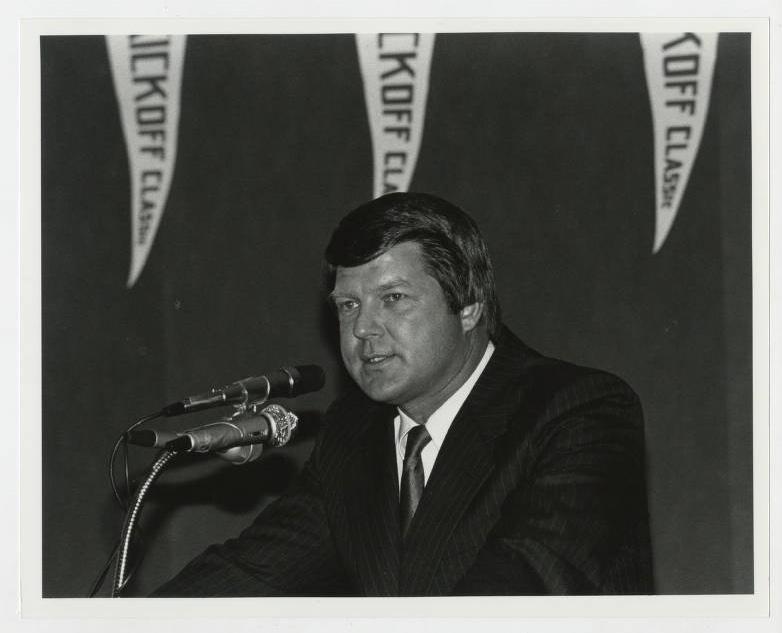
Domination and swagger. That was what the Jimmy Johnson era in Miami was. After Howard Schnellenberger left the Hurricanes after the 1983 National Championship for the USFL, Johnson was brought to Miami after leading the Oklahoma State Cowboys for the past fve years. After a subpar frst season in 1984, only going 8-5, the next four years of Johnson were brilliant. In those fnal four seasons with Johnson, the Hurricanes went 44-4, won the 1987 National Championship and were the runner-ups in 1986 and 1988. Johnson’s teams produced greats like Vinny Testaverde, Jerome Brown, Alonzo Highsmith, Bennie Blades, Brian Blades, Danny Stubbs, Michael Irvin and many other legendary players. Schnellenberger brought the ’Canes to the top, and Johnson made them into a powerhouse. In 1989, Johnson left the Hurricanes to take the helm of the Dallas Cowboys. With the Cowboys, he built one of the most famous dynasties in NFL history with his coaching and drafting talents. Under Johnson, the Cowboys won back-to-back Super Bowls in 1992 and 1993.
A junior college product of Northeastern Oklahoma A&M, Shockey transferred to Miami in 2000, putting up historic numbers in his
two years in Coral Gables. In his sophomore year, Shockey rose to the occasion against then-No. 1 ranked Florida State. He caught three passes on Miami’s fnal drive, including the game-win ning touchdown with 46 seconds on the clock, sealing a 27-24 victory. In 2001, Shockey was a key member of that legendary Miami team, being named to the First Team All-Big East and being a fnalist for the John Mackey Award. He fnished his junior year with 40 catches, 519 yards and seven touchdowns. He currently stands among the best in program history among tight ends for receptions and receiving touchdowns. Drafted No. 14 overall by the New York Giants in 2002, Shockey continued to dominate in the pros. He fnished his NFL career as a four-time Pro Bowler and two-time Super Bowl champion. He was also an All-Pro in his rookie season.
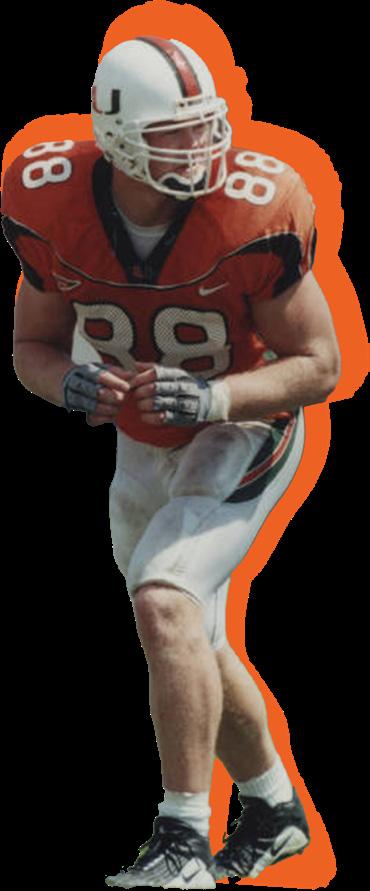
Ranked as the second-best tight end in the country in 2003 by Rivals, Greg Olsen originally committed to play football at Notre Dame. The Wayne, N.J. native realized South Bend wasn’t the place to be for his brother Christian and him. While Christian went on to play quarterback at Virginia, Greg headed to sunny South Florida. After redshirting his freshman year, Olsen had his fair share of playing time in 2004, serving as a backup tight end and getting reps at long snapper for punts. “G-Reg” got his chance to be the Hurricanes’ starting tight end in 2005, earning an honorable mention All-ACC nod. In his sophomore year, Olsen had 31 catches for 451 yards and four touchdowns. He had a career day during the season opener against rival Florida State, where he totaled eight catches for 137 yards. Olsen continued making strides in 2006. In his junior year, he was named First-Team All-ACC in his best season as a ’Cane. He tallied 40 catches for 489 yards and one touchdown. His performance in 2006 led him to becoming the frst tight end drafted in 2007. Olsen was drafted No. 31 overall by the Chicago Bears. Olsen had a 13-year career, making the most of it with the Carolina Panthers.
By Max Diaz
At 6-foot-8 and 352 pounds, Bryant McKinnie was an absolute monster at left tackle for the Hurricanes during the 2000 and 2001 seasons. Originally from Woodbury, New Jersey., McKinnie was frst at Lackawanna College in Scranton, Pennsylvania, where he gained 70 pounds and switched positions from defensive lineman to offensive tackle before transfer- ring to The U. After redshirting the 1999 season, McKinnie began to dominate from the get-go. In his two seasons as a starter, McKinnie was a two-time unanimous First-Team All-Big East member and a two-time All-American (one of which was unanimous in 2001) and was named the CNN/Sports Illustrated Player of the Year. He also won the Outland Trophy, awarded to college football’s best interior offensive lineman, and the Jim Parker Trophy, which recognizes the best offensive lineman in the country, in 2001. More than accolades, McKinnie never allowed a sack during his time at UM. After college, McKinnie was the seventh overall draft pick in 2002 by the Minnesota Vikings. His NFL career lasted 12 seasons, with highlights of a Pro Bowl selection in 2009 and a Super Bowl ring with the Baltimore Ravens in Super Bowl XLVII. McKinnie was inducted into the College Football Hall of Fame in 2023.

A member of three Hurricanes championship teams in 1987, 1989 and 1991 and a starter in the latter two of them, Leon Searcy was one of the most experienced Hurricanes to ever protect the quarterback. ery game during his last three seasons where he protected UM greats like Craig Erickson and Heisman winner Gino Torretta, being a wall at both the left and right tackle positions. In the 1992 Orange Bowl Championship game against Nebraska, the player who started at the other tackle posi tion along with Searcy was current Hurricanes head coach Mario Cristobal. That fnal season for Searcy was his most decorated in his time at Coral Gables. He earned First-Team All-America honors from the Football Writers Association of America and Second-Team All-America honors from The Football News, The Sporting News and Associated Press. He was also a member of the inaugural First-Team All-Big East. Searcy was drafted No. 11 by the Pittsburgh Steelers in 1992 and had an 11-year career that featured a Second-Team All-Pro and Pro Bowl selection in 1999.
Mike Sullivan
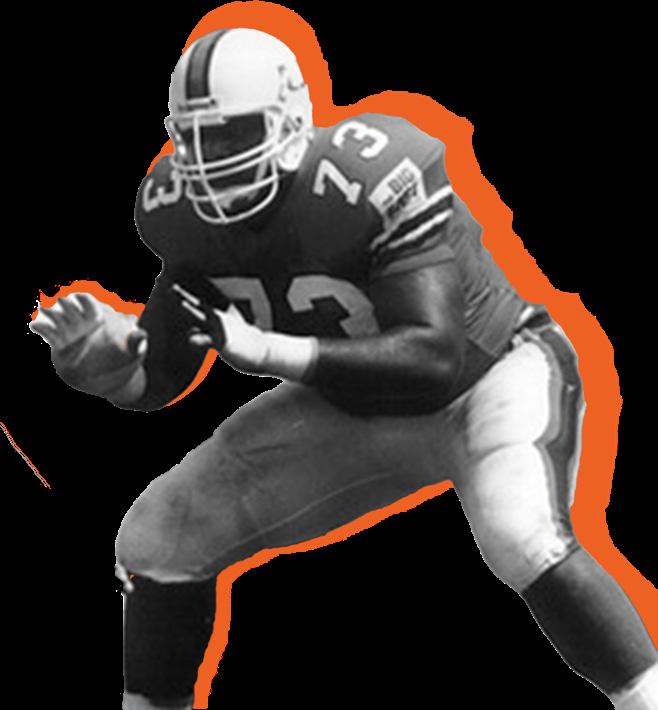
By Max Diaz
Miami has always had some of the toughest players in college football, but few can compare to Mike Sullivan. Sullivan played both left guard and left tackle while at Miami and started 48 consecutive games, a school record at the time, during his four-year collegiate career. He did this despite many injuries and the removal of a tumor near his ear. With Sullivan guarding the quarterback’s blind side, he saw a lot of suc cess with the ’Canes. When Sullivan was at Miami, it went 44-4, won two national championships in 1987 and 1989 and won the frst 36 games of the NCAA record 58-game home winning streak at the Orange Bowl. Sullivan was named First Team All-South Independent twice, Second Team AllSouth Independent in 1988 and Second-Team All-American in 1990, and he won the CBS/Toyota Leadership Award twice. Those leadership awards were a window into the future for Sullivan, because after his football career, he went on to be a coach in the NFL. He is currently the assistant offensive line coach for the Tennessee Titans.
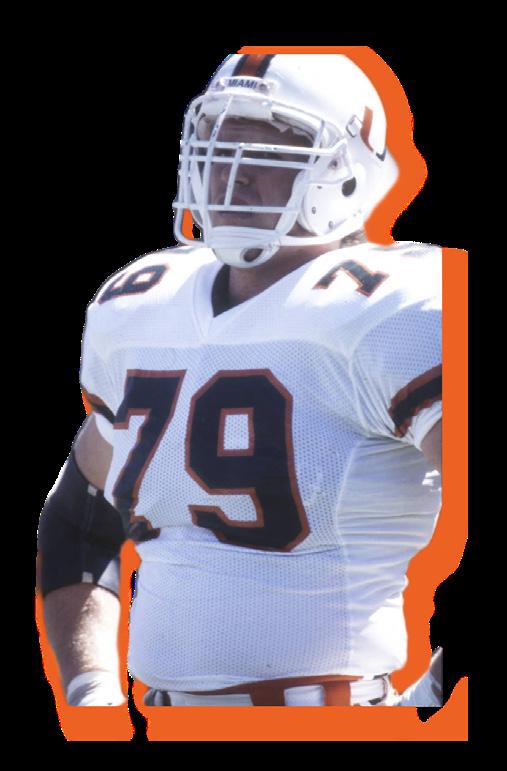
The University of Miami features one of the most prolifc college football programs the sport has ever seen. 384 professionally drafted players, 36 Consensus All-Americans and two Heisman Trophy winners have led Miami to fve national championships throughout its storied history. Here’s the Hurricanes’ all-time football roster, carefully crafted by the sports staff at The Miami Hurricane.
By Max Diaz
By Max Diaz
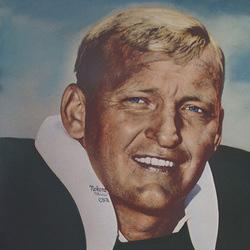
Arguably the greatest American Football League/NFL center of all time, Jim Otto got his start at Miami back in the late 1950s. A native of Wausau, Wis., Otto played for the ’Canes from 1957–59. Otto was an undersized center and a linebacker who played on both sides of the ball. Despite being relatively small for his position, Otto built a reputation throughout both his college and professional career for being as tough as nails. Throughout his life, Otto had over 70 football-related surgeries, including an amputation of his leg. However, when there was a game to be played, he rarely missed it. In his 15 seasons in the AFL and NFL with the Oakland Raiders, he started 210 straight league games. Otto was a nine-time First-Team All-AFL, a First-Team AllPro in 1970 and one of only four centers to be included on the NFL 100th Anniversary team. Otto was one of the original legendary Hurricanes as he was the frst former UM player to be inducted into the Pro Football Hall of Fame in 1980.
The 2001 Miami Hurricanes are undoubtedly one of the greatest college football teams of all time, and the offensive line was no exception. Holding down the middle was the On- tario, Canada native, Brett Romberg. From 2000-02, Romberg started 37 consecutive games at center for Miami, 35 of which were wins. Romberg had one of the most deco- rated careers on the offensive side of the trenches for the Hurricanes. During his tenure, he won three Big East titles and a BCS national championship in 2002. He also made three FirstTeam All-Big East teams, was a con- sensus All-American in 2002 and won the Rimington Trophy, awarded to the nation’s best center, and Jim Parker Trophy in 2002. In addition to his accolades, Romberg was part of offensive lines that produced three straight 1,000-yard rushers in Jackson, Portis and McGahee, and he did not allow a sack throughout his collegiate career.
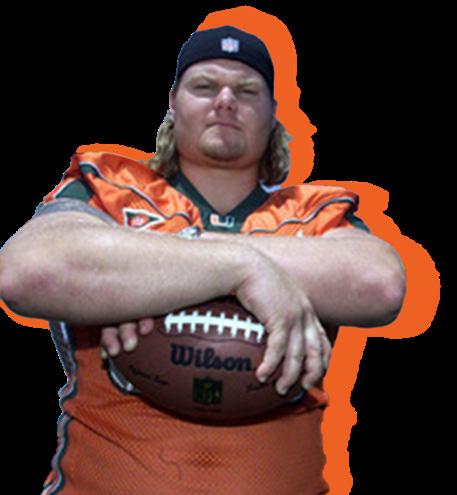
By Jayden Gonzalez
Ray Lewis
In a group headlined by Warren Sapp, Cortez Kennedy and Vince Wilfork, Jerome Brown stands alone as the best defensive tackle in Miami Hurricanes history. The Brooksville, Florida. native joined the Hurricanes under Howard Schnellenberger in 1983. The defensive tackle made his mark in his senior season in 1986, earning consensus All-American honors. He was also a fnalist for the Outland Trophy and the Rotary Lombardi Trophy. He fnished his Miami career with 21 sacks, 183 tackles and fve forced fumbles. He still sits 10th on UM’s leaderboard in sacks. Brown was drafted ninth overall in the 1987 NFL Draft by the Philadelphia Eagles, racking up two All-Pro designations in his four-year career. In 1992, Brown sadly passed away in an automobile accident in Brooksville at the age of 27. In 1996, the Philadelphia Eagles posthumously inducted him into their Hall of Fame. A year later, the Hurricanes followed suit.
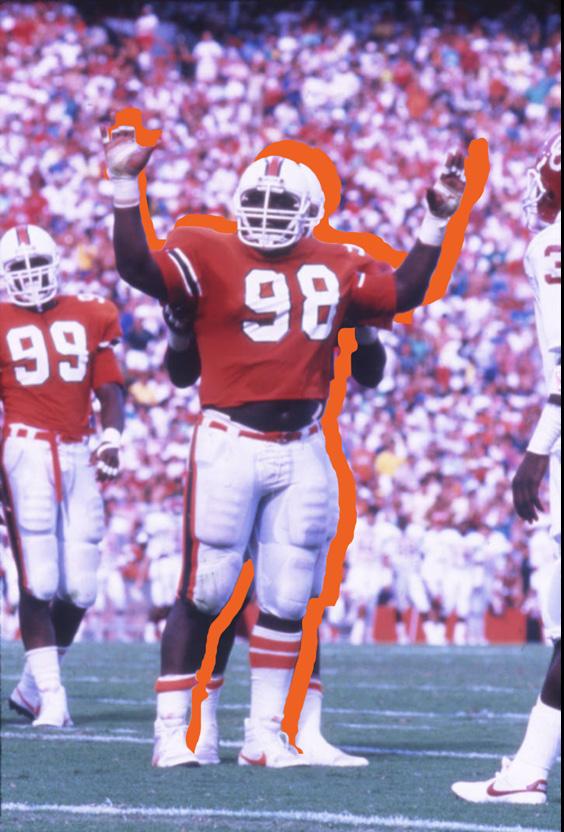
The Orlando, Florida. native was one of the best players in college football in the 1990s. Warren Sapp joined the ’Canes in 1992, changing his position from tight end to defensive tackle. That decision paid off, as Sapp made his presence felt in every game that he played. He took college football by storm in 1994, playing one of the greatest seasons ever by a defensive player. In his junior year, Sapp had 84.5 tackles and 10.5 sacks, earning the defensive tackle a slew of honors. In 1994, Sapp fnished sixth in the Heisman Trophy voting, won the Bronko Nagurski Trophy for best defensive player in the country and became the frst Hurricane to win the Lombardi Trophy. He fnished his Miami career with 176.5 tackles and 19.5 sacks, which got him drafted 12th overall in the 1995 NFL Draft by the Tampa Bay Buccaneers. Sapp was even more dominant in the pros, becoming a fourtime All-Pro and claiming the title of Defensive Player of the Year in 1999. In 2013, he was inducted into the Pro Football Hall of Fame.
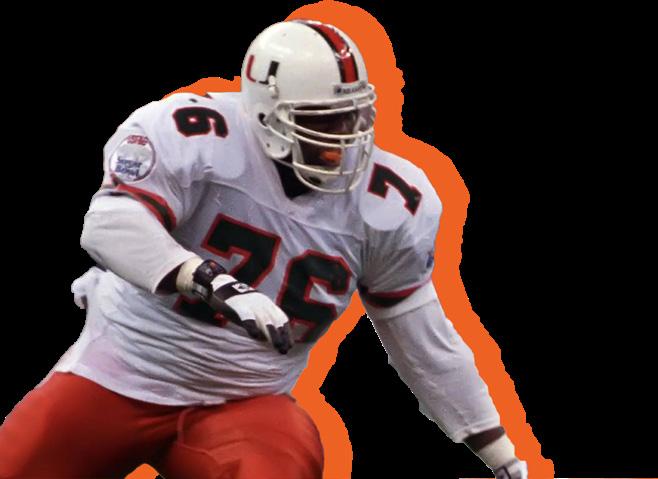
Defensive End
Ted Hendricks
By Sebastian Font
The clear choice for Miami’s all-time defensive end is both Pro and College Hall of Famer Ted Hendricks, especially considering the annual award for the nation’s top edge rusher dons his name. The 6-foot-7, 218-pound Guatemalan defensive end was a one-man wrecking ball on the defensive side of the line on his way to becoming a three-time All-American from 1966-68, the only Hurricane to ever receive the honor three times. He racked up 327 total tackles across his time at Miami and placed ffth in the Heisman Trophy voting during his incredible junior season in 1968, where he forced nine turnovers. Known as “The Mad Stork,” Hendricks continued his prowess in the pros, becoming a four-time Super Bowl champion, four-time First-Team All-Pro and an eight-time Pro Bowler. His number, 89, was retired at the university in 1997, forever immortalized in the rafters at The U.
Daniel Stubbs
The second choice for defensive end becomes much more complicated, but not due to a lack of talent. Stars like Calais Campbell, Greg Rousseau and Jerome McDougle all shined bright at Miami, but 1985–87 UM Sports Hall of Famer Daniel Stubbs just edges them out. During Stubbs’ years at Miami, he racked up a school record of 39.5 sacks and 139 assists, alongside 267 total tackles. He was unstoppable in his senior year, sacking the quarterback 17 times, which is a single-season record at UM. That same year, he became an All-American en route to becoming a national champion under Jimmy Johnson. In the pros, Stubbs continued to win, becoming a two-time Super Bowl champion during his 10-year career, which saw him tally up over 50 sacks at the professional level.
Kicker
Andres Borregales
By Jayden Gonzalez
With players like Carlos Huerta, Jose Borregales and Michael Badgley among the list of the greatest Hurricane placekickers, Andres Borregales, statistically, is the best kicker in the program’s history. Succeeding his brother, Jose, Borregales had big shoes to fll. In his freshman season, the Caracas, Venezuela native made all 45 of his points after touchdown attempts and went 17-for-21 for feld goals. Borregales ended his Miami career missing one extra point in his entire college career, going 183-for-184 and hitting more PATs than Huerta did in his four years. In 2024, Borregales passed Badgley for most points in UM history with 405. He has the best feld goal percentage in Miami history among kickers who played for four years at 86% and is second to Badgley in most feld goals made by a Hurricane kicker. In 2024 against Virginia Tech, Borregales nailed a 56-yard feld goal, his career longest? and third longest in program history, trailing Danny Miller and Jose Borregales, who both hit 57-yarders. Borregales fnished his illustrious career at UM as a two-time All-ACC placekicker, hitting his last 95 PATs and 17 feld goals.
Punter
Jeff Feagles
By Zach Cohen
Jeff Feagles gets the bid on the all-time team after three consistent years as the punter for the Hurricanes from 1984–87. Feagles, a member of the 1987 National Championship squad, booted 34 punts for a total of 1319 yards, averaging 38.8 yards per punt that season. In his career as a Hurricane, he punted 119 times for 4659 yards, averaging 39.2 yards a kick. His best season came in 1986, when he punted for 2100 yards. After his time as a Hurricane, Feagles went undrafted but got signed by the New England Patriots. In his 20th NFL season in 2007, he won the Super Bowl with the Giants. He retired in 2010. Feagles was inducted into the UM Sports Hall of Fame in 2008.
If you were to ask your average football fan to name a former Miami player at random, there is a good chance that Ray Lewis is the most common answer. Arguably the greatest inside linebacker in the history of the NFL, Lewis garnered 13 Pro Bowl selections, three Second-Team All-Pro selections, seven First-Team All-Pro selections and holds the record for most solo and combined tackles in a career and the most solo tackles in a season. He’s also a two-time NFL Defensive Player of the Year, two-time Super Bowl champion, Super Bowl MVP, 2000s All-Decade team honoree, member of the NFL 100th Anniversary team and Pro Football Hall of Famer. Lewis was also an unstoppable force while wearing the orange and green. While at UM, Lewis was named to the All-Big East team twice and was a Third-Team and First-Team All-American. During his junior year, Lewis notched 160 tackles, which is the second most in a season in Miami history, only behind Ed Weisacosky with 164 in 1965. When he left the ’Canes for the NFL, Lewis was ffth in career tackles for the Hurricanes, de spite playing in college for just three seasons. From the day Lewis stepped on UM’s campus to when he retired from the Baltimore Ravens in 2012, he was one of the most intimidating forces in football.

Choosing only two linebackers at Miami is a tough task. It is one of the most loaded positions for any program in college football. A lot of great names had to be left off this list. Morgan was a machine for the Hurricanes in the late 1990s. He set the Miami career record for total tackles with 532, including 309 solo tackles and 223 assisted tackles, both of which are records at The U. He led the team in tackles in three out of the four seasons he started. Of those four seasons, Morgan’s fourth and fnal season may have been the greatest by any defensive player for Miami in the pro gram’s history. In the 2000 campaign, Morgan won the Butkus Award, given to the country’s top linebacker, and the Bronko Nagurski Trophy. He was a unanimous All-American and First-Team All-Big East member, and he was the Big East Defensive Player of the Year. After a collegiate career like Morgan had, it is no surprise that he was inducted into the College Football Hall of Fame in 2021. Morgan is now the president of football operations and general manager for his former NFL team, the Carolina Panthers.
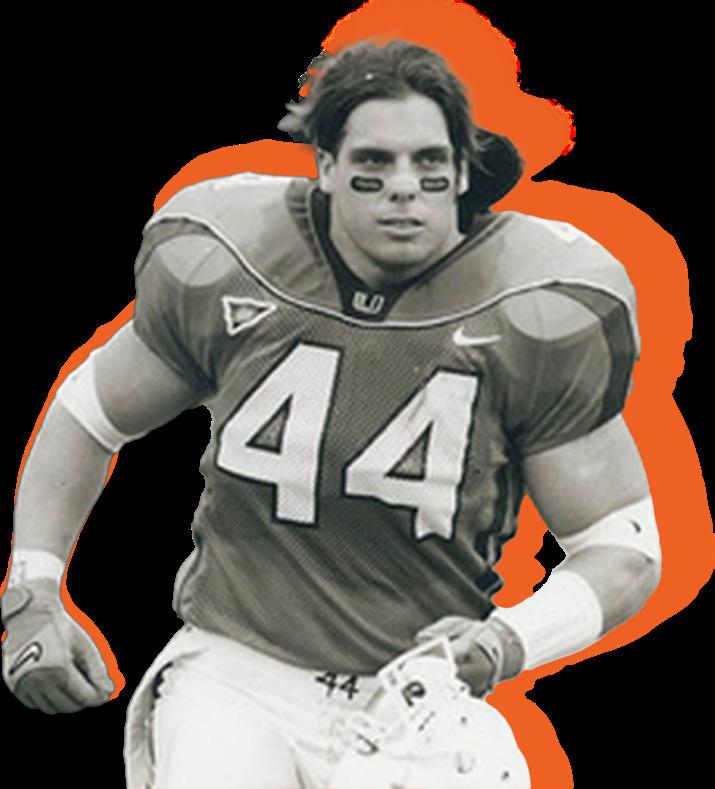
By Jayden
A track, baseball and football star at Lehigh Senior High School in Florida,, Phillip Buchanon declined a $500,000 contract to play baseball for the Cincinnati Reds. Instead, he opted to play football and run track at Miami in 1999. In 2000, the Fort Myers, Florida native became the starting cornerback following an injury to Leonard Myers. From that point on, Buchanon became one of the most dominant corners and return specialists in the Big East. As a member of the 2001 National Championship team, Buchanon was named to the First Team All-Big East and Second Team All-America, winning Big East Special Teams Player of the Year. Buchanon fnished his UM career with 88 tackles and seven interceptions, including two that he took to the end zone. As a return specialist, Buchanon was even more electric to watch, returning two punts for touchdowns in his three years at Miami. Buchanon showed off his track speed in the NFL Combine, running a 4.31 and tying the then-record for the fastest 40-yard dash. In 2002, Buchanon was drafted 17th overall by the Oakland Raiders, having a nine-year career in the pros. In 2020, the cornerback was inducted into the UM Sports Hall of Fame.
Coming out of South Dade High School as the best defensive back in South Florida, Antrel Rolle made his presence felt as a freshman on the 2001 National Championship team. The Miami native spent much of his freshman season on special teams and nickel and dime packages on defense before taking a starting cornerback spot in 2002. In 2002, Rolle earned First- Team All-Big East honors, tallying 66 tackles and two sacks. In his junior year, Rolle was a Third-Team All-American with 51 tackles and two interceptions, including a return for a touchdown. On special teams, Rolle returned one 66-yard punt for a touchdown. Rolle’s 2004 campaign won him the Jack Tatum Award, given to the best defensive back in the country. He was a unanimous All-American and a fnalist for the Jim Thorpe award. Rolle was drafted eighth overall in the 2005 NFL Draft by the Arizona Cardinals. In his pro career, Rolle was a three-time Pro Bowler and two-time Second Team All-Pro. He was an integral part of the New York Giants’ 2012 Super Bowl team. In 2019, Rolle was inducted into the UM Sports Hall of Fame.
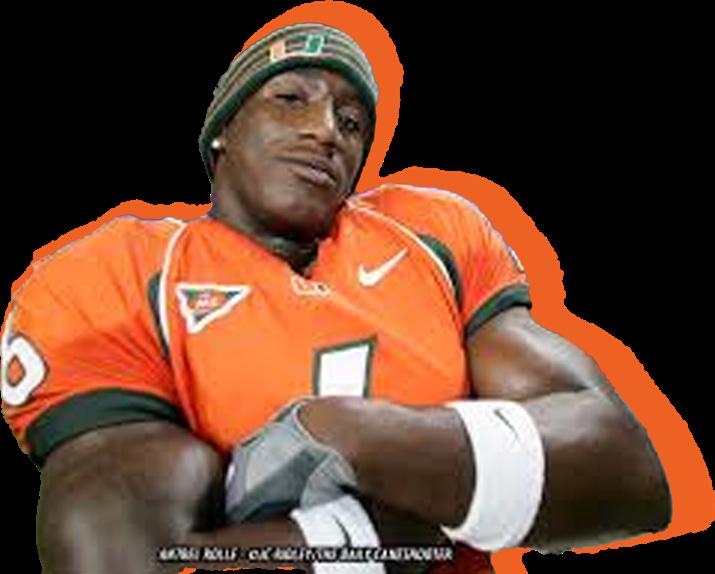
By Jayden Gonzalez
As one of the most dominant ball-hawking safeties in the history of college football, Ed Reed was arguably the best player on the historic 2001 roster. Born in St. Rose, Louisiana, Reed was a true athlete as a standout in both football and track and feld. At Destrehan High School Reed set school records in the javelin throw while also participating in relay races, as well as the long jump and triple jump. In 2000, during Reed’s junior year at Miami, the 5-foot-11 defensive back joined the track and feld team and participated as a jumper and a javelin thrower. As a football player, Reed will go down as one of the greatest Hurricanes ever. In 1998, Reed was a Freshman All-American, leading the team in interceptions with two and forcing four fumbles. Reed was elite at picking off quarterbacks and returning takeaways to the house. He fnished his Miami career with program records in interceptions and career touchdowns returned, with 21 and four, respectively. In 2001, Reed was a unanimous All-American, winning the Co-Big East Defensive Player of the Year honor and was a fnalist for the Jim Thorpe Award and a semifnalist for the Bronko Nagurski Trophy during Miami’s national championship season. Reed’s legendary UM career translated to the NFL, where he had a historic career with the Baltimore Ravens as one of the best defensive backs to ever play. In 2019, Reed was named one of the safeties on the NFL 100th Anniversary team. He was inducted into the UM Sports Hall of Fame in 2012, the College Football Hall of Fame in 2018 and the Pro Football Hall of Fame in 2019.
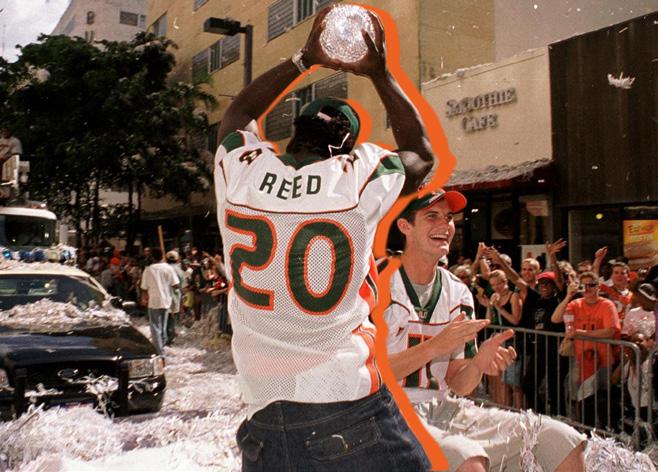
Another member of the 2001 ’Canes roster, Sean Taylor was one of four true freshmen to play, sharing the sideline with 37 other players drafted to the NFL. The defensive back joins Reed as one of the best players in the history of the Hurricanes. At Miami’s Gulliver Prep High School,, Taylor played basketball and football and ran track. On the gridiron, Taylor helped lead his team to the 2000 Florida State 2A Championship as a running back, linebacker and defensive back. Entering college, Taylor was ranked the best athlete in Florida. In his freshman year, Taylor carved a spot on the Hurricanes’ roster on special teams and in a reserve role and recorded 26 tackles. In 2002, Taylor replaced Reed, who left school for the NFL. In his sophomore season, Taylor was named Second-Team All-Big East, leading UM defensive backs in tackles, interceptions and passes broken up. In 2003, the Miami native put the college football world on notice and was named the Big East Defensive Player of the Year. He led the nation in picks and tied Bennie Blades for the most interceptions in a single season in program history with 10. He was a unanimous All-American, winning the Jack Tatum Award in his junior year. The 6-foot-2
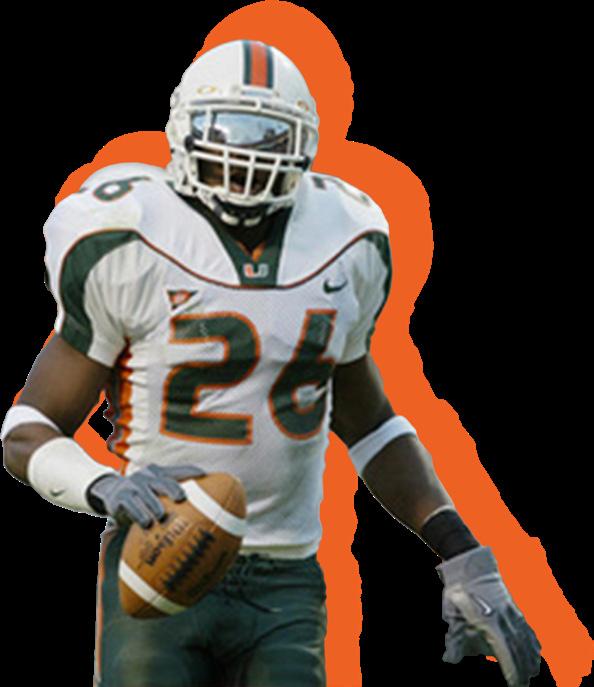
In honor of the University of Miami’s centennial celebration, the Miami Hurricane staff compiled a list of ten of the school’s greatest athletic moments. From all-time seasons to awe-inspiring plays, these ten moments capture some of the most memorable and electrifying moments in Miami Hurricanes history.
2001 Football Season
Greatest. Team. Of. All. Time. 2001 was the year the ‘Canes did it all: a perfect 13-0 season, a dominant BCS National Championship Game win over Nebraska and a roster stacked top-to-bottom with all-time greats. There’s not much to say about this team that hasn’t already been said, so here are a few numbers to show just how special that team was.
6 - The number of All-Americans on the team
17 - The number of future frst-round draft picks on the team
38 - The total number of NFL draft picks on the roster +372 - The team’s point differential in 13 games
8-4 - The team’s record if the offense never scored a touchdown
By Wrigley Kordt
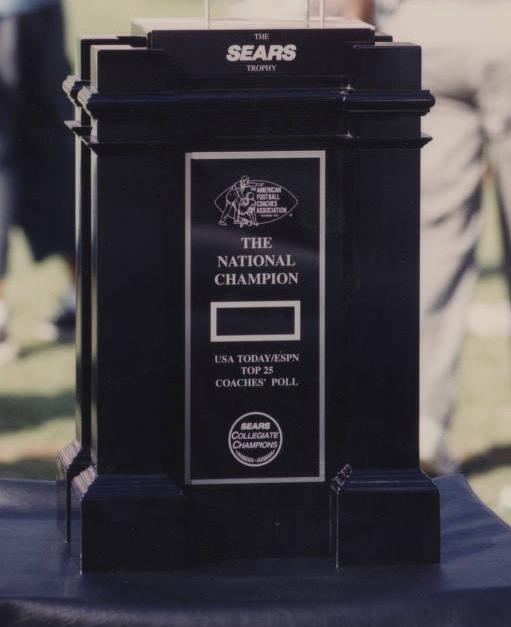
By Sebastian Font
The Miami Hurricanes and Florida State Seminoles have one of the most intense and historic rivalries that are enshrined in the memories of both universities and college football fans as a whole. But not once, not twice, but three times against FSU a missed feld goal to the right ensured Miami wins.
First in 1991, the No.2 ranked ’Canes led 17-16 against the No.1 ranked Seminoles in Tallahassee. At the time both teams were undefeated, and with hopes of national championship contention on the line, the game was even more tense than usual. And following a Hurricane touchdown with 3:01 remaining to take the lead, all the pressure rested on FSU. The Seminoles drove down the feld to the 18-yard line, leaving kicker Gerry Thomas with a 37-yard feld goal to win the game with 29 seconds remaining. Thomas was 3-for-3 on the day, and all hope appeared lost for the ’Canes as the kick went up, but as the title suggests it missed wide right, by the length of a football.
“The snap...it’s up...missed it to the right! Miami players are all over the feld. They’re going to get penalized for it, but So what,” said announcer Keith Jackson.
Just a year later in 1992, wide right struck again. Both teams were again undefeated as they entered the Orange Bowl, and after the destruction of Hurricane Andrew Miami fans were seething at the mouth for something to cheer for. With 1:35 left, the Seminoles drove 57-yards down the feld to leave a 39-yard feld goal with 19 seconds remaining. Both sets of fans were on their feet, ’Canes fans praying for a repeat of last year and Seminole fans praying for anything but a repeat of last year. Miami’s fans had their prayers answered as FSU kicker Dan Mowry missed wide right, collapsing face-frst into the turf as the Orange Bowl erupted in cheers. It took another eight years to get another iteration of the “wide right” series. Miami had actually lost seven of those last eight games against FSU, and the Hurricanes were desperate to get one back over their rivals. After a Ken Dorsey led drive ended in a Jeremy Shockey touchdown, the ’Canes led 2724 with little time remaining. And just like the ‘91 and ‘92 contests, FSU drove down the feld leaving their kicker Matt Munyon with the opportunity to be a hero from within 50 yards. Many Seminole fans wondered “Will third time be the charm?” Thankfully the answer was no. The kick sailed right and was forever etched into the history books as “Wide right III”.
“It’s wide right, the ’Canes win!”
Men’s Tennis Streak of All Streaks
137 games, from 1957 to 1964, that is the eight seasons of absolute dominance that the Miami Hurricanes men’s tennis team displayed. Having stood for nearly 60 years, the run featured 9 All-Americans and two ITA Hall of Fame coaches to create an untouchable legacy in Miami sports history.
The run started in the third game of the 1957 season after the Hurricanes dominated Presbyterian 7-2. Powered by All-Americans Davd Harum and Johann Kupfenberger, Miami would fnish out the season rattling off the frst 20 wins of their historic streak.
What makes the streak even more impressive is that it comes right after a 72-match win streak that ended when Miami lost its second game of that 1957 season. So for over a decade, the ‘Canes had the most dominant team in sports history with just a single loss compared to 209 wins.
The charge throughout it all was led by two men who, throughout different rosters and different talents, were able to stack wins to create this run of excellence. Miami’s frst 20 were the last 20 of ITA Hall of Famer Bill Lufer, who coached the ‘Canes through their 72-game win streak as well. After his 9 years with the Canes, Lufer held an outstanding record of 148-2-1 and was inducted into the UM Sports Hall of Fame. The next 117 games, though, were led by Dale Lewis as he opened his career with the Hurricanes to earn his spot in both the ITA and UM Sports Halls of Fame.
By Brendan Cafferty
In 2015, despite a disappointing season, the Miami Hurricanes football team accomplished a program-defning comeback with zero seconds left on the clock against #22 ranked Duke. After receiving a squib kick from the Duke 35 yard line, the ‘Canes kickoff team executed a perfect string of laterals to fnd open feld on their sideline, taking the ball from the initial reception, being pushed back all the way to their own three yard line, until eventually Corn Elder trailed a line of blockers, weaving to open feld for the fnal dagger ending the game 30-27. The importance of this comeback was representative of more than just a gritty win, as after the fring of coach Al Golden following a 58-0 loss against Clemson, the team was playing with interim coach Larry Scott. Tragedy also struck cornerback Artie Burns, who after losing his mom was rallied around by his team. Former Miami receiver Tyre Brady said, “Before we took the feld in that game, we were playing for Artie Burns. We wanted to do it for him. We made a promise to each other we were going to win that game. That game was dedicated to her.” This win brought the ‘Canes to a bowl game and left a forgettable season with a historic moment in Miami football history.
On March 4, 2014, the Miami Hurricanes baseball team took on the Villanova Wildcats for a midweek showdown in the 3-0-5. At the time, Hurricanes’ head coach penciled in the big 6-foot-4 227 227-pound righty, Javi Salas. Salas was having his best season in his senior year with the Hurricanes, ending the year with a 2.92 ERA.
Little did Salas know that March 4th, 2014 was a night he would never forget and go down in the history books.
The six-win fve fve-loss Hurricanes were looking to get back on track against the struggling two-win eight-loss Villanova team.
Salas would shove in the frst three innings of the game, allowing his teammates to do their thing offensively. Miami would take a 4-0 lead in the bottom of the third inning thanks to a two-RBI single from freshman Willie Abreu.
The Miami bats would keep on teeing off against Villanova pitchers while Salas was still dealing allowing no hits, no walks, and no batters on base through six. When Salas got back to the dugout in the sixth inning of work his teammates gave him the silent treatment in superstition.
“I got back in the dugout and I was kind of isolated and no one was talking to me,” he said. “That’s when I realized what I had going. I had a couple of 3-1 counts there that I was hoping I didn’t walk a guy. I had to keep my approach and stay aggressive going after these guys. Luck had it for me today.”
In the top of the 8th Salas would throw his 100th pitch, and fnish that inning still perfect. Jim Morris knowing Salas was three outs away from history kept him in the game. On the 113th pitch of the night with two away in the ninth Salas struck Derrick May Jr to complete his perfect game.
“That night was all the stars of my baseball career aligning. I felt like that night affrmed my decision to attend the University of Miami. All my family in the stands, my brother in the radio booth, my friends arriving once they realized what was happening, it was indescribable,” Javi Salas said to The Miami Hurricane.
Salas would throw the second perfect game in Miami history and the frst since Kevin Sheary did it in March of 1987. Salas became the 23rd pitcher in NCAA Division 1 history to throw a perfect game since 1957.
The captain would turn the 2014 season around and lead his team to a 37-25 record as their season would end in the super regionals in Louisville, Kentucky.
Salas has always been thankful for his time in the orange and green, “All these years later, it’s a great memory for my family. I was blessed to have the opportunity to play for the Hurricanes. I’m forever grateful to Coach Morris and Coach Arteaga.”
By Shea McDonald
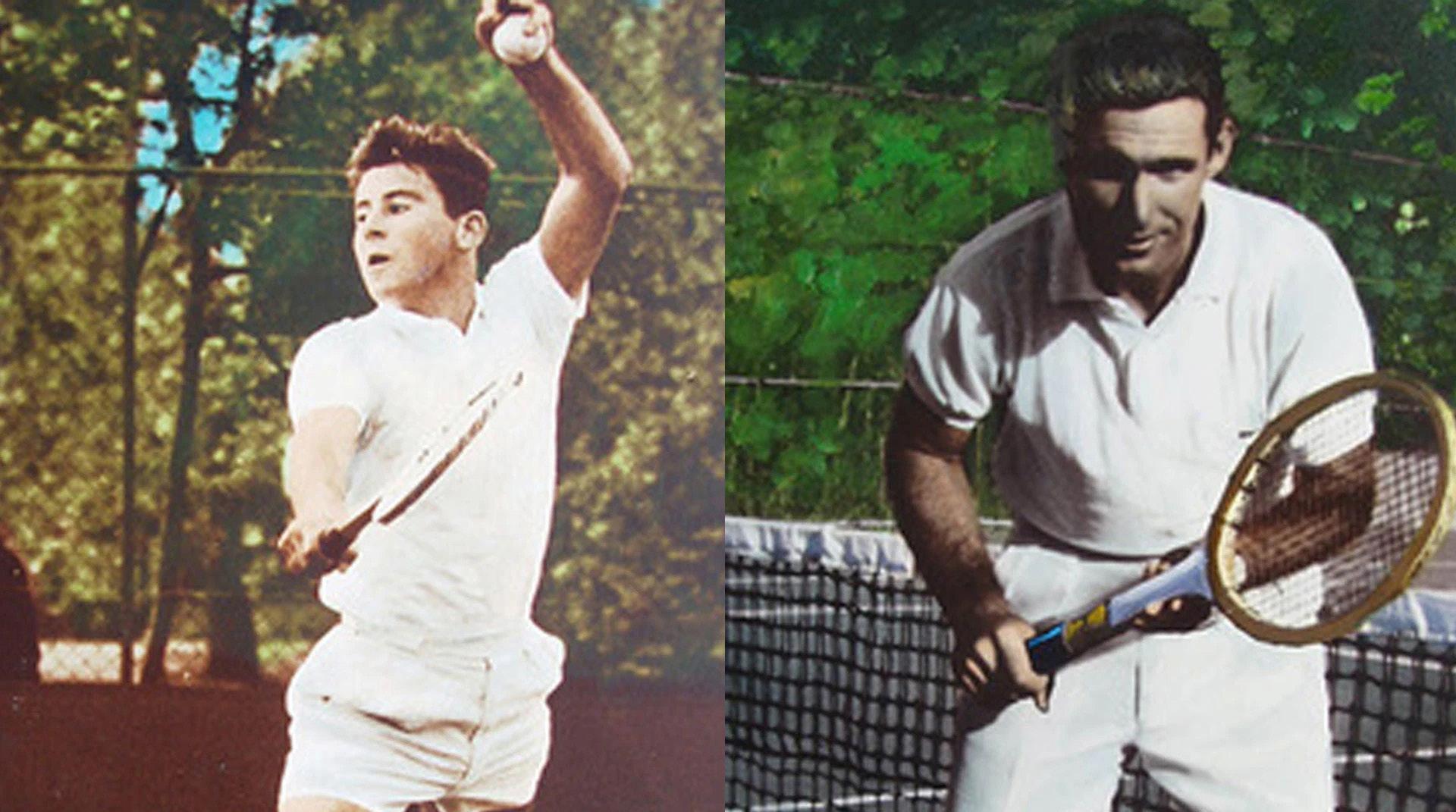
On the court, Miami had its fair share of stars as well; every year throughout the streak, the ‘Canes had representation on All-American teams. Jerry Moss, a captain in 1959, was a two-time All-American who earned a 70-1 record. Rod Mandelstam was a three-time All-American. In his frst year in 1961, he, alongside partner John Karabasz, took home the NCAA Doubles Championship. And eventual ‘Canes Hall of Fame Tennis Coach John Hammil was a star for Miami during his time on the court. All throughout, individually
tennis, and that 137-game streak will forever be remembered as a testament to it.
January 2, 1984, Miami, FL, in the Orange Bowl, Tom Osborne’s No. 1 Nebraska Cornhuskers (12-0) came to town to face Howard Schnellenberger’s No. 5 Miami Hurricanes (10-1). Due to the No. 2 Texas Longhorns losing to No. 7 Georgia Bulldogs earlier that day, this game would effectively decide the 1983-84 national championship.
The two sides could not have been more different. The Cornhuskers seemed to have the advantage in almost every department apart from location. At that point Nebraska was already considered a top program with two championships in the early seventies. They looked to add a third that night as they came into South Florida with an undefeated record, a Big Eight championship, and one of the greatest offenses in college football history led by that year’s Heisman winner, running back Mike Rozier. It was no surprise that the Cornhuskers were widely considered to be the favorites of the match-up.
The Hurricanes were not considered to be a powerhouse or even a solid program around the late seventies and early eighties, in fact shortly before head coach Howard Schnellenbeger was hired in 1979, the program was almost disbanded entirely. Using his “State of Miami” recruiting plan, Schnellenger was able to change that narrative in his fve seasons at the helm. The 1983 Miami season was the strongest of any UM football season in history at that point in time. It started off with a bump, losing their opener in Gainesville to the Florida Gators, but led by redshirt freshman quarterback Bernie Kosar, all-american tight end Glenn Dennison, and all-american linebacker Jay Brophy, the ’Canes won their next ten straight games, including wins against Notre Dame, West Virginia, and
but they aimed to rewrite the narrative.

As for the game itself, the ’Canes got off to a hot start, dominating the frst quarter, 17-0, on both sides of the ball, including
and an interception by linebacker Jack Fernandez. Dennison also had a strong frst quarter with two touchdown receptions.
The Cornhuskers fought their way back in the second quarter scoring two unanswered touchdowns, the frst
award winning offensive lineman, Dean Steinkuhler, to run into the endzone. After Nebraska notched
plays such as a
in the frst drive of
Comeback Keeps Championship Hopes Alive
By Shea McDonald
On their way to their second national championship, Miami faced off against their biggest rival in a battle of two national contenders. With 63,000 fans packing Doak Campbell Stadium to a record amount, the number 3 ranked Hurricanes took on the number 4 ranked Florida State Seminoles in a matchup to decide who would stay in the running for the national championship. The star-studded matchup featured Michael Irvin and Deion Sanders battling on opposite sides of the ball in a game that, like so many others in this storied rivalry, came down to a single play.
Miami quickly fell into a hole as Florida State pounded the rock with Sammie Smith, who went for 178 yards on the ground. Miami’s offense, led by sophomore QB Steve Walsh in his third-ever start, couldn’t get anything going outside of a single feld goal. Down 13-3 early in the second half, things only got worse for the Hurricanes as a blocked punt resulted in another Seminole touchdown, and just like that, the ‘Canes were down 19-3. Things would have been worse for Miami had Florida State not suffered from several special teams errors. A botched snap on a feld goal, two other missed feld goals by kicker Bobby Schmidt, and a missed extra point following the defensive touchdown kept the door open for Miami, and the ‘Canes would walk through it.
The Canes’ comeback started with a Steve Walsh dart down the seam to running back Melvin Bratton. Bratton caught the ball in stride and sped past FSU defense for a 49-yard score. Walsh then threaded the needle on a fade route to Brian Blades to convert for two, and just like that, Miami was down just a score.
As the fnal seconds of the third trickled down, the Hurricanes sideline held up four fngers as part of an iconic gesture signifying their drive to dominate the fourth.
Up 19 to 11, Florida State’s offense marched down the feld seemingly to put away the game. But as they attempted a screen pass, quarterback Danny McManus was pressured and threw the ball right into the arms of All-American defensive end Danny Stubbs. Soon after Walsh connected on another deep shot, this time up the seam to Michael Irvin for a 26-yard score, and after converting again, Miami tied the game up at 19.
Florida State moved the ball with ease again but, faced with a fourth-and-one, opted to kick and was punished for it as Schmidt missed for the second time in the second half. Miami stalled out on their drive, and Florida State began moving the ball again, but a fumbled snap gave Miami the ball back with just over three-and-a-half minutes left to play. Miami soon found themselves close to another shortened drive, and with the way Florida State moved the ball, it could have been the last time Miami was on offense. Third-and-seven, game on the line, Walsh would drop back and fre to the right sideline. Michael Irving, who claimed he was supposed to run an out route, saw the coverage and communicated with Walsh that he was going for it all. As the ball split the safety and the trailing cornerback, “The Playmaker” hauled it in for a 73-yard touchdown to give Miami the lead.
The Seminoles refused to go away and moved their way back down the feld. A 30-yard leaping grab by running back Dexter Carter over a defender was followed up by a 17-yard touchdown strike on a fade route from McManus to receiver Ronald Lewis. And just like that, the Seminoles found themselves down by a single point. Seminoles head coach Bobby Bowden, burned by special teams so many times and with no overtime in college football, made the decision to go for two. He sent McManus back to pass one last time, but throwing into a sea of defenders, he was unable to convert. Miami would hold onto their one-point lead and move to 3-0 on the season and 18-13 in the rivalry matchup.
The game was one of three single-digit games the ‘Canes faced all year, 3-0 as they marched to their second national championship
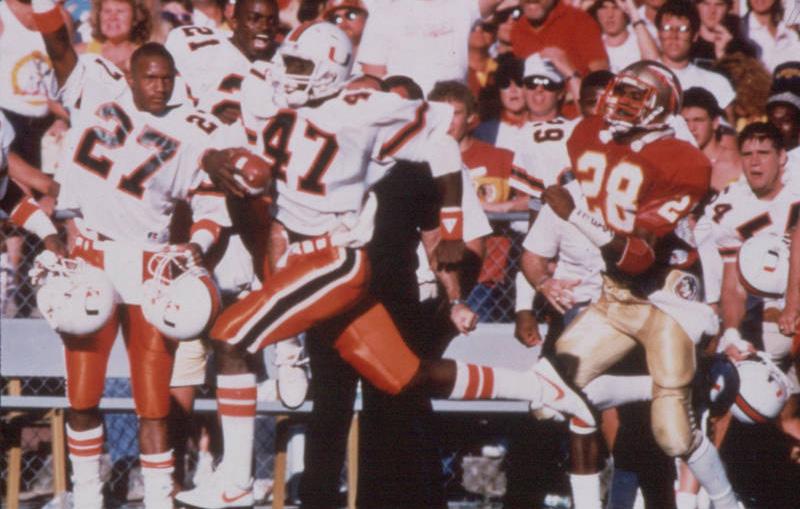
The ACC’s past, present and future: Where does Miami and the ACC stand in conference realignment?
By Wrigley Kordt Sta Writer
It’s the era of realignment in college athletics.
The Big Ten is up to 18 teams. The Atlantic Coast Conference has two California schools. The Pac-12 is in the conference equivalent of a rebuild. Needless to say, the college sports landscape has changed drastically over the past decade, and it doesn’t seem like it’s slowing down anytime soon. So what does this all mean for Miami and, as well as the ACC? As the University of Miami celebrates its centennial and the ACC approaches its 75th anniversary, let’s take a look at the pairing’s past, present and future.
The past: Independence, the Big East and a move to the ACC For much of its history, the University of Miami operated without a conference. The school joined the Southern Intercollegiate Athletic Association in 1929 and remained until the conference collapsed at the onset of American involvement in World War II. But Miami stayed independent for the following half-century. It wasn’t until 1991 that Miami, already having won three football championships, joined the Big East. At the time, the Big East was considered a Power Six conference and hosted a bevy of future ACC teams. In their frst Big East season, the ’Canes won their fourth football National Championship. Miami, along with Virginia Tech, left the Big East to join the ACC in 2004. Both schools were football juggernauts at the time, making them crucial additions to the conference. Boston College followed suit the following year, bringing the ACC up to 12 teams. In 2013, the conference expanded again, adding Pittsburgh and Notre Dame, though the Fighting Irish remained independent in football. The next year, Maryland left for the Big Ten and was replaced by Louisville. Those 14 teams made up the conference for the next decade.
The present: The two-coast ACC and the lawsuit that defnes it Last season, Southern Methodist, California and Stanford joined the ACC, the latter two as part of the Pac-12’s mass evacuation. The additions brought the ACC up to 18 member schools, tied with the Big Ten for the most in the Power Four. However, Notre Dame’s continued football independence means the ACC only has 17 football teams. As the conference ballooned, two key members –Florida State and Clemson – sued the conference in late 2023 and early 2024, respectively. A primary point of contention was a revenue gap, or lack
The University of Miami has long been known as a football school, but thanks to a magical 2022-23 season from head coach Jim Larranaga’s men’s basketball team, that reputation changed, if only for one season.
The Hurricanes were dominant at home, boasting a 17-1 record at the Watsco Center. That included a win against Pittsburgh to secure the program’s second ACC regular-season title.
Despite the strong regular season, the ‘Canes ducked out early in the ACC tournament, leading to concerns about whether the team’s defensive shortcomings and lack of size would lead to an early exit in the NCAA tournament. Those worries were exacerbated by a narrow victory over 12-seed Drake.
But then Miami went on a scorching-hot run, thanks in large part to a roster that featured, in the words of CBS analyst Jon Rothstein, “more guards than Shawshank.” Strong scoring performances from guards Isiah Wong and Nijel Pack propelled the team to wins over four-seed Indiana and oneseed Houston. Forward Norchad Omier turned into a glass-cleaning machine, grabbing a combined 30 rebounds in those two games.
The team’s Cinderella magic seemed to be running out halfway through an Elite Eight matchup against two-seed Texas. Miami trailed by 13 points in the second half before mounting a gritty comeback. Jordan Miller became the hero of that game — and of the season — with a 27-point performance that included perfect 7-7 shooting from the feld and a 13-13 mark from the freethrow line.
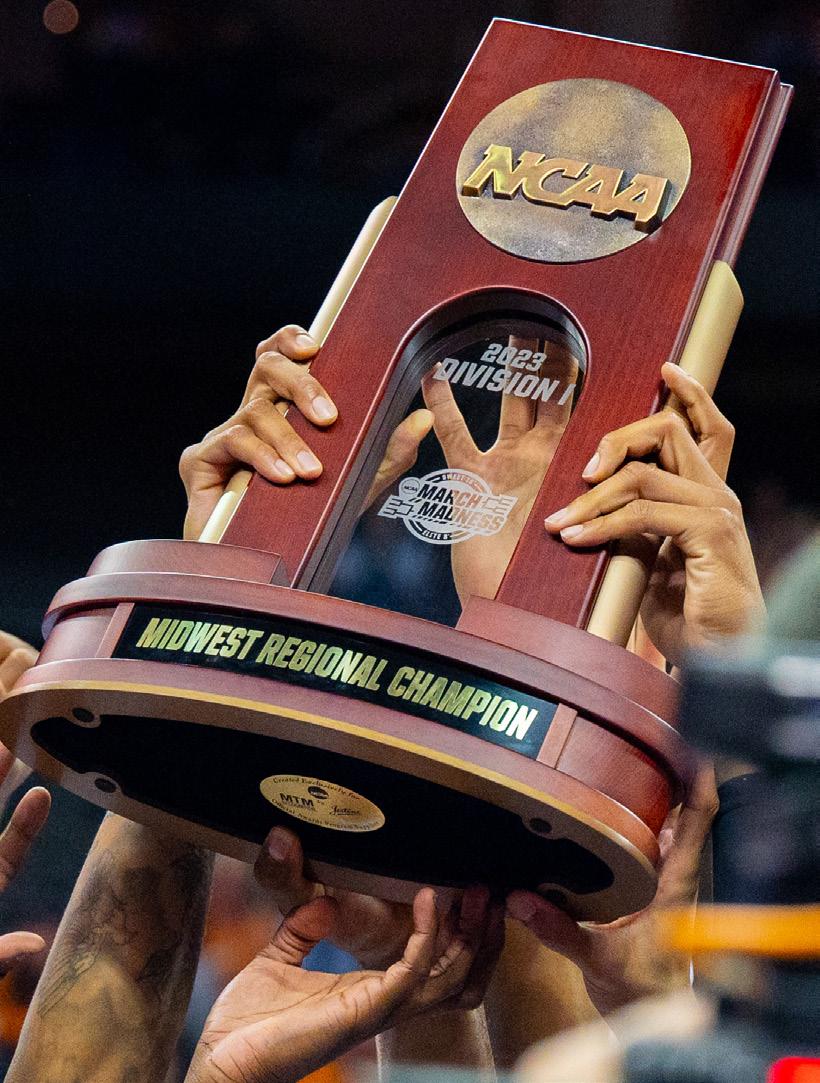
up the
following
March
Miller’s heroics took the ‘Canes to Houston for the frst Final Four appearance in program history. And although the next game ended in heartbreak — Miami lost to UConn in a game that felt much further out of reach than the 59-72 fnal score would suggest — the team’s electrifying run in the Big Dance solidifed their status as the best basketball team in school history.
Sarah Landau
One of the most notable accomplishments for Miami Women’s Basketball was their incredible win over Villanova in the 2023 NCAA March Madness Tournament that took the ’Canes to the Elite Eight. Following an impressive 22-13 overall season record (11-7 ACC), the Hurricanes used their momentum to propel them into March Madness and reach the Elite Eight for the frst time in women’s program history.
To kick off their tournament play, #9 ranked UM faced a ferce #8 Oklahoma State and barely pulled out a 62-61 win. While Miami held on to its opponent in the frst quarter, it fell apart as the half came to a close, digging themselves into a 17 point defcit that they would have to spend the rest of the game coming back from.
In their second round, the Hurricanes continued their play with a close-call upset win over #1 ranked Indiana, solidifying their stance as a threat in the tournament. This game took a different spin than their frst round in the sense that Miami had a solid lead for the frst half of the game, but they secured the win with a jumper by Miami forward Destiny Harden with four seconds remaining on the shot clock.
Miami’s performance against Villanova in the third round of March Madness was the largest-lead win of their tournament run. In yet another upset, the ’Canes, led by Jasmyne Roberts and Harden, shut down the Wildcats 70-65 in an action-packed game. While Villanova’s Maddy Siegrist played a key role in keeping the game tight with her 31 point performance, Miami’s offensive threats gave them just enough power to overthrow the Wildcats.
While Miami ended its March Madness journey with a 54-42 loss to the LSU Tigers (who went on to win the entire 2023 tournament) in the Elite Eight, the team put up a valiant effort and made a signifcant name for the program and the university as a whole.
Before football was a powerhouse, The Rock repped the U, and Isaiah Wong led the ’Canes to a Final Four, Miami was a baseball school. It all started with head coach Ron Fraser, also known as the “Wizard of College Baseball”, who built a program, which did not even offer scholarships the frst 10 seasons of his tenure, to a regular attendee in Omaha.
Fast forward to 1982, when the Hurricanes won their frst ever baseball championship against the Wichita State Shockers. The squad was led by players such as pitcher Danny Smith, catcher Nelson Santovenia and outfelder Doug Shields. The ’Canes cruised through the postseason as they did not drop a single game, going 8-0.
thereof, in the conference. As the Big Ten and SEC saw greater disparities between their bigger and smaller brands, the ACC continued employing a relatively equal model of distribution. In addition, ACC schools signed away control of their media rights to the conference until 2036. Programs looking to make an early departure faced hefty exit fees. The parties came to a settlement in early March, loosening tensions between the two schools and the ACC.
The conference adopted a new revenue-sharing model, rewarding schools with higher TV viewership. But the biggest news out of the settlement was arguably the conference backing down on its exit fee policy. While the original fee was reportedly north of $500 million, the new agreement cuts that number down to a relatively manageable $165 million through the fscal year 2026. From there, the fee declines each year until plateauing at $75 million after 2030.
That last part is a signifcant win for Florida State and Clemson, along with other programs looking to exit the conference in the coming years, which leads us to…
The future: The inevitability of 2031 and Miami’s piece in the puzzle 2031 will be a crucial year, not only for the future of the ACC but for the future of college sports as a whole. As previously mentioned, the ACC’s exit fee falls to a reasonable $75 million that year. That date coincides with the Big Ten and Big 12’s media deals, which expire in 2030 and 2031, respectively. 2031 provides a wide-open exit window for schools frustrated by ACC leadership, specifcally Florida State and Clemson. Geographically, neither school fts nicely in both the Big Ten and the Big 12, but the same could have been said about the former Pac-12 schools that joined the Big Ten this past season. A departure for the Big Ten could make sense for big-name ACC schools frustrated by the conference’s relative lack of TV revenue. The Big Ten inked college football’s most lucrative media rights deal to date, a seven-year, $7 billion pact with Fox, CBS and NBC. That number vastly outperforms the SEC’s 10-year, $3 billion agreement with ESPN. However, conference alignment is about more than money, even if it’s mostly about money. Florida State and Clemson’s biggest rivals reside in the SEC, which could make a move to that conference more logical.
This, of course, all depends on the conferences wanting Florida State and Clemson. Reports surfaced in the midst of the lawsuit last year that both the Big Ten and SEC were reluctant to add Florida State, barring a complete collapse of the ACC. So where does Miami ft in all this? Despite not fnishing in the top 10 of the AP pPoll since 2003,
While the actual championship game was a 9-3 victory over the Shockers, the most memorable moment of the 1982 College World Series and one of most memorable moments in the history of college baseball came in another game against the Shockers a few days earlier in the second round of the CWS: “The Grand Illusion.”
In the sixth inning of the game, Wichita State star Phil Stephenson was standing at frst. Hurricanes pitcher Mike Kasprzak stepped off the rubber and seemed to have attempted a pick off at frst. Stephenson dives back to frst, but his luck was in as frst baseman Steve Lusby dove as it seemed the pick-off went wild. In a pandemonious display, Lusby started to run down the frst base line looking for the ball, players in the Miami dugout were pointing over to their bullpen as if the ball had gone down there. In this mess, Stephenson starts to run over to second as what he thinks is a free base to move over. While everyone in the ballpark, including the announcers and Stephenson, are trying to fnd where the ball is, Kasprzak throws the ball over to shortstop Bill Wrona. Kasprzak had the ball the entire. The Hurricanes managed to pull a magnifcent display of baseball, planning and acting to bring the phantom ball to life that shocked both fans and Wichita State. The ’Canes went on to win the game 4-3 and then won the following three games to win their frst CWS.
To this day, “The Grand Illusion” is one of the memorable CWS moments in history, even being ranked third in a top 25 list by Yardbarker in 2024. “The Grand Illusion” is one of the many fun occurrences that makes us love sports and it also helped pave the way for Miami’s 1982 baseball championship.
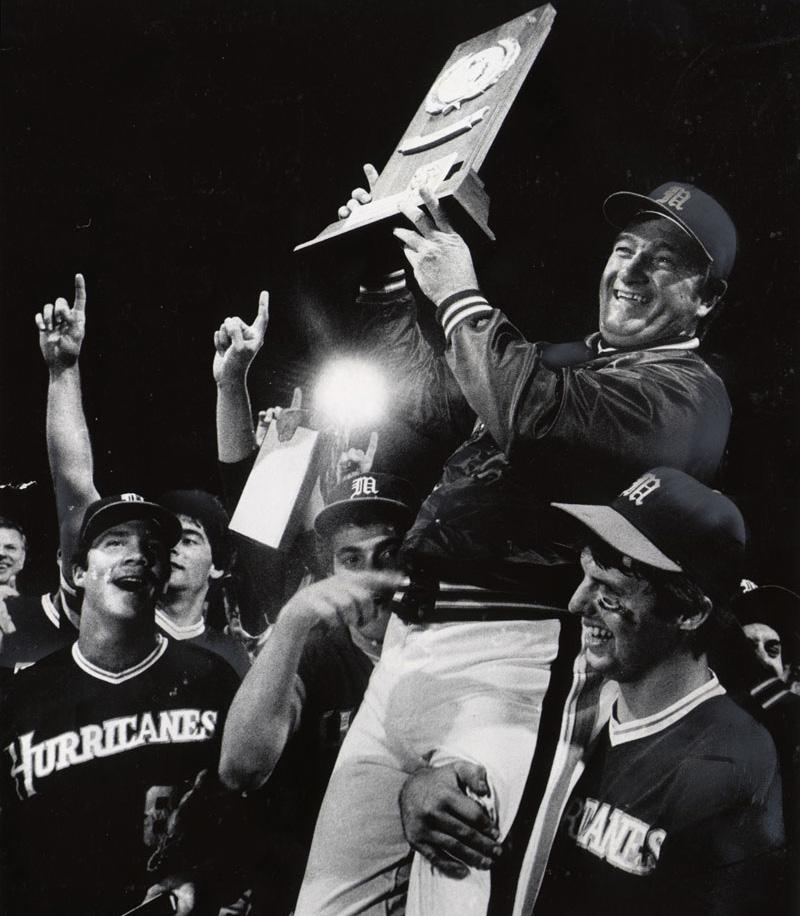
“The U” remains one of college football’s biggest brands. If the Hurricanes ever decide to jump ship, they’ll almost certainly have their fair share of suitors. That being said, UM Athletic Director Dan Radakovich has shown no inclination toward leaving the ACC, instead reaffrming his commitment to the conference during the Florida State-ClemsonACC legal battle. Long story short, the ACC is safe, at least for now. Barring a drastic move, the conference’s biggest disruptors will remain in the conference until at least 2031. As that year gets closer, perhaps realignment buzz starts up again. Either way, it’s highly unlikely that the ACC undergoes a single-season exodus on par with the Pac-12.
Realignment’s ripple effects The realignment discussion typically starts and ends with football. From a fnancial perspective, this makes sense. Football drives the vast majority of college athletics revenue, especially at the Power Four level.
But the NCAA isn’t just about business; it’s about supporting college athletes. And realignment affects every sport, not just the bigger names. As humorous as it is to talk about Pacifc Coast
teams in the Atlantic Coast Conference, the harsh reality of realignment is that it creates all sorts of travel problems for smaller programs. For instance, Stanford women’s volleyball had to travel to Florida for a weekend of road matchups against Miami and Florida State. That’s 6,000 miles round trip. In total, the team traveled over 25,000 miles last season for conference play alone. Conference realignment is inevitable as college sports fall further down the business rabbit hole. But barring a drastic change of heart, dozens of sports – along with the athletes who compete in them – are bound to slip through the cracks. The can of worms can’t be closed; all schools can do now is take further steps toward supporting their non-football programs, but with more realignment in the not-so-far future, it feels as though non-football athletes have become an afterthought in the name of proft. With a brand as big as Hurricanes football, the University of Miami is almost certainly safe from falling into athletic obscurity as conferences continue to consolidate. Schools like Miami will determine the direction of college athletics’ future, and it’s their responsibility to make sure that other sports aren’t left in the dark.
V’s Take is The Miami Hurricane’s most controversial and longest running column.
V’s Take is a satirical work published biweekly by students and for students using our generation’s “colorful” language. V addresses all things love, sex and gossip on campus. V is not for the politically correct or easily offended.
Do you think they’ll ever notice me?
The centennial is here and campus is buzzing with ’Canes, past and present, reminiscing on a century of memories at the U. I was going to stir the pot this week, but, just in case, I’ll reel it in this time around and keep things cordial.
Something about these celebrations do have me spiraling just a little. Suddenly, I’m thinking about how I will look back on my college days in a few years. When else will we be surrounded by people the same age as us? And even worse, where will all my campus crushes go? And what if he was the one?
Now, you’ll have to find some new fac-
es on your post-grad commute to and from work, but I can’t blame you if the nostalgia starts hitting and that one guy who sat three rows in front of you in Business Law still creeps into your mind sometimes. While some might think it best to let the past die and find some new objects of affection, don’t despair just yet. If you’ve been pining from afar (or three rows back), soon it will be time to make your move. Social media is a wonderful tool, and you can use it to check in on all of your past heartthrobs like little tamagotchis. It can’t hurt to check out their feed once in
a while, like a post here and there. If you’re feeling ever so adventurous, like one of their Instagram stories.
Who knows maybe you’ve been floating around in their mind too. It’s a perfect set up for the Hallmark movie plot of your dreams. All you need is a lawyer job, a failing café and for it to preferably be Christmas time, too. Complex, but to be fair we’ve probably schemed worse things up just for a little physical touch.
And if that leads to a reunion and a romance? Even better. That’s not just love, that’s a legacy family loading.

